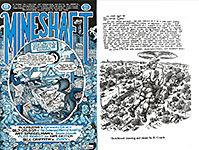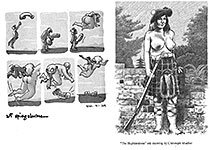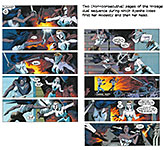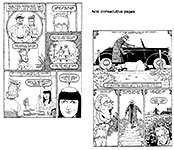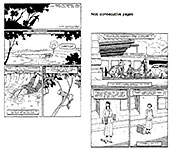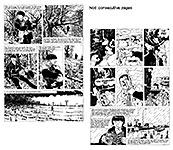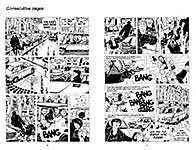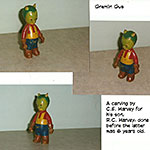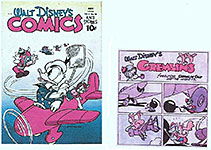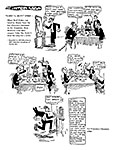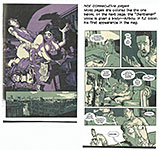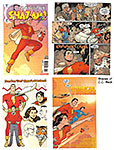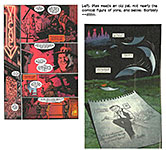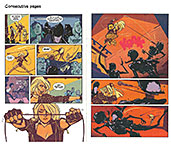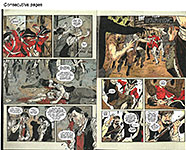 |
|||||||||||||||||||||||||||||||||||||||||||||||||||||||||||||||||||
Opus 342 (July 31, 2015). It’s still our annual Open Access Month. All the usual $ubscriber walls and barricades are down, and you and anyone in your family (or neighborhood) (or country) can peruse all of Rants & Raves (including archives—sixteen years’ worth!) at leisure without having to pay a fee. If you’ve just dropped in for a visit during our Open Access Month, here’s what we do here. We talk about comics. Comics and cartooning. We love comics and cartooning and we express that abiding affection by talking about them. Sure—we report news about comics and review new funnybooks as well as serious tomes that ponder the medium and we take notice of whatever earth-shaking events are shaping the history of cartooning. And, yes, we criticize comics, denominating some efforts good and excellent; others, not so good (even bad). But these efforts are merely excuses, feeble rationales. Our real purpose here—why we do this—is purely self-indulgent: we love cartooning and talking about cartooning in all its static forms—comic books, strips, editorial cartoons, comic books and graphic novels. And that’s what you’ll find here. Talk about all these manifestations of cartooning. Liberally illustrated talk, as you’ll soon see. Until August 15, you can join us in hoppin’ down the bunny trail where, this time, we report on the 2015 San Diego Comic-Con, the New Archie, the return of Opus, a new Seuss book, Marvel’s Secret Wars, plus reviewing Rowland B. Wilson’s Trade Secrets and The People Inside (a poetic graphic novel), a new Hirschfeld book, Wagner’s failed revival of Eisner’s Spirit, the month’s editorial cartoons and glimpses of the Peanuts Tribute. And if you like what you find there, consider joining us as a $ubscriber for merely $3.95/quarter after an initial $3.95 introductory month fee. Here’s what’s here, in order, by department—:
Copy-Catting: When It’s Not Plagiarism NOUS R US The New Archie Berk Is Back with Opus New Seuss Book Spectacular Growth in Comics Industry The Latest at Charlie Hebdo John Lewis Marches in San Diego Cul de Sac Book Gets Eisner
ODDS & ADDENDA Tom Tomorrow’s 25th Relic Salt Lake Comic Con Frank Miller’s Collaborators Named Zunar’s Trial Postponed
THE SAN DIEGO COMIC-CON REPORT Conan at the Con Remembering My First Comic-Con The Excitement Fades & Other Flaws But All Is Not Gloom Comic-Con to Stay in San Diego through 2018 Disgracefully High Hotel Room Rates
FUNNYBOOK FAN FARE Marvel’s Secret Wars: 1872 and Korvac Saga Matt Wagner’s Spirit Flops Starve Sex Final Issue of The Big Con Job Flops
EDITOONERY The Iran Deal Political Shenanigans As Usual Presidential Campaign Notes Trumping, Cosby, Jenner Other Issues—Iraq, Afghanistan, Gun Control
Praises for President Obama
Interview with The New Yorker’s Tom Bachtell
ACCRETION OF INTENTION Review of Celebrity Caricature in America
NEWSPAPER COMICS PAGE VIGIL Taboos Violated and Other Fun Stuff in the Funnies BOOK MARQUEE Short Reviews/Previews of—: The Complete Cul de Sac in Two Volumes Hunter S. Thompsons Fear and Loathing in Las Vegas More Lady Killer Peanuts: A Tribute to Charles M. Schulz
BOOK REVIEWS The Hirschfeld Century Rowland B. Wilson’s Trade Secrets & Stories About Him and Me
GRAPHIC NOVEL REVIEW The People Inside
PASSIN’ THROUGH Leonard Starr Tom Moore Pink Flamingos
QUOTE OF THE MONTH If Not of A Lifetime “Goddamn it, you’ve got to be kind.”—Kurt Vonnegut
Our Motto: It takes all kinds. Live and let live. Wear glasses if you need ’em. But it’s hard to live by this axiom in the Age of Tea Baggers, so we’ve added another motto:.
Seven days without comics makes one weak. (You can’t have too many mottos.)
And our customary reminder: don’t forget to activate the “Bathroom Button” by clicking on the “print friendly version” so you can print off a copy of just this installment for reading later, at your leisure while enthroned. Without further adieu, then, here we go—:
COPY-CATTING: WHEN IT’S NOT PLAGIARISM Before we get too far away from the incident, you’ll recall that last time (Op.341) I reported that three cartoonists seem to have ginned up comedy in ways identical to the hilarious machinations of some other cartoonists (or humorists) —in one case, by looking back more than a generation ago. You may wonder why I did not leap up and down and shriek “Plagiarist!” One of the reasons may be explained in this posting when you get to a longish review of Rowland B. Wilson’s Trade Secrets, to which I’ve appended an account of some light-fingered lapses of my own in a youth long lost. My tolerance of such thefts stems, in part, from recognizing some time-worn and therefore hallowed practices of cartoonists. Take the magazine cartoonist who often looks at book collections of cartoons, seeking inspiration—which may take shape in imitating some aspect of what he/she sees in the book. A scene, for example, might be borrowed but the caption changed. Or vice versa. Instead of a gag about a tiny kitchen the cartoon becomes a gag about crowded life in a pre-World War II submarine. Or vice versa. This practice even has an official name—“switching.” Old how-to books are full of advice recommending idea-generation by switching. And then there’s a hoary anecdote about how a bunch of roaring twenties cartoonists who lived in New York used to go together to the Palace once a week to take in the vaudeville acts. They’d sit in the front row and write down the jokes of the comedians, claiming proprietorship by yelling. The first one to yell “Mine” got to use the gag in his comic strip. Or maybe they just took turns. I can’t quite remember. I said the story was hoary. I don’t mean to endorse stealing, but I think we can get a little too worked up about borderline instances. Outright copying—line-for-line in a drawing; word-for-word in dialogue or caption—is rightly verboten hereabouts, just as your third grade teacher used to tap you on your shoulder when you were copying your neighbor’s paper, shaking her finger and telling you: “Do your own work.” Every self-respecting cartoonist must live up to his third-grade origins. But I join cartoonist Elena Steier who keenly observed that “cartoonists have a bunch of different words for plagiarism: swiping, switching, cloning, pastiches, homages, appropriation, and probably more that I haven't researched on Wikipedia.” She added that “it's like the Eskimos and their many words for snow”: the more words for a single phenomena, the more common the phenomena. “If nothing else,” she concluded, “that should tell you that everybody has higher standards than we have.” And now let’s resume our regular scheduled programming—:
NOUS R US Some of All the News That Gives Us Fits
The
biggest news of the season —if not the decade (or, indeed, the last half-century)—is the reboot of Archie
at Archie Comics. In mid-July, the much-touted “new” Archie by Mark Waid and drawn by Fiona Staples hit the newsstands and comic book shops. In
variant covers alone—reputed to be sixty (SIXTY!)—Archie No.1 made
history. After 75 years in the mold created by Bob Montana and
perpetuated (with sexier girls) by Dan DeCarlo, Archie now looks
startlingly different. More like a real-life teenager and less like a cartoon.
But still, not photographically realistic either—as you can see in the
accompanying visual aid. Staples is a welcome breath of fresh air. The art in many Archie titles has become somewhat sloppy in recent years; Staples tidies it up in addition to changing it. Her crisp and clean rendering—deploying a slightly flexing line with fineline accents—delineates characters and settings simply but with a convincingly. She departs dramatically from custom without destroying entirely the traditional visual ambiance. Jughead’s nose, for instance, protrudes but it isn’t the Pinocchio schnoze of the DeCarlo years. Nicely done. Waid’s story is likewise a more realistic portrayal of highschool life than we’ve had for the last 75 years. The story is provocative without being a world-shatterer. Exactly what we hoped for. We’re still in Riverdale in the all-American high school milieu. But the story in this issue does not reach a conclusion. It is “continued” into the next issue. I hope that doesn’t portend that Archie’s stories will now be multi-issue tales like the superhero books from the Big Two, DC and Marvel (neither of which has distinguished itself with inventive maneuvers). In the opening pages, Archie tells us that he and Betty, who’ve been “together” since kindergarten, have broken up over a mysterious “lipstick incident.” Their friends try to get them back together (“they’re the power couple,” one exclaims), but it doesn’t work. We learn that Archie is accomplished on the guitar and that Jughead is smarter than he seems. But at the end of the book, Archie, glum over “losing” Betty, is heroically determined to face the future without her—but, in another new maneuver, he solicits our advice at either @archiecomics or #lipstickincident. Glamorous Veronica Lodge, the other of Archie’s two traditional loves, isn’t around: just as in the initial run of the characters, she shows up later. Archie’s very first adventure, by the way, is reprinted at the end of this issue from the December 1941 issue of Pep Comics No.22. But in this re-launch, the last picture in the story is of a billboard, announcing the impending arrival of Lodge Industries, which Archie walks stoically by, musing: “Maybe there’s some amazing new girl just around the corner...” The new Jughead title, by the way, is promised in this book for October 7.
ARCHIE COMICS’ success in boldly re-invigorating its iconic characters is in sharp contrast to the never-ending timid re-invention follies being committed at DC and Marvel, each of which seems bent on revisiting the pasts of its characters by way of tinkering forever with the present. DC’s “Convergence,” which we explored somewhat last time, is a spectacular failure of imagination. And logic. The idea seems to be to bring together, for once and ever, all the loose ends of the numerous “universes” created over the years, mostly in order to embrace the picturesque characters from the past. The Convergence objective, it would seem, is to make less baffling for new readers the whole DC universe. A noble enterprise, you’d think, but the means to this admirable end requires revisiting antique characters that new readers can’t possibly know well enough to understand their import. Shelly Mayer’s Scribbly, for instance, shows up in Convergence World’s Finest No.2. Who, among the new generation of readers, knows Scribbly? Or cares enough about him to become engaged in stories about him? Only deeply engaged fanboys who know and dote on every jot and tittle of the characters’ histories. So, the way to get new readers involved is to present them with characters and allusions they can’t comprehend? Not in my world. But then, unlike the fanboy writers who produce superhero comics at both DC and Marvel, my world is not a hermetically sealed bubble of adventuring fantasies. Meanwhile, Marvel is playing catch-up. Not to be outdone by its chief rival, Marvel has launched its own effort at revitalizing its universe. We’ll take a look at a couple of the titles in this stream in our Funnybook Fan Fare department down the scroll.
BERK IS BACK On his Facebook page on Sunday, July 12, renegade cartooner Berkeley Breathed posted a provocative photo of himself bent over the drawingboard on which was a comic strip entitled “Bloom County 2015.” The accompanying caption read: “A return after 25 years. Feels like going home.” And the next day, Monday, July 13, a brand new Bloom County strip appeared on Breathed’s Facebook page. (That strip appears below, down the unrolling scroll somewhat.) It’s true. Opus the flightless flighty penguin and the rest of the denizens of Bloom County are back. Again. For a while. As usual. Breathed apparently can’t stay away. In its original incarnation, Bloom County ran December 8, 1980 to August 6, 1989. It succeeded partly because it looked somewhat like Garry Trudeau’s Doonesbury and peeled off the same sort of socio-political satire, and when Trudeau took a sabbatical in 1983, vacating his spot on the funnies page for 18 months, Bloom County slipped easily into the line-up, in effect taking Doonesbury’s place. But Breathed struggled under the pressures of a daily strip deadline (which is usually met with weekly shipments). He told stories about being so late that he delivered the strip to his syndicate in person, flying across country, inking the strip on the plane. So he quit the “daily” grind and started a Sunday-only strip, Outland, thinking the reduced workload would be liveable. Outland ran September 3, 1989 to March 26, 1995. Although the strip wasn’t conceived as a continuation of Bloom County, after a while, Breathed brought Opus into the proceedings (thinking, perhaps, that reviving the popular character would inject life into Outland, which probably wasn’t inspiring much reader response; just guessing). It’s not clear why he discontinued Outland. He started producing children’s books (and I think he offered that new career as a reason for abandoning the old one). But I think that he missed the controversy and consequent fame that he had generated with the daily Bloom County. At the time of Outland’s debut, I speculated that it would not be possible to generate that sort of reaction with once-a-week appearances. With Bloom County, he’d won a Pulitzer for editorial cartooning in 1987, a nearly unprecedented occurrence. Trudeau had won a Pulitzer in 1975, but both of these awards for “editorial cartooning” upset some editorial cartoonists who weren’t at the same time, dabbling in comic strippery. Another Pulitzer winner who worked exclusively in editoons, Pat Oliphant, said that Bloom County was guilty of “passing off shrill potty jokes and grade-school sight gags as social commentary.” In any case, after eight years out of the funnies, Breathed, undoubtedly missing his old life in the arena, launched another Sunday-only strip, this one starring the perennial penguin, Opus, that ran from November 23, 2003 to November 2, 2008. In a move to improve the over-all comic strip venue, Breathed demanded that newspapers who signed on for Opus give the strip a half-page, which he promised he’d fill with outstanding color paintings, and in demanding this concession, he made some snide remarks about other comic strips (chiefly, those no longer being produced by their originators). I didn’t think his product lived up to his extravagant promise: Breathed’s Opus was not Harold Foster’s Prince Valiant no matter how high-fallutin’ Breathed’s prognostications. But he kept at it for 5 years. Again apparently losing interest, perhaps because the weekly exposure didn’t generate enough excitement. (I realize I may be doing Breathed a disservice in such pronouncements. But he seems a little fickle, and it’s pretty clear that he enjoys the fame and the fussing. It’s also clear that he loves cartooning.) So what is bringing this prodigal son back to the farm once again? Michael Cavna wanted to know and asked Breathed. To which Breathed said: “Opus’s [voice] came screaming back at me — true— when I faced those four empty panels that I hadn’t done since 1989,” he said (ignoring the fact that he’d done a Sunday comic strip for a total of ten years years after 1989). Elsewhere (to Dave Itzkoff at the New York Times), Breathed elaborated a little: “Deadlines and dead-tree media took the fun out of a daily craft that was only meant to be fun,” he said, glibbly. And then he blamed his absence on the zeitgeist: “I had planned to return to Bloom County in 2001, but the sullied air sucked the oxygen from my kind of whimsy. Bush and Cheney’s fake war dropped it for a decade like a bullet to the head. But silliness suddenly seems safe now. Trump’s merely a sparkling symptom of a renewed national ridiculousness. We’re back, baby.” For the time being, Breathed intends to produce Bloom County only online, at his Facebook page. No deadlines, just having some fun drawing the characters he invented (and loves). Cavna pressed him for more, and he gave more, which Cavna prefaced with a short apostophe about comic stripping (here, in italics)—: When I hear from Breathed, he speaks of a “joy” that can become flattened — like a soda without its fizz, with no buoyancy in its (word) bubble. There is the pressure of sustaining your popular creation, even as page space and audience both shrink for most print newspaper cartoonists. You get into this business of comics for sheer fun, and sometimes the fun is leeched by comics becoming a sheer business. Cartoonists are usually one-person studios; if the pressure is too great and you can afford to walk away, you likely might, and do. But what if the deadlines are removed, and you don’t worry about sustaining a massive audience, and you can pick and choose your spots to create when the spirit and digital brush are willing? To which Breathed responded: “The option of self-publishing allows for the freedom that will keep it fun, which it can’t stray from — or forget it,” Breathed told Cavna about posting Bloom County where and when he desires. “Dead-tree media requires constancy and deadlines and guarantees,” Breathed continued. “This flattens the joy [like taking the fizz out of a soda]. It also presents a huge income. It’s an interesting trade-off, isn’t it?” Cavna commented: “Yet if your long-dormant characters can still turn a side profit while you create gorgeous children’s books and explore other projects, the trade-off can well be worth it for the midlife artist.” Breathed went on to tell Cavna that “much of the past two decades [has] been fallow ground for whimsy,” then acknowledged that was a “glib” answer. “Whimsy has sprouted healthy across the Internet since Outland breathed its last word-balloon 20 years ago,” Cavna countered. Times change, Cavna acknowledged, but social media response to Opus’s return has been “massive— the stoked nostalgia burns like a bonfire.” “Honestly, I was unprepared for it,” Breathed said. “It calls for a bit of introspection about how characters can work with readers—and how they’re now absent as a unifying element with a society,” he continued, launching into a flight of philosophical musing: “There is no media [other than newspaper comic strips?] that will allow a Charlie Brown or a Snoopy to become a universal and shared joy each morning at the same moment across the country,” Breathed went on. “Maybe the rather marked response to my character’s return is a reflection of that loss. A last gasp of a passing era.” Well, maybe. But maybe Breathed is attaching to his comic strip creations a stature they have not yet earned. Charlie Brown? Snoopy? Opus may be close, but I don’t think he’s there yet. Charles Schulz, remember, kept constantly at his drawingboard for nearly 50 years, no multi-year desertions. Then again, maybe Breathed, while enjoying himself at Opus’s revival, is hoping his fans will rise up as a body and demand Bloom County’s return to the funny pages of the nation’s papers (whose editors, maybe, have had it with Breathed’s capriousness). Who can say?
A BOX OF SEUSS It’s the classic lost-and-found story. Looking in an old box in the attic, someone discovers a long lost or forgotten (or, even better, completely unknown and unforeseen) treasure. In this case, it’s poetic that the story is about a storyteller. Alexander Alter at the nytimes.com fleshes out the tale—: “After Theodor Seuss Geisel, better known as Dr. Seuss, died in 1991, his widow, Audrey Geisel, decided to renovate their hilltop house in La Jolla, Calif. She and an assistant cleared out his office, donating most of his valuable illustrations and early drafts to the University of California, San Diego, and stashing some doodles and abandoned sketches in a box. “It wasn’t until October 2013, when they decided to have the rest of his notes and sketches appraised, that they closely examined the contents of that box. They found a set of brightly colored alphabet flash cards, some rough sketches titled ‘The Horse Museum,’ and a manila folder marked ‘Noble Failures,’ with whimsical drawings that he had been unable to find a place for in his stories. “But alongside the orphaned sketches was a more complete project labeled ‘The Pet Shop,’ 16 black-and-white illustrations, with text that he had typed on paper and taped to the pages of drawings. The pages were stained and yellowed, but the story was all there, in Dr. Seuss’ unmistakable rollicking rhymes.” Almost all there. Upon closer examination, reported Karen Raugust at publishersweekly.com, the book needed a little work. Very little. The Random House editorial team would add a few transitional phrases after selecting the text. Geisel typically wrote first and drew second, continuing to edit the text while perfecting the pictures. On some pages of The Pet Shop, Geisel had pasted successive versions of the text, typed on onionskin paper, one over the other. Some of the pages had layers of three to four versions of text, suggesting, Raugust noted, that Geisel was still involved in the editing process. After “painstaking work and a meticulous, almost forensic reconstruction of Geisel’s creative process,” the team decided to use the top layers of text as the most recent and therefore preferred version. The book was published with a one-million-copy press run as What Pet Should I Get —the first new Dr. Seuss book since Oh, the Places You’ll Go in 1990. It went on sale in bookstores nationwide on July 28. Apart from the fact that Geisel was a cartoonist, what’s this story doing in this posting of Rancid Raves? Easy. But insidious. This is the San Diego Comic-Con report, and because the Con is a refuge for nerds as well as geeks, the inventor of the word nerd belongs here. The word first appears in Dr. Seuss’s 1950's If I Ran the Zoo. In the book, a kid rattles off a list of fantastical creatures that rival the animals found in the zoo: “I’ll sail to Ka-Troo and bring back an It-Kutch, a Preep, and a Proo,/A Nerkle, a Nerd, and a Seersucker too!” In the book, a sign identifies a “nerd” as a red and yellow and white-haired sourpuss. It appears to be the first documented instance of the word, which has since morphed into a put-down for bookish people. So there.
SPECTACULAR GROWTH IN COMICS INDUSTRY From Rich Shivener at publishersweekly.com—: Its total sales rose 10% in the first six months of 2015 over the same period in 2014, Diamond Comics Distributors announced during its annual Retailer Appreciation Lunch at San Diego Comic-Con. Compared to 2014, Diamond's comics periodical sales were up 16.5%, graphic novel sales increased 5.9% and toys, 15%. Diamond’s customer count rose 3.7%, showing small but continuing growth in the number of individual comics stores.The figures were announced by Diamond CEO Steve Geppi who added, "The growth in the comics industry has been nothing but spectacular.”
CHARLIE’S SPOILS In this month’s Vanity Fair (dated August), Roger Cohen reports that the staff of Charlie Hebdo is divided about what to do with the windfall of money the satirical magazine has been raking in since the January killings, and he portends disaster just over the hill if the staff can’t resolve “the rift over how the leftist magazine should handle its transformation from a financially troubled niche journal to a global brand enriched by tragedy.” Compounding the problem is the brand Charlie now bears as Islamophobic. “Conflate the two,” Cohen writes, “and you have a paper that has betrayed its leftist past, condoned French racism toward Muslims in its obsession with jihadist Islamism, and moved to the pro-Israel right.” Given the production schedules of monthly magazines, the article was doubtless written a couple months ago (right about the time we reported here the emerging money dispute). But on July 7, Inti Landauro at wsj.com reported that the “poison money” issue had been resolved, at least for now: “Laurent Sourisseau, the magazine’s chief editor and one of only two surviving shareholders, said all of the 2015 profit will be plowed back into the firm. The company will also change its status to one committed to reinvesting at least 70% of profit on a continuing basis, he said.” “We want to reassure people about the use of profits,” said Sourisseau, who signs his cartoons with the pen name Riss. “We will keep 100% of profits in the company this year, there won’t be dividends to shareholders at all.” Many on staff had pressed the publication’s owners to give up their shares and place the newspaper in the hands of all its employees, something that was roundly rejected at the time by Sourisseau and Gerard Biard, the No.2 editor. But the latest proposal shows an effort to meet the staff halfway. Laurent Léger, an investigative reporter who had pushed for the cooperative route, said he was satisfied by the shareholders’ commitment not to pay any dividends this year. “We didn’t want to get dividends for ourselves. What we wanted was no dividend being paid,” he said. And that’s what is happening. For now. And the issue of the magazine’s reputed Islamophobia has also been, for now, resolved. On July 18, Ishaan Tharoor at WorldView.blog (via washingtonpost.com), reported that Charlie editor Sourisseau announced that the publication would no longer publish the cartoons of the prophet Muhammad that have garnered it worldwide notoriety. "We have drawn Muhammad to defend the principle that one can draw whatever one wants," said Sourisseau, in an interview with Stern, a German magazine. But Sourisseau said that it was not Charlie Hebdo's intent to be "possessed" by its critique of Islam. "The mistakes you could blame Islam for can be found in other religions," he said. Sourisseau's remarks were foreshadowed in April by another of the magazine’s cartoonists, Renald Luzier, who drew a tearful Muhammad on the cover of Charlie’s first post-massacre issue. Luz, as he signs his cartoons, told a French cultural magazine that he would do no more caricatures of Muhammad, saying that drawing the Prophet "no longer interests me. I've got tired of it” he added, “just as I got tired of drawing [former French president Nicolas] Sarkozy. I'm not going to spend my life drawing them." Whether this should be regarded as a victory for Islamic hooligans, who express their opposition to pictures of Muhammad by killing people, is, for now, a matter of opinion. Have the hooligans silenced Charlie Hebdo on the Muslim issues that prompted some of its satire? (“Some” but not much. Most of the magazine’s targets are within the arena of domestic French politics rather than religion or persecuted religious minorities or international terrorists.) Editor Sourisseau, who survived the January attack but was wounded in the arm, maintains that Charlie will continue as before. He said the magazine will remain faithful to what it was before the attack and will continue lampooning organized religion—as well as politics. “It’s about freedom of speech, we are not obsessed with Islam,” he said.
MARCHING IN SANDY EGGO Congressman John Lewis, one of the last living heroes of the Civil Rights movement in the sixties, visited the Comic-Con to promote the second volume of his graphic autobiography, March. He told Michael Cavna that he’d been to the Small Press Expo and to Dragon Con. “It sort of changed my life,” he said. In San Diego, he joined the cosplayers, dressing as he was dressed when he and hundreds of others marched across the Edmund Pettus Bridge that “Bloody Sunday” in 1965, when peaceful marchers were beaten and tear-gassed by police on horseback. Lewis found a trenchcoat like the one he wore then—and a backpack like the one he backpacked. In the backpack were the same things that he’d put there on the fateful day: two books, an apple, a toothbush and toothpaste—in case he got arrested and jailed. Missing was an orange. “We tried but couldn’t find an orange,” Lewis reported, “—in Southern California, of all places.” After making a presentation about March and what it meant to an audience that included a flock of third graders from a nearby elementary school, Lewis put on his costume and led his audience on a march through the exhibit hall to the Top Shelf booth, where he signed books. As he marched, Lewis held a child’s hand in each of his. The costumed freedom marcher leading a march, a genuine hero among the spandex-clad faux superheroes. “It just felt special,” he said. “I was in the moment. It felt like I was living a portion of my life over again.” Lewis joined the Civil Rights movement after reading a Martin Luther King Jr. comic book as a teenager. More about the San Diego Comic-Con down the scroll at Sandy Eggo Again.
CUL DE SAC GETS BEST HUMOR EISNER Cul de Sac creator Richard Thompson was awarded this year’s Eisner Award for Best Humor Publication for his The Complete Cul de Sac collection (reviewed briefly in Book Marquee below). Alan Gardner at DailyCartoonist.com reports that Thompson’s friend and cohort Chris Sparks accepted the award on his behalf during the festivities in San Diego: “He posted on Facebook afterward, ‘Cul de Sac, the last great comic strip won the greatest cartooning award, The Eisner. The world is a happier place because of Richard Thompson.’” Thompson responded on his blog: “I want to thank the judges, everyone who voted, especially for me, and for courage in the face of wicked witches above & beyond I’d like to thank Nick Galifianakis, David Apatoff and Chris Sparks, who had to accept the Eisner on my behalf because I’m scared of public speaking and was busy that night.” Self-deprecating humor is the hallmark of Thompson’s demeanor these days as he battles Parkinson’s Disease, the scourge that drove him from the drawingboard and his comic strip.
ODDS & ADDENDA Dan Perkins (better known as Tom Tomorrow) was astonished when his Kickstarter goal for reprinting all 25 years of his weekly political cartoon, This Modern World, in a two-volume, slipcased edition reached its target in less than 24 hours, reported Gil Roth at traffic.libsyn.com—and then doubled again. Hard to understand such enthusiasm for cartoons whose value is an intense topicality that after even a few months will fade, rendering the cartoons meaningless to most readers. ... Manga marches on; Barnes & Noble is doubling the shelf space for manga in its stores. ... Writer Brilan Azzarello and artist Klaus Janson were revealed as the collaborators with Frank Miller on the third volume of the latter’s Batman series, entitled The Dark Knight: The Master Race. ■ San Diego Comic-Con is still upset by and leveling a law suit against the Salt Lake Comic Con despite the latter’s being granted recently by the U.S. Patent and Trademark Office a trademark for “Salt Lake City Comic Con”; the registration was a Supplemental Trademark Registration, says Sandy Eggo, which "does not provide all the protection of a registration on the Primary Register"—which the San Diego Comic-Con presently enjoys, thereby justifying their suit for infringement. To be continued.... ■ The trial of Malaysian editoonist Zunar, who faces 43 years in prison if convicted of nine charges of sedition as determined by a British-colonial era law, has been postponed until the court hears and decides a separate case that challenges the constitutionality of the Sedition Act. Zunar, who could travel to another country, says he’ll stick around for his trial, saying: “The job of political cartoonists everywhere in the world is to criticize the government of the day. But in Malaysia, that is not enough. When you live in a repressive regime, you not only criticize, you have to fight. My job is to fight through cartoons.” ■ Bugs Bunny turned 75 on July 27, the date in 1940 that “A Wild Hare,” the first of the wascally wabbit animated cartoons, debuted. Although Bugs didn’t have a name at first, he came to be called “Bugs’ bunny” because one of the Warner Bros animation directors, Joseph Benjamin “Bugs” Hardaway, had directed two previous cartoons in which a prototypical rabbit appeared. When other directors—first Chuck Jones, then (for “A Wild Hare’) Tex Avery—conjured up cartoons with a rabbit in them, they off-handedly referred to “Bugs’ bunny.” But the Bugs in “A Wild Hare” wasn’t much like Bugs’ bunny, and he soon (in over 175 cartoons) evolved into an irrepressible wise-acre who survives every attempt on his peace-and-quiet with his wit and attitude intact. Perhaps for that reason, Bugs is often seen as the ideal American.
Fascinating Footnit. Much of the news retailed in the foregoing segment is culled from articles eventually indexed at rpi.edu/~bulloj/comxbib.html, the Comics Research Bibliography, maintained by Michael Rhode and John Bullough, which covers comic books, comic strips, animation, caricature, cartoons, bandes dessinees and related topics. It also provides links to numerous other sites that delve deeply into cartooning topics. For even more comics news, consult these four other sites: Mark Evanier’s povonline.com, Alan Gardner’s DailyCartoonist.com, Tom Spurgeon’s comicsreporter.com, and Michael Cavna at voices.washingtonpost.com./comic-riffs . For delving into the history of our beloved medium, you can’t go wrong by visiting Allan Holtz’s strippersguide.blogspot.com, where Allan regularly posts rare findings from his forays into the vast reaches of newspaper microfilm files hither and yon.
QUOTES AND MOTS “The sun, with all those planets revolving around it and dependent on it, can still ripen a bunch of grapes as if it had nothing else in the universe to do.”—Galileo Galilei “Used to be you couldn’t be gay. Now you can be gay, but you can’t smoke. There’s always something.”—Painter David Hockney “Inside every old person is a young prson wondering what happened.”—Terry Pratchett
SANDY EGGO AGAIN The 46th Con Job Dubbing itself
as a popular culture event, the annual San Diego disturbance (this year, July
9-12) doesn’t embrace much of what we’d consider pop culture: emphasizing
movies, tv and gaming, the Con offers little or nothing about music, sports,
youth fashion in clothing, reality tv, social media or any of the rest of the
realm of popular culture. “Lost’s” Carlton Cuse, who’s been a regular star at the Comic-Con since “Lost” debuted several years ago, thinks the Con is more oriented to television now than it once was. “When we were doing ‘Lost,’ we were the first tv show in Hall H [the Con’s largest meeting room]. Now that’s much more commonplace. There’s just so much more television and so much more genre tv. ... In fact, I think a lot of movies don’t come to Comic-Con right now. ...” But Cuse does, and he enjoys it immensely. Growing up with a single, working mother, his hours after school were spent watching tv, he told USA Today’s Bill Keveney. “They would show all these great old Universal genre movies. Those shows and movies were my companions in my youth. Comic-Con, for me, is just a celebration of all the things I thought were weird about me that now have become incredibly mainstream.” Despite its preoccupation with movies and tv and the walking dead, the Con hasn’t strayed as far from its original purposes as we might suppose. At its founding almost half-a-century ago, the Comic-Con focused on sf and movies and tv as well as comics. Although the emphasis has shifted away from Golden Age comic books (which are minimally represented these days—and usually at prices none of their fans can afford), comics are still at the core of the Con. But you wouldn’t know it from reading Entertainment Weekly’s post-Con report in its July 24 issue; herewith, the opening paragraph (in italics)—: When you think about it, San Diego’s Comic-Con International is like one colossal expanded-universe movie in which the heroes of “Star Wars” battle the warriors of “Game of Thrones,” and Batman, Superman, and Wonder Woman brawl with Deadpool and the X-Men. Throw in some assorted zombies, maybe a few orcs from “Warcraft,” and send them running onto the battlefields of “The Hunger Games: Mockingly—Part 2,” and you have something truly ... epic.” EW then spends the next dozen-plus pages on photocoverage of “the gorgeous and the geeky”—the star actors of the funnybook superhero movies and related genre: “Star Wars: The Force Awakens,” “Fear the Walking Dead,” “Superman v Batman: Dawn of Justice,” “Deadpool,” “Heroes Reborn,” “The Vampire Diaries,” “Extant,” “Orphan Black,” “Supergirl,” “The Frankenstein Code,” “Fantastic Four,” and others of the ilk, including “Scream Queens,” starring the irrepressible Jamie Lee Curtis, who made her first Comic-Con appearance this year, telling the audience: “For six years, I’ve been selling yogurt that makes you shit.” Then comes a 6-page preview of “X-Men: The Apocalypse.” Comic books aren’t mentioned. Nowhere in the 18 pages. You’d think the news-worthy reboot of Archie would rate a paragraph. But, no. Nothing. You could buy a copy of the first issue of the “new” Archie at the Archie Comics Booth—but not for cover price: issues were sealed in plastic so you couldn’t peek inside and offered for some outrageous price—what? $20? $15? Merely $10? Can’t remember. Doesn’t matter: the scam was an unabashed rip-off. I decided to wait until I could get my copy at the neighborhood comic book shop for cover price.
Conan at the Con THE MAGNIFICENTLY COIFFED Conan O’Brien broadcast “live” his late-night show from San Diego, and in addition to his usual brand of silliness, he referenced the Comic-Con frequently. EW quotes him: “There’s a Comic-Con guide that recommends that you bring condoms. I just want to point out–the condom is the only thing at Comic-Con that’s more valuable after you take it out of the package.” The
comment shows that Conan knows that comic books are most valuable when sealed
between air-tight plastic plates. Comic books weren’t mentioned much, if at all. Although superheroes were. The Comic-Con is a hopelessly mashed-together chaotic concatenation of the experience of human amusements in a mob. So the reminder of Rancid Raves coverage is a similar mash-up of experience; herewith—:
Remembering My First Comic-Con DURING THE CON, I bought Jackie Estrada’s Comic Book People 2: Photographs from the 1990s (156 9x12-inch pages, b/w with color section; 2015 Exhibit A Press hardcover, $34.95)—an excellent book, about which my review of the first volume last time (Op.341) can serve in this one—and it settled a matter about which I’ve lately pondered a little: when did I first attend the San Diego Comici-Con? Among Estrada’s photos in Book 2 are those of girlie cartoonist and Golden Age Blackhawks artist Bill Ward and For Better or For Worse’s Lynn Johnston, both of whom I met during my first Comic-Con. The photos are dated 1991, so the 2015 edition of the extravaganza was my 24th. I may have missed one along the way: can’t say for sure. So let’s just leave it at 24th, which’ll make next year’s my 25th—perhaps a good number to quit at. We’ll see. I was in Artists Alley in my first few encounters with the Con. At my first, the Artists Alley tables were lined up against a far wall. Giving myself a break one afternoon, I wandered down the line and when I saw some Bill Ward originals taped to the wall behind a large dark-haired somewhat-portly man, I assumed that personage was Ward and introduced myself. I was midway through an encomium of appreciation—laced with references to my long-lost hormonal youth—when Sergio Aragones, whom I’d never met (but everyone recognizes him), came dashing up to tell Ward how much he admired his drawings of women. When I introduced myself, Sergio suddenly remarked how much he liked my “little girls.” How he could have known about them then, I dunno. My magazine girlie cartoonist career had been abandoned ten years before, so where was he seeing my stuff? Dunno. And maybe he was just saying something nice. But whatever it was, I’ve treasured it the encounter. Ward’s originals were huge—two by three feet, on tissue paper or something equally fragile; conte crayon generously applied to give the pictures a highly polished look. Ward’s wife was sitting next to him and commented that she’d delivered many of the originals to the publisher, mostly, in Ward’s heyday as a girlie cartoonist, Humorama. Lynn Johnston had given a presentation at the evening meeting of the Southern California Cartoonists Society, and the next day, she came by my table. I can’t remember what, exactly, she said upon beholding an array of my lewd ladies, but it was something along the line of “Good Grief! Lookit the boobs on these babes!” And she wasn’t necessarily being complimentary.
She didn’t see the display at hand, but the girls were anatomically similar. But by the next time we met—months, perhaps years later—she’d forgotten. Or so she claimed. She said she could never remember names, mine included.
Fading Excitement I’VE ATTENDED SLIGHTLY MORE THAN HALF of the Comic-Cons. (Others, of course, have attended more, so half, while a minor distinction, is scarcely anything to brag about or to take fanboy credit for.) But when I speak of ending my annual trek to sunny San Diego, it’s because at this year’s, I felt little of the excitement I have felt during the preceding 23. Dunno why. And I’m not alone. A comic book writer, Van Jensen, also sensed a change in the air this year. Like others, he felt that television was replacing Hollywood movies at the Con. As recently as three years ago, several of the hotels around the Convention Center turned themselves into gigantic billboards, “wrapped” top to bottom with massive advertisements for forthcoming movies. This year, only one hotel had an entire side plastered with an ad for a motion picture (“Stain”? Or “Strain”? and maybe it was for a tv show; I’m not sure). One other hotel had a side-girdling sign, but that sign was for Conan O’Brien’s tv show being staged at the Con. As the movie industry pulled back, television “rushed in to fill the void,” Jensen said. “There were plenty of ads around the city and convention for tv shows, but they were all smaller, less splashy that the massive promotions for movies in years past.” And since marketing budgets for tv are smaller than those for movies, “way less money is being spent” as the Comic-Con becomes tv-centric. “And the party scene has dried up,” Jensen continued his report at grantland.com. The major talent agencies have apparently decided not to host elaborate events because of budgetary concerns and a sense that the Con “wasn’t the ‘it’ place it once was.” “For those of us who actually make and sell comic books for a living,” Jensen went on, “Comic-Con has become less and less of a sure bet. There are a ton of attendees, yes; but those people increasingly come to have a ‘Con experience.’” They’re not comic book fans. They parade around and look. But they don’t buy books. “It’s an expensive show, and sales haven’t risen to match the costs,” Jensen said. Some publishers I talked with admitted that they don’t make money at the Con. One said his company comes because it’s a staff-morale builder—not a sales opportunity. Many now say that the Comic-Con is “too big for its own good,” Jensen said, “—so busy that everyone who isn’t an A-list star gets lost amid the noise.” Jensen sees hope in the possibility that the Con might move to Los Angeles or Las Vegas. “If it moves, perhaps someone will start a new convention in San Diego, one actually focused on comic books. It’ll start out small, sure. But you never know what the future holds.” Actually, that’s already being tried. In 2012, one of the last remaining Comic-Con founders, Mike Towry, launched Comic Fest in the fall, a “friendly, intimate comic-con experience” that attempts to re-create the original San Diego Comic-Con ambiance. Next year, it moves to winter, February 12-15, in the Town and Country Resort and Convention Center in Mission Valley. For details, visit sdcomicfest.org. But the likelihood that Comic-Con International, the present popular culture incarnation of what used to be a comic book event, will move is remote to the point of non-existent. The Con depends upon an army of volunteer workers, thousands, and they all live in the San Diego area. The Con can’t afford to transport them to a new site, and recruiting a new army with anything close the experience needed would be nearly impossible. Another comics writer, Kelly Sue DeConnick, who has been coming to the Con for ten years, has mixed feelings about the evolution she sees all around: “On the one hand, how can you be negative about something that people are so enthusiastic about that they’ll camp out all the night before [just to get into the big movie- and tv-events taking place in the convention center’s biggest hall]? In the Hall H lines, those people are having the time of their lives. They’ll tell those stories to their children.” But she also misses the Con of yesteryear: “It used to be more casual and it used to be a lot more about the books, and now there’s a lot more emphasis on other media and the industry hustle.” Interviewed by James Kim and Henry Chase at scpr.org, DeConnick was asked about women in comics—those who produce the books, and the female characters in the books. And she had a novel explanation for the increase in the number of women in comics: “I think cosplay has been one of the driving forces behind [more women in comics]. There are so many more women participating in not just the comic book fandom but the Con culture as well—at San Diego and other cons—and that allows us to support a wider diversity of books.” Books about women characters and by women writers and artists. “Last year at the New York Comic-Con,” DeConnick finished, “—at just the ‘Women in Marvel’ panel, there were so many women on stage that I literally had no place to sit. I sat on the floor.” The size of the Sandy Eggo extravaganza is beginning to take a toll. At publishersweekly.com, Heidi MacDonald reported: “Many comics professionals are openly concerned that Comic-Con is simply becoming too big for small publishers—indeed many believe the show is already too big. Artist Alley exhibitor Anina Bennett, co-creator of the Boilerplate series of books, told PW that this was their last year as an exhibitor. ‘There are just fewer and fewer people who come to buy the kind of books we’re putting out,’ she said, adding that she has ‘issues with all the big Cons’ but noting that ‘Comic-Con in particular is too big, overwhelming, expensive, and diffuse, spread out.’ She lamented that ‘the big cons have increasingly become ‘general audience’ shows,’ and the fans they attract are not necessarily attending to buy books.” MacDonald also thinks “diversity and rising sales for comics aimed at young readers are trends reflected at both this year’s San Diego Comic-Con and at this year’s Will Eisner Comics Industry Awards. A record number of books by and for women scored wins at this year’s Eisner awards ceremony, perhaps best signified by the two awards that went to Boom! Studios’ bestselling Lumberjanes, which won both Best Publication for Teens and Best New Publication. Indeed, the moment marked a new level of diversity in content as well as creators. Co-creators Shannon Watters, an editor at Boom! and artist Noelle Stevenson literally cried with joy as they accepted the awards.”
But All Is Not Gloom There were numerous happy moments—: Having lunch one day on the terrace with Scott McCloud and his wife Ivy, Scott reporting that his current project involves studying the rhetoric (my word, not his) of visual art. Finding a Shane Glines book, Retro Cartoon, at Stuart Ng’s booth. Talking with Dean Yeagle about the post-Michelle Urry cartoon regime at Playboy. Buying the latest Terry and the Pirates-inspired adventure of Rob Hanes from creator/publisher Randy Reynaldo, who’s been producing this comic book title ever since I met him at one of my earliest Comic-Cons; the latest issue takes us back to Hanes’ origin. Graphic designer/editor Jon Cooke came up to hand me copies of every issue (three) of his magazine, ACE (“All Comics Evaluated”), which he defiantly launched in April as a print vehicle, proclaiming the viability of print and intending to fill a gap that’s existed since the collapse of Wizard—namely, a monthly price guide, but this one, Cooke said with a grin, also a better solid news zine about the contemporary comic book biz plus “old stuff and wonders yet to come.” The first issue and its two sequels are jammed with good articles—news and interviews—and a 50-page price guide. Alas, after three issues, Cooke told me with a shrug, ACE is going digital. Couldn’t make it as print. I attended the Spotlight session for Lalo Alcaraz, creator of the comic strip La Cucaracha, editooonist, consultant on the forthcoming animated tv series “Bordertown” and general all-purpose gadfly. The last time he attended the Con was more than 20 years ago when he sneaked in. He had returned to San Diego after an academic sojourn at Berkeley and was peddling copies of his Pocho magazine. He was just walking around the Con with his friends when a “ticked-off seller—who’d actually paid for his booth—rightly called the authorities, and we were escorted off the premises by security.” This time, as a visiting dignitary, Lalo can be said to have been escorted onto the premises. He began his session by fumbling with electronic hook-ups, muttering to himself, then saying—“Talking to myself. What do you expect? I’m a professional cartoonist.” He used part of his time to promote “Bordertown,” showing clips from the series. Interviewed by Michael Cavna at ComicRiffs.com, Lalo denied that Donald Trump had been hired to do promotions for the new adult animated tv show set on the border between Mexico and the U.S. “‘Bordertown’
is a smart, brash and super-funny and super-diverse project whose ti “The show can have over-the-top satire in it,” he continued, “but it should have some kind of point if possible—good, thoughtful and occasionally very rude satire. It doesn’t get more fulfilling than that to this old Chicano political cartoonist.”
I ALSO WATCHED THE SPOTLIGHT illuminate Craig Yoe, who (“humble little me”) couldn’t take a Spotlight on himself very seriously. He designed the whole session as a send-up of the old “This Is Your Life” tv show, beginning with a video blaring popular marching songs followed by “testimonies” from masked “mystery guests” who removed their masks one-by-one to “reveal dark secrets” about Yoe’s past (which includes being creative director at Nickelodeon, Disney and the Muppets, “where I had the privilege of working closely with Jim Henson”; working with everybody from Stan Lee, Steve Ditko and Jack Kirby to Britney Spears, Usher and Michael Jackson; producing books of comics history and historical reprints; being the senior designer at Marvin Glass and Associates, the first and world’s largest toy think tank, and getting six toy patents in his name). Spotlight sessions will doubtless never recover their dignity after this mockery. But there was a serious moment: Yoe received the coveted Inkpot Award at this session. I
spent two hours a day hanging out at the booth of the National Cartoonists
Society, selling my new book, talking with Luann’s Greg Evans and
his Luann inspiration daughter, Karen, who now helps write the strip,
and meeting and talking with Jason Chatfield, who produces Ginger Megs, Australia’s iconic comic strip. 9 Chickweed Lane’s Brooke McEldowney was making sketches of the passing scene that he posted at his Pibgorn website. Lalo Alcaraz had included the Comic-Con in his strip, La Cucaracha during
the week. Even the staid New Yorker took notice of the Con. I made a presentation during the Comic Arts Conference, the scholarly clubhouse held every year in the most remote meeting room at the Convention Center. I talked about Wally Wallgren, the long forgotten soldier cartoonist of World War I. It’s a chapter in my new book, Insider Histories of Cartooning; and you can read the whole Wally thing at this site—at Harv’s Hindsight for February 2009. I had ticked several presentations that looked intriguing enough to attend, but after a couple of them proved— again, if it needed proof— that my hearing aids aren’t up to capturing much of what was being said, I gave up and wandered the exhibit hall. For hour after hour after hour. But I missed some of the ambiance of yore. I found no action-figures of scantily attired bimbos to buy. Original art is no longer within my price range. Ditto old funnybooks. On the plus side, I had no run-ins with the Security Gestapo, eager to prevent me from blocking firelanes or going the wrong way down one-way hallways. I was probably going the right way down the one-ways; works every time to forestall confrontations with the Gestapo but not my usual style. Old guys tend to be cranky and one-way themselves. There seemed this year fewer cosplayers. In previous years, it took no effort at all to see 4-5 Captain Americas and as many Wonder Womans. But this year, not so many, it seemed to me. Maybe the Walking Dead costumes contributed to my impression: people wearing tattered clothing seemed ordinary not costumed. Still, there weren’t many of those either. Here, just at the elbow of your eye, are some photos I took at the Con, scarcely complete “coverage” in the journalistic sense, but a sampling of a few key factoids.
Sandy Eggo Will Stay in San Diego through 2018 LAST SPRING, there were rumors that the Comic-Con, whose contract with the city runs out after next year, was considering other sites—Los Angeles, Las Vegas, even (maybe) Anaheim. Although a genuine effort to consider other sites would act as leverage to lower costs in San Diego if properly applied, no one really wants the Comic-Con to leave San Diego. The city—hotels and all other retail businesses—makes millions on the big Con; and the Con staff, mostly volunteers who live in the San Diego vicinity, don’t want to leave either, and they’d be hard (if not impossible) to replace at another venue. So it is perhaps a foregone conclusion that the Comic-Con signed up for a two-year extension in San Diego, taking the convention to 2018. Next year, the dates are July 21-24, a happier distance from July Fourth. The city arranged with the convention center some healthier discounts on facilities fees for the next Comic-Cons, but hotel room rates remain shockingly high. The over-all average convention (i.e., discounted) rate is $237/night, which doesn’t seem bad. Plus taxes, it’s probably $250/night. Still not bad. But the average includes 13 hotels in distant Mission Valley, where the average convention rate is only $192, bringing down the city’s over-all average. Downtown hotels average a whopping $266 plus taxes. For a room in a downtown hotel, you’re looking at $290/night (including taxes) on the average; and with 15 downtown hotels charging more than $300/night, you can easily be spending $300-350 a night for a bed and a bathroom. That’s a lot. I say “shockingly high” because the Comic-Con management should have been able to negotiate much higher discounts—i.e., lower rates. The hotel I stayed at was $300/night plus taxes (came to $330/night). But if I’d been staying there the week before or the week after, the rate would have been $50-60/night lower. And that’s just the regular, walk-in-off-the-street rate, not discounted. Heidi MacDonald at comicsbeat.com checked around for other room rates, too, and she found that a hotel charging a Comic-Con rate of $299/night charged only $159/night later in the summer. She nonetheless concluded that $300/night for a summer weekend in San Diego was “within the market range.” Tourist trade on summer weekends keeps the room rates high. Maybe so. But a good negotiator could have persuaded the hotels to do better. In one of my other lives, I spent almost 30 years as a convention manager, and I negotiated room rates in cities all across the country. The customer always has a lever if he/she knows how to use it. Without conducting a seminar on the subject, here’s how it might have worked in San Diego—: If you ask the hotels for big discounts, they point to their weekend tourist traffic that yields a healthy $300/night revenue. Then they say they don’t really need the Comic-Con business because of that big $300/night revenue. But the Comic-Con’s leverage is that it is more than weekend occupancy. Tourists might stay two nights, typically Friday and Saturday. But Comic-Con attendees (including a few thousand exhibitors) stay for four or five nights. Two nights at $300 each produces $600 revenue for the hotel. Hotels could get the same revenue with $150/night rates for four nights. More than that (say, $175/night) would be a bonanza. Why would a hotel want its rates that low? Because every night is followed by breakfast the next morning, and most of those breaking their fast will do so in the hotel’s restaurant; that means even more revenue for the hotel. And the Comic-Con would fill the hotel’s rooms. High occupancy and breakfasts galore. A hotel waiting around for weekend tourists will be partially empty for the rest of the week. And the cheery picture I’ve just painted in favor of Comic-Con occupancy doesn’t even consider revenue from the hotel bars. All that revenue is why the Comic-Con is good business for San Diego hotels. But the Con management, beginning as novices and apparently not learning much over the years, believes the hotels when they point to tourist occupancy as competition for Comic-Con attendees, not seeing that tourists aren’t worth as much to the hotels as Comic-Con attendees. The San Diego hotels have been bludgeoned by the city into keeping the 2015 room rates for the next three years. That’s good. Better than no cap at all. We’ve seen how the hotels are raping Comic-Con attendees; at least for the next three years (as I read reports of the agreement), the rape will be a little less brutal. But if the Comic-Con management had been a little more knowlegeable, the rates would have been kept lower for years before this. Unhappily, it’s probably too late to re-visit the issue—for next year or for the next three years. After that? Well, they’re probably in too deep to maneuver much—unless they opt to seriously consider alternative sites and wield that weapon effectively over the San Diego convention community. Judging from past performance, that’s not likely.
FUNNYBOOK FAN FARE Four-color Frolics An admirable first issue must, above all else, contain such matter as will compel a reader to buy the second issue. At the same time, while provoking curiosity through mysteriousness, a good first issue must avoid being so mysterious as to be cryptic or incomprehensible. And, thirdly, it should introduce the title’s principals, preferably in a way that makes us care about them. Fourth, a first issue should include a complete “episode”—that is, something should happen, a crisis of some kind, which is resolved by the end of the issue, without, at the same time, detracting from the cliffhanger aspect of the effort that will compel us to buy the next issue.
EAGER, NO DOUBT—if not absolutely anxious—to match its chief competitor with an all-title spanning series, Marvel has launched Secret War. However well-intentioned, it is, alas, is just another brand of bust, recycling tired old concepts yet another time. Like DC’s Convergence only different. The opening page in each of the two first issues I’ve encountered— 1872 and Korvac Saga— thunders with ominous import: “The Multiverse was destroyed! The heroes of Earth-616 and Earth 1610 were powerless to save it! Now, all that remains ... is Battleworld! A massive, patchwork planet composed of the fragments of worlds that no longer exist, maintained by the iron will of its god and master, Victor von Doom! Each region is a domain unto itself!” The prose is so inflamed it scorches the eyeballs and pierces them with exclamation points!! In 1872, however, we encounter no such blasted world, no patchwork planet. Instead, we have an old fashioned Western set in a town menaced by a gang of thugs and a land-grabbing, water-hogging plutocrat. The plutocrat’s name is Fisk; yup, the Kingpin. The town—called, a sly in-joke, Timely (for those who’ve just joined us, that’s one of the publisher’s early names)—is protected by a stalwart sheriff, Steve Rogers, whose deputy, Barnes, has been recently slain. Rogers is sometimes assisted by the town drunk, Stark. And the story is narrated by a newspaper publisher/editor/reporter, Ben Urich. The whole concept is an in-house nostalgia trip for fanboys (chiefly those writing the book).
The whole concept is an in-house nostalgia trip for fanboys. In this issue’s complete episode, Sheriff Rogers rescues a local Native American from a necktie party, proclaiming, triumphantly, “Whatever this man is accused of, he’ll go before a judge.” This hackneyed episode establishes Rogers as a principled champion, alone against a hostile population—the formula of the Western of yore and song. A few pages later, the hanging gang of thugs comes vengefully looking for Rogers, and he manages, with Stark’s assistance, to kill or disable them all in a series of actions so violent that Rogers, overcome with revulsion, vomits. (Surely, an unprecedented event in superhero comics.) The issue ends on a double-barreled cliff-hanger: Fisk gets a mysterious note from a cohort, the governor Roxxon, and Urich, a groveling coward, regrets his cowardice but justifies it, murmuring: “You wanted to bring change to Timely, but instead, you summoned death.” This pronouncement is followed by a full-page depicting the arrival in Timely of a dude in black, carrying an Ace of spades and displaying a small target on his forehead—accompanied by the Old West version of Dorothy, the Tin-man and the cowardly Lion. Or so it seems. Gerry Duggan’s story holds together nicely, and he and artist Nik Virella know their way around the storytelling capacities of the medium. Virella’s style is wholly competent and familiar with lines both bold and fine, deftly shadowed when needed. The connection to the Battleworld of the book’s prologue is mercifully non-existent. But at least the concept of the town of Timely populated by Marvel heroes in boots and badges has the ring of novelty about it. We can’t say the same for Korvac Saga. In fact, the opening page conjures a mighty yawn. It lists the names of that almost entirely new band of superheroes—Starhawk, Major Victory, Charlie-27, Martinex, Nicholette Gold, Geena Drake, and (wow! a full-blown bafflement) Yondu Udonta (?). And the current issue of Marvel Previews adds even more fraught and meaningless but ringing names—the Runaways, Ghost Racers, Night Nurse, the Soska Sisters and (most fearsome of all) Mill-E: the Model Citizen, “Doom’s PR and Outreach robot extraordinaire.” Marvel’s durable Millie the Model, dontcha know. Dan Abnett’s story is a simple construct—the world is theatened by a dire entity that has taken the stars from the skies, and the Guardians (all those names from Starhawk to Udonta) must protect the citizenry. Which they do in the issue’s complete episode, wherein a street derelict named Emil Blonsky “escalates” into a towering monster (whom the Guardians laughably address throughout the ensuing fight as “Mr. Blonsky”) that Yondu Udonta kills with an arrow to the eye, apologizing afterward to Major Victory: “An eye seemed the only vulnerable point, Major, I ...” Mostly, the significance of this encounter is lost in the parade of superheroes, talking among themselves as a way of introducing us and establishing their names. After the battle, the book shifts to a domestic scene between the ruling Lord Michael Korvac and his loving wife, Carina, discussing the threat posed by a rival, Baron Simon Williams, and then we have Geena Drake and Starhawk discussing the threat posed by a mental contamination loose in the city. “We must locate the source of this infection and cure it,” says Starhawk. If they don’t, “then Michael Korva will seem unable to keep his domain in order. He will have failed to maintain Doomlaw. Then Thor Corps will be sent in to purge us.” Doomlaw? Thor Corps? As if all these new notions haven’t been enough to overwhelm us with ennui, Abnett next introduces the Avengers, and they and the Guardians introduce themselves to each other with fake friendly banter, shaking hands all around, after which an assembly of citizens is addressed by Korvac and Williams, rivals whose mutual animosity is palpable. Then Lady Carina goes to her room, looks out at the night, and wonders where the stars have gone. End of issue. Otto
Schmidt’s drawings ripple with muscularity, no feathering and not much
shadowing, definition achieved with tiny lines that etch muscles and folds.
It’s a pleasure to watch him, but his drawings are not enough to get me to return
for another dose of Abnett’s conglomeration of too many heroes and too many new
named but unspecified menaces. It’s nearly impossible to focus on which menace
matters most, and so the whole miasma evaporates in a flare of colorful
costumes. At least in this title, the unwinding of the alleged story alludes, albeit vaguely, to a larger disaster, maybe the aforementioned Battleworld and patchwork planet and so on. But how this is a secret war evades me. What’s secret about it? Besides, it’s all just another Marvelution. More threadbare, worn-out gimmicks whirling by again. We’ve seen it all before. Bickering personalities all over the place. Superheroes one more time saving the world from obliteration. Marvel is scarcely alone in exposing, time after time, the poverty of its imagination when it comes to superheroes. As we’ve seen with DC’s Convergence titles, the superhero concept has worn thin there, too. The downfall began years ago whenever it was decided, in deference to a largely imaginary tut-tutting parental population, that superheroes couldn’t actually kill any of the fiends they fought. Killing would be messy and not very nice. So superheroes were equipped with magical “force field” powers that shot from their fingertips and interplanetary villains as superpowered as the heroes. No one was ever killed or disfigured: they were simply knocked over for a few pages. These bloodless battles limited storytelling possibilities severely. But the cast of superheroes was there, on call, so something had to happen. And the range of somethings was very constricted. Eventually, it all went to the big silver screen and culminated in a series of explosions, each bigger and more colorful than the last. But once you’ve seen one explosion fill the screen, you’ve seen them all. Boredom sets in. And it’s set in here at Rancid Raves. We’re no longer amused. Meanwhile, at DC Comics, another series is a-borning. Something called “Truth”? Or is it “Robin Wars”? Here we go again.
THE BEST THING about the first issue of Will Eisner’s The Spirit from Dynamite Entertainment is Eric Powell’s cover (one of thirteen variants, each by another artist). In fact, Powell’s cover is the only thing even vaguely reminiscent of Eisner’s creation. Matt Wagner, who was widely touted as “the only person who could continue the Spirit,” has produced a resounding flop of a story. And Dan Schkade’s pictures are a joke, a bad joke. The story’s opening splash page is a faux newspaper page with a long story speculating about the present fate of the Spirit, who hasn’t been seen for two years. Commissioner Dolan, we are told, is about to retire, and the unofficial status of the Spirit in the police department is debated. Lots of text; tiny pictures. Next comes a segment in which a reporter interviews Dolan about the Spirit; then, three pages reviewing the origin of the Spirit. Then Dolan’s daughter, Ellen, drops by; long the paramour of the Spirit, she’s now accompanied by a new beau, an unabashedly hen-pecked errand boy named Archie. The story then shifts ground altogether, and we find ourselves in the office of Strunk and White, private detectives. That’s Sammy Strunk and Ebony White, the former a stand-in sidekick of the Spirit’s when Eisner finally reacted to the criticism that Ebony, the Spirit’s longtime black accomplice, was a racist caricature; he retired Ebony and gave the Spirit a white kid cohort, Sammy. Now the two youths are together as partners in a detective agency. Their last names, Wagner slyly reminds us (those of us with a writing course in our background), are the same as the authors of the celebrated Elements of Style, a handbook about grammatical and syntactical niceties (once called by Time one of the most influential books written in English). The opening sequence has Sammy trying to solve a grammar problem for a “client” who’s phoned in, asking about dangling participles. How Wagner was persuaded that most comic book readers would get this underhanded comedy defies explanation. The ensuing 11 pages—exactly half of this issue—are devoted to Sammy and Ebony extracting from a minor difficulty the son of a friend. It’s the only complete episode in the book. Half the issue. Focuses on two minor characters in the Spirit cast. And two of those pages introduce a towering assistant for Sammy and Ebony—one Francis, “the Boulder.” A wholly unnecessary creation. Oh, and we find out Ebony’s given first name is Aloysius. The episode has a few intimations of Eisner’s comedic flare, but not enough. And it’s too long for whatever little it contributes. A misfire if ever there was one. At the end, the two junior detectives resolve to use their dubious detective skills to find the missing Spirit, who has been missing, need I say—except in flashback, er, flashes—for the entire first issue of this come-back title . If this comic book survives at all, it will do so based entirely upon the reputation of the Spirit’s creator, the late great Will Eisner. Nothing in this Wagner-Schkade issue in and of itself is sufficiently provocative to assemble a loyal—or even a vaguely interested—readership. Not only has Wagner failed to evoke much of anything remotely resembling an Eisner ambiance, but Schkade’s pictures are such lame would-be imitations that I cringed, page after page. I don’t expect that revivals of the Spirit should be drawn by wannabe Eisners, seeking to imitate the master. But I do expect competence. And Schkade falls spectacularly short of that. His panel compositions are empty and unimaginative; his anatomy, stiff and wooden. He is most comfortable drawing with an unembellished line—no feathering, no shadowing (hallmarks of Eisner’s style). And when he attempts Eisner-ish chiaroscuro, he simply drops in solid blacks in geometric shapes that serve no dramatic purpose whatsoever.
This comic book is a disaster, and it saddens me to see how mutilated Eisner’s signal achievement has become at the hands of these two rank amateurs. Dynamite Entertainment should be ashamed of itself.
EVEN IF A
REVIVAL OF THE SPIRIT isn’t drawn in Eisner’s style—and, as I said, I don’t
demand that much devotion— it ought, at least, to evoke the dim-lighted atmosphere
of the Spirit stories. Danijel Zezelj’s treatment of Brian Wood’s story
in Starve is extremely shadowed by Eisner standards, but it’s in the
right stylistic realm. In one of the complete episodes in the book, Cruikshank makes himself a bloody mary over the objections of the stewardess on the airplane taking him back to New York and the cooking show he left behind. It shows Cruikshank to be a self-centered do-it-yourself bully—albeit not without reason. A cooking show and its chef. All the ingredients of a boring comic book. Two things rescue it. First, there’s a sociological element—the rich getting richer at the expense of the poor, whom the rich keep amused with television shows like Cruikshank’s “Starved; and Zezelj’s spectacularly styled drawings. Boldly lined and deeply shadowed, they bespeak a bleak and unforgiving world—Cruikshank’s world. And akin to the Spirit’s world.
THE COVER of
the 14th issue of Sex is—no contest—the most flagrant
representation of what comic books are all about than has ever been, er,
concocted. (You should pardon the expression.) For the first half-dozen or so issues, the book lived up to its title by exploring human sexual activity in as many of its forms as can be readily imagined. For a while, it seemed that each issue would be dedicated to depicting one kind of sex after another—first the usual missionary position, then in the next issue, rear entry; then fallatitio, then cunnilingus and so on, through the entire Karma Sutra instructional manual. But once writer Joe Casey and artist Piotr Kowalski reached the sixth or seventh issue, they’d apparently exhausted their imaginations (betraying the dismal poverty of same), and the story descended into ordinary thuggery and malevolence. And talk, lots of talk. As the characters talked, menace mounted on all sides, and the criminal element in Saturn City verged upon taking over the city. And the comic book. The hero of this tale is Simon Cooke, a plutocrat playboy who was once a costumed crime fighter named the Armored Saint. When he was costumed, he often ran into the Shadow Lynx, a shapely costumed thief whose other identity is Annabelle Lagravenese. That was before Sex began. When Casey and Kowalski launched the title, Cooke has given up adventuring and Annabelle is running a high-priced brothel. Writing under another rubric, Casey has said that what fascinated him about superheroes was how repressed they were sexually. Ostensibly, Sex, then, is about that repression. Despite the frequent depiction of all sorts of sexual positions—and, even, the erect male member occasionally—Cooke and Annabelle have yet to get it on. They obviously want to. And much of the narrative tension in the title arises from the intensity of their inclination. It isn’t until No.20 that the two have a face-to-face that promises to lead to one variety of congressional activity or another. Alas, that doesn’t work out. But Annabelle does take most of her clothes off, and there’s a flashback during which we see, for the first time (twenty issues in), the Shadow Lynx and, vaguely in the dim and dark recesses, the Armored Saint. Clearly, Casey is toying with us. While displaying all sorts of sexual activity issue after issue, he is denying us the one thing his story seems to promise—a romantic sexual relationship between the ostensible hero and heroine, a vivid unhorsing of the superheroic repression of which he speaks. But, no. Instead, he’s showing us sex while at the same time making us repress our desire. Well, maybe we’re not actually repressing, but Casey’s narrative seems symbolically engineered to frustrate us in much the same way that repression would. Cute.
THE FINAL ISSUE, the fourth, of The Big Con Job came out a couple weeks before the San Diego Comic-Con, the presumed site of the crime. Alas, the resolution of the 4-issue tale, like many of the stories produced by Jimmy Palmiotti, was an anemic disappointment. Palmiotti can concoct fascinating situations with fraught predicaments, but he cannot, seemingly, bring them to a conclusion that the concept deserves. This is another instance. In case you’ve forgotten, the story involves a gaggle of one-time motion picture or tv stars, whose fame has evaporated with age and who are forced to make a meager living by signing autographs at comic-cons around the country. This bunch is recruited by an operator named Tony to stage a heist at the San Diego Comic-Con, where, as guests, they’ll be able to move through various facets of the scheme unsuspected and undeterred. We spend three issues getting acquainted with the old timers’ miserable lives and anticipating the big change that will happen when they successfully rob the Comic-Con. The heist takes place, at last, in the fourth and last issue of the series. And it’s a let-down. To begin with, the major event—the heist—is related to us by voice-over with aspects of the action depicted, but not as continuous action, which would be a more dramatic and engaging way of telling the tale. After the robbery, the old timers all show up at Tony’s hotel room, where he hands them each an envelope, ostensibly containing a $10,000 deposit on their share of the ill-gotten goods—which will be divvied up later. According to plan, the old timers board an airplane bound for South America, where they’re supposed to meet up with Tony for the sharing of the spoils. But, no—they’ve been had: they see Tony and his paramour boarding another aircraft, signaling that he’s absconding with the loot for himself. At that moment, the police show up and arrest Tony; the old timers, however, stay on their plane and make a getaway. Later, when they land, they discover that the envelopes Tony gave them are filled with newspaper clippings, not money. They’ve been played. But a sympathetic FBI agent arranges for them to be let off the legal hook: they’re “victims,” she says, not criminals. So they “escape,” scot free, experiencing no consequences for their illegal enterprise, robbing of the Comic-Con, which they willingly participated in. In that they were scarcely “victims.” So much for moral import. There’s a nice touch: when the old timers get off the plane in South America, they’re met by adoring multitudes, their old movies having created a whole new generation of fans south of the equator. And all the old timers find employment, advising on re-makes of the original movies. That’s a nice genteel ending, everybody more-or-less “happy.” But it’s disappointing: it falls far shy of the sort of thing that could have happened had Palmiotti delivered a conclusion suitable to the diabolical machinations of the setup. I can think of an ending more fitting. In my version (so to speak), Tony gets caught by the police, holding the big bag of money. But that’s not all the money: the old timers each have their $10,000 “advance.” They see Tony getting caught and they have an attack of conscience, so they come forward, report to the police station, and confess—handing over the envelopes with their advances in them. And when the cops open the envelopes, they discover—as do the old timers, watching the envelopes being opened—nothing but newspaper clippings. It suddenly dawns on everyone (us included): all of us realize that the old timers have been conned. That’s where it would end. We never find out what happens next. We know the old timers have been caught, but we also see them regret their crime and confess—doing the right thing at last. They are shamed as naive oldsters, but we don’t know what punishment they’ll have to endure. That, it seems to me, is an ending more fitting the crime than the “happy ever aftering” that Palmiotti gives us.
MOTS & QUOTES Cartoonist Bob Mankoff at The New Yorker was asked by Michael Cavna what facets of the art and business of magazine cartooning have changed since he became the magazine’s cartoon editor. “Well, even when I became cartoon editor,” Mankoff began, “the markets for magazine cartoons had pretty much disappeared. That trend just kept trending, and it became harder and harder to earn a living as a cartoonist. At the same time, the Internet created possibilities that had never existed before for cartooning. That enabled me and The New Yorker to create cartoonbank.com. I’m convinced that The New Yorker will always have cartoons in the magazine as long as there is a New Yorker. I’m even more convinced that eventually, most of the possibilities for expanding the reach of cartoons to more diverse audiences, with more diversity both in the cartoons and the cartoonists who do them, will be done on the Web.” Another time, speaking of the cartoon captioning contest run on the last page of The New Yorker every week, Mankoff dropped this tidbit: “Are you aware that we get 5,000 entries a week, and that the winner is almost always chosen from many nearly identical entries?” And if the disappearance of markets for magazine cartoons is a subject that interests you, you may want to visit Harv’s Hindsight for April 2009, wherein we feature the outlandish adventures of one of the last freelance magazine cartoonists who, at the time of our interview, was actually making a living at it. Since then, alas—so I’ve heard—he’s had to give up and find more financially rewarding employment.
EDITOONERY The Mock in Democracy THE BIG NEWS of the last month—overlooking all the fake news designed solely to sell newspapers or increase viewership (like Bill Cosby, The Donald, etc.)—circled around the Iran nuclear deal, and so our first lectures on how editorial cartoons function focus on the ways editoonists have treated that issue. Discussion of the Iran deal, which is a complex and iffy proposition at its core, has been thoroughly polluted by partisan politics, which ain’t a help. It is difficult to find an editoon that illuminates any aspect of the deal itself, a sure sign that the deal is multifarious: editorial cartoons are not, by nature, capable of dealing with complexity. And so they tend to isolate single issues and ignore the whole. Patrick Chappatte gets us started at the upper left of our first visual aid with a complicated but accurate pictorial metaphor for the deal—a house of cards, which, balanced tenuously, can easily be upset.
Chappatte then shows what effect the Republicon criticism of the deal can have as Senate Majority Leader Mitch McConnell comes barging through the door, his entrance threatening to knock Bronco Bama and his ladder into the stack of cards, destroying everything. A nicely constructed metaphorical message. Next on the clock is Steve Greenberg, whose image picturing the West and Iran shaking hands on the deal reveals that both parties have their fingers crossed, each apparently doubting the efficacy of the deal but hoping, nonetheless, that it’ll work out. But it’s more than that. Look closely and you’ll see that Iran’s crossed fingers are nuclear bomb warheads, which, presumably, will be unleashed if Iran isn’t happy with the arrangement (or which Iran will secretly build regardless of the deal—crossing one’s fingers being a signal of insincerity, of less-than-committed commitment). And the West offers just a hand, no concealed weapons. Trusting, aren’t we? But our fingers are crossed. The purely partisan nature of discussion of the deal is Steve Sack’s subject just below Greenberg’s crossed fingers. In two panels, the second of which reveals the GOP motive, Sack re-iterates what we’ve all come to recognize as The Political Truth in Washington: the Grandstanding Obstructionist Pachyderm’s sole mission while Obama is Prez is to sabotage anything and everything he attempts. Which activity, as Pat Bagley demonstrates at the lower left, has progressed through a long list of issues and actions—each of which was destined to destroy America. But none have yet resulted in that dire outcome. Bagley’s hysterical elephant provides exactly the authentic gloss on the topic. On the next visual aid, A.F. Branco offers a memorable image over the shoulder of the Iran mullah as he shakes hands with Obama. One of the presumed flaws in the deal is the difficulty of ascertaining whether Iran is fulfilling its part of the deal—namely, ceasing to make nuclear weapons. Grimly, this cartoon shows how we’ll know if Iran cheats. Lisa Benson’s vision of the Iran deal shows Iran already cheating, slapping that celebrated “Kick Me” sign on John Kerry’s back while waving the nuke deal treaty aloft in seemingly jubilant triumph. In the next cartoon, she continues in the same vein. Whatever the U.S. (in the person of John Kerry) is serving Iran, Saudi Arabia also wants. Ditto the Cutthroat CalipHATE. What they all want, I gather, is money—which Iran will get when its assets in foreign banks are unfrozen. Bill Day finishes off this lecture by showing the GOP alternative to the Iran deal, a silly cowboy pachyderm wearing a flag as a bandana. Indeed, as John Kerry has been saying to anyone who’ll listen, there is no alternative. Some naive critics of the deal think Iran should have caved completely, giving up everything (including, perforce, its sovereignty). Moreover, many critics behave as if the U.S. and Iran are the only parties to the agreement, ignoring the interests of four other sovereign nations. That’s six nations that had to agree. Not just the GOP-controlled U.S. Congress. And if Congress nixes the deal, it is also nixing the formally expressed will of four allied nations. What colossal chutzpah. And then there are those who say that the 10-year life of the agreement permits Iran to resume making atomic bombs as soon as the decade runs out. Presumably, these critics would favor an agreement that freezes Iran’s nuclear program forever. Makes you wonder how naive these so-called statesmen are. Does any international agreement last forever? And wouldn’t you suppose that as we approach the end of the agreement’s 10-year life, we’d start to negotiate another deal? Just to keep things rolling in the right direction? But no one mentions that because they’re all experts in balderdash, not reality. In our next visual aid, we take up a few left-overs from our earlier foray into the land of the Supreme Court.
The Supremes’ decisions last month are no longer at the top of the news, but some of the editorial cartoon comment seems too good to let slip into history without this footnote of appreciation. Ed Hall’s slapstick comedy, for instance—a perfect image of the state of the GOP mind in the wake of losing so many decisions. Broad comedy at its best. Next, Jen Sorensen records the conservative outrage by showing us four characteristic attitudes that seem, in the right-wing world she is portraying, entirely logical. Sarcasm as comedy; nonsense as commentary. Below Sorensen, Pat Bagley contrasts liberals and conservatives by showing what each applauds in recent Supreme Court decisions: the liberals are celebrating life-supporting and affirming decisions; the conservatives, disease and death. The cartoon asks: Which do you celebrate? (As if any sensible person would choose the conservative alternative.) Abandoning the Supreme decisions and reactions, we edge up to the ongoing, perpetual Presidential Election Season with a cartoon from Steve Benson, who seizes on comic book superhero images to represent what he believes will be the outcome of the endlessly prolonged “primary season”—namely, a “dynastic duo” of Bush (Jeb) and Clinton (Hillary). Nicely done. “Bushman” sounding like “Batman”; and “Rodham,” like “Robin.” And “Dynastic” like “Dynamic.” (Well, you knew all that, right?) And that brings us to the current hysteria about the “Presidential Race.” In such a climate as this, you’d have to work hard to avoid being comical so numerous are instances of laughable activity transpiring in all directions at once. John Cole’s offering at the upper left is virtually an object instance of what I’m saying: although Cole’s point is that the Democrats can sit back and take it easy, letting the GOP contestants make fools of themselves to a fare-thee-well, Cole could have commented on the Presidential Race itself, with you and me sitting in the chairs that Hillary and the Democrat jackass are occupying. Next is Steve Sack with a classic image of Sisyphus pushing a big boulder up the hill. The message of this scrap of mythology is that Sisyphus was condemned to push the boulder up the hill forever: when he got to the top, the boulder just rolled back down the hill so he had to begin all over again. Sack has Jeb in the role of Sisyphus, and with GeeDubya the face of the boulder, we assume that Sack means Jeb will never escape being associated with his playboy brother/president. Below Sack, Tom Toles indulges in word play. The pictures merely identify the speakers, but who is saying what is the point of the cartoon. Who is the pachyderm to criticize Hillary for making money by making speeches? Money, after all, is the name of the game. Then we come to Scott Stantis, a conservative editoonist who is having fun with his syndicated comic strip, Prickly City. With his characters, Carmen, a young conservative Hispanic girl, and a coyote pup named Winslow, ostensibly a liberal, Stantis has dipped in and out of political commentary for years, but this year, by introducing a new character, a rabbit named Hunny Bunny who seems to be impersonating Hillary, he’s getting into a posture reminiscent of Walt Kelly’s, when he let the swampland animals impersonate politicians on the American hustings, making his ridicule more pointed by giving it recognizable targets. Bernie Sanders shows up here as a rather shaggy dog, commentary in itself. It’ll be fascinating to see how this progresses as the monotony of the campaign wallows on. Eric Allie, an editooning colleague of Stantis’, is currently drawing the strip, rounding off some of the sharper visual edges.
AND SPEAKING OF
HIGH COMEDY, we can’t avoid Donald Trump, who’s taken the spotlight away
from all other candidates by uttering outrageously bigoted and sleazy panders. John Darkow did a cartoon along these lines, picturing Trump as a Frankenstein Monster with the observing scientist (the GOP elephant) saying, “To be fair, we did kind of create him.” And so they did—“they” being the extremists of the Tea Party and even the moderate conservatives (by not objecting to Trump’s looney aspersions faster and with more vigor). Next, Dana Summers reveals the identity of those who are cheering the loudest over the Trump candidacy—his cartooning brethren. Every circus needs a clown, and those who trade in humor most appreciate the clowns. Trump,
whose face is marvelously expressive, creating new visages with every
utterance, is not easy to caricature. After you’ve laminated a flowing crop of
fake hair on top of the head, you’ve done all the easy work. I’m trying to
achieve a Trump caricature of my own, but it wasn’t until editoonist Nate
Beeler did his that I managed an acceptable image, taking a leaf from
Beeler’s treatment of Trump’s eyes. Leaving
the clowns all behind for the nonce, next we take up some other unfinished
business. As usual, the National Rambo Association offered a sympathetic solution to this national epidemic of flying bullets, and Pat Bagley provides an interpretation that is intensely memorable in the variations he has played on the central theme—the NRA’s habitual remedy of arming everyone as a deterrent to gun violence. Thus, bring a gun to Bible study, secreted in the hollowed-out pages of your Bible. But the joke takes another bounce in the small print: “The Good Book Now Even Better! With Kevlar Cover!” Better than ever. The victory over racism that was supposedly signaled by retiring the Confederate battle flag from the Statehouse grounds in South Carolina is a momentary victory, as Mike Luckovich’s cartoon strenuously suggests. That victory leaves several battles yet to be won—voter ID laws, police brutality, inequality, and mass jailings, to name a few (which Luckvich does). And Matt Davies demonstrates that getting rid of the Confederate flag doesn’t solve the problems: that battle flag’s image endures in the segregations of the North. Finally, Bill Day’s bitter albeit poignant silhouettes remind us that the days of target practice aren’t over.
OTHER ISSUES OF THE DAY are not as compelling, but they lurk and have attracted comment.
Patrick Chappette’s drawing is a painful reminder that when we focus on the barbarism of the Mideast, we seem to do so by ignoring it wherever else it takes place—like Africa, f’instance. And Mike Luckovich’s ironically entitled cartoon—“Home of the Brave”— brings our attention to something else that’s being ignored. While the misguided GOP refuses to raise or institute any taxes, the nation’s infrastructure that is supported by taxes, crumbles away. Indeed, it takes a brave person to drive across any bridge in America these days. John Darkow offers a highly comical view of life at the gas pumps with gas prices always going up. Admittedly, gasoline prices have been lower lately, but they’re sure to spiral up again, and Darkow’s daring Earl will have another race to run. Chan Lowe, meanwhile, ties a recent report on the decline in Christian beliefs in this country to the behavior we see from too many ostensibly “religious” people in the issue of gay marriage. The irony is wonderful. And its message is powerful, coupling words and pictures to emphasize the disgraceful behavior. At the upper left of the next exhibit, Stuart Carlson gives us a metaphorical warning. After the computer glitches that shut down the stock market and United Airlines, it’s unsettling to realize how much of our so-called civilization hangs by a thread of l’s and 0's. How much damage could be wrought by a simple hiccough in the supply of electricity? And at moments like this, I remember my old Mustang, the directional lights of which always clicked slower in really cold weather. So electricity isn’t a constant? Mike Luckovich takes up the slippery subject of Atticus Finch’s alleged racism as revealed in Harper Lee’s latest novel (only her second), showing how other iconic characters might change personalities in sequels. Nothing serious here; Mike’s just having some fun with a current event. Cosby’s antics, on the other hand, aren’t fun (however else he may have viewed them at the time), and Nick Anderson at the lower right adds his interpretation of the latest revelations. It’s the picture not the words that reveals that the woman in question is in no shape to give consent, which ironically condemns Cosby’s comment. Signe Wilkinson comes at Cosby’s behavior from another direction: Cosby in this picture is definitely not a person fit to lecture the nation’s youth about the morality of their attire. The picture yoked to the words tells the tale. As always in a good cartoon, neither the words nor the pictures carry the message by themselves without the other. Our next two visual aids continue to deal with issues that have not, lately, been in the headlines—because Donald Trump shoves everything aside. And he’s been there, syndicated columnist Ruth Marcus says, because many people (particularly right-wingers) think the country is a mess and Trump is, at least, “a pugilist who has emerged at a time when someone needs to start throwing punches. ... His surly message matches [the temper of] the times.” Despite Trump’s soaring popularity in the polls, most of those making enthusiastic noises about Trump don’t want him as Prez. In the back pages of the newspaper—far away from Trump’s latest atrocity—we find occasional newsstories about our supposed progress in Iraq and Afghanistan.
Rob Rogers at the upper left uses an iconic World War II image (of marines raising the flag in triumph on Iwo Jima) to underscore the reason for the absence of similar victory in Afghanistan. It’s a quagmire. No solid ground upon which to plant to flagstaff. We can’t leave until we find solid ground. We’ll leave, though, once military and political experts can claim the Afghan army is trained and ready. All we need is the claim, not the actuality. Training is the subject of Nick Anderson’s cartoon, next on the clock. His imagery reveals that it is taking a long time to train Iraq’s soldiers because they don’t hang around long. My guess is that they stay in camp long enough to collect their first paycheck, and then they scarper off for home, where their relatives are living in poverty, no one having any money. That’s a poor man’s duty—to provide for his family, no matter what; and it explains why we’re not likely to get a trained Iraqi army anytime soon. But we can nevertheless claim they’re ready once we’ve assembled enough evidence, however frail it may be. Below Anderson, Scott Stantis turns to some of the moral/religious issues of the day. The multi-panel format permits him to pile up evidence. The last panel offers the most telling comment—“To be continued.” Yes, indeed. By the way (although not at all incidentally) Miley Cyrus has entered the national discussion of sex by announcing that she’s “pansexual.” Says she: “I’m literally open to every single thing that is consenting and doesn’t involve an animal, and everyone is of age.” No animals? Well, that’ll come along soon enough, no doubt. How about vegetables? Machinery? Miley reminds us of Bruce/Caitlyn Jenner, a much more dignified and dedicated public figure, who has suddenly personified transgender issues from sea to shining sea. Steve Benson puts Jenner back on the Wheaties box where Bruce started out after his impressive Olympic performance in 1976, and at first glance, putting Caitlyn on the box would seem a slur. Jenner’s earlier sojourn on the cereal box represented a triumph in male athleticism, and his—her—female image on the box today doesn’t seem to represent anything similar. Contrasting the two images seems to denigrate Caitlyn’s. But, no. Not so. Bruce’s Wheaties appearance, as I said, stood for a triumph in male athleticism. But Caitlyn’s image on the box represents something much more difficult to sustain: it’s not simple athleticism but moral courage that is being extolled. And rightly so. Both representations are inspirational.
WITH OUR LAST EXHIBIT, we take a look at a couple of national holidays as they are celebrated in this heppy heppy land. Nate Beeler ponders July Fourth and what today’s youth seem to think of it, basing his portraits upon recent surveys, no doubt. And if accurate—and I suspect they are—no wonder Uncle Sam is slapping himself on the forehead and exclaiming in frustration. And in the next cartoon, Chris Britt offers a bitterly ironic portrait of many of today’s vets in whose honor Memorial Day was instituted. And then just as the month came to a close, a “troubled man” went to a movie theater in Layfayette, Louisiana, and opened fire, killing two sitting in front of him and wounding another nine before shooting himself dead. Jim Morin poses exactly the right albeit shameful question. And it all outrages New Yorker writer Adam Gopnik, who went on at length about it, as follows (in italics)—: Of course, we hear, If only [the people in the theater] had been heavily armed, with loaded guns not just in their purses, but ready in their laps, they all could have fired back at the assailant, aiming and shooting their guns, too, in that dark, crowded space. That would have saved them. Or, perhaps, an armed guard with infrared goggles and an assault rifle should be posted in every screening room in every American multiplex. Of such things American civilization might yet be made. Once again, someone for whom possessing a semi-automatic .40-calibre handgun ought to have been made hugely difficult was able to get his hands on one, with results we know and that, given his history, might have been predictable. Within hours of the killings, we found out that the killer was, well, not the first man you’d want in line for a weapon. As recently as 2008, the AP reports, the killer’s family petitioned a court to have him involuntarily committed “because he was a danger to himself and others.” Apparently, his wife took the guns out of their home when he “exhibited extreme erratic behavior” and made “disturbing statements.” Just the man who ought to have a semi-automatic pistol—the simple kind of gun-control laws that exist in almost every other developed country, which make it hard to get your hands on a gun, particularly when you have any history of mental illness, would likely have kept those two young people alive. This genuinely insane circumstance—an ongoing national tragedy with an inarguably simple and available solution—once seemed to have merely depressed President Obama. But now, in this oddly rich harvest time of his Presidency, it seems to have properly outraged him, too. “It ought to obsess us,” he said about American gun violence after the Navy Yard gun massacre—remember that one?—“It ought to lead to some form of transformation.” On Thursday [just hours before the killings in Lafayette, Louisiana], in an interview with the BBC, the President stated, eloquently and succinctly, the basic circumstance of the American case: “The United States of America is the one advanced nation on Earth in which we do not have sufficient common-sense gun-safety laws. Even in the face of repeated mass killings.” He also pointed out that, in the years since the September 11th attacks, fewer than a hundred Americans have been killed by terrorism, and tens of thousands by gun violence. During his Presidency, he’s gone from a kind of rote acknowledgment of the issue to a deeply felt recognition of its centrality, if only because it represents not a problem that is insoluble in its nature but something stupidly simple and easy to fix. In any sane polity, gun killings would be a horror, not a habitual event. Seeing the President’s metamorphosis suggests that, as another old song had it, a change is going to come. Although the killer, John Houser, had a history of mental problems, he was able to walk into a pawn shop and buy a .40-calibre handgun. A background check ought to have caught him, but it didn’t. Some foul-up in the bureaucracies of state and nation. Whatever the laws, they are carried out by ordinary human beings, who sometimes makes mistakes. So gun control laws are not a fool-proof protection. More funding for mental health won’t work either; in our tradition, people cannot be easily committed to institutions, whether mental hospitals or jails. Those who encounter unstable persons are therefore understandably reluctant to deprive those individuals of their liberties and rights. And as Gopnik observes through a heavy layer of sarcasm, arming the populace isn’t likely to work either. A gun-owning friend of mine remembered a bit of gun wisdom he’d heard: an armed society is a polite society. The assumption is that everyone is carrying a weapon and so they are all polite to one another in order to avoid a lethal showdown. Fearful rather than polite, I’d say. But that bromide over-simplifies human nature. If one has the means of violent reaction at hand, one is just as likely to resort to that means to express, say, objection as he/she is to avoid gunplay in a fit of politeness. So why have gun laws? Because laws controlling the possession and use of guns act to inhibit. They change—slightly at first, then, perhaps, more noticeably—the way we as a society view and experience violence. If laws suggest that guns are something to be guarded rather than flourished, something subtle changes in our national psyche. Maybe, over time, our culture of violence will slowly alter. And troubled people like John Houser won’t so readily resort to violence to express themselves. Well, why not? Similar pressures worked to clean up the nation’s highways. Not very many people anymore throw trash out their car windows as they drive along. The view out of the window has changed; it’s cleaner, better. Maybe gun laws can be effective in a way not expressly proposed by those in favor of them.
OUR LAST ILLUSTRATION is a photograph not a cartoon (Tea Bagger mindless contention to the contrary notwithstanding), and I’ve put it here in order to serve as an introduction to a couple fragments of picturesque prose, beginning with the caption for the photograph (in italics)—: Obama's great sense of humor continues, despite the never-ending, ignorant and paranoid lies, that bigots and greed-adled warmongers constantly heap his way. The American-born, Columbia and Harvard educated, community organizer, civil rights attorney, Senator, constitutional law professor, and twice-elected, 44th President, has carried himself well, where others would have crumbled. He also brought Osama bin Laden to justice where Bush couldn't. Where FDR failed, Truman failed, Nixon failed, Carter failed, and Clinton failed, Obama succeeded in finally getting America the beginning of a national health plan — arguably, the greatest triumph for the average American since Social Security and Medicare. Nobody's perfect, and I could critique some of his decisions but I commend him for persevering through the ridiculous, unwarranted muck. Thanks to J. David Spurlock for this, via Bob Beerbohm, who posted on Facebook the prose and the pic of Obama with a Texas t-shirt. And while I’m at it, here are a couple more similar sentiments, which I post here, shamelessly and without apology since my sympathies are blatantly obvious. Again, in italics—: President Obama has endured the vilest sort of disrespect that we and the world have ever seen and we as a nation are diminished by it. It’s an embarrassment and an eye opener because it has become quite evident that [racism and] bigotry are alive and well within our country. Through it all, our President has carried himself in an outstanding manner and has shown what the embodiment of class looks like. Shame on those that bring shame on us all.—Jerry Myers, Occupy Democrats And this (whose author, alas, I failed to note)—: Many presidents fared better in history than in office. But it would be a morale booster and a sign of civic maturity if more Americans appreciated what an exceptional President we have right now. It could a long wait for the next one. One can hate Democrats, disagree with Obama on big issues, dislike his style or be disappointed that the excitement of his election(s) didn’t last. But his accomplishments, ambitious goals, dignity and honesty under tough circumstances demand admiration and appreciation.
PERSIFLAGE AND FURBELOWS Terry Gilliam on Harvey Kurtzman: In many ways, Harvey was one of the godparents of “Monty Python.” All the smart people loved Harvey’s work; the dumb people didn’t. It was the same with “Python.” Still, I remember when he came over here [to England] in the late sixties. “Monty Python’s Flying Circus” had just started, so I dragged Harvey down to Terry Jones’s house to watch it. Harvey didn’t like it, or understand it. The show didn’t click with him at all. It was one of those wonderfully disappointing moments when you really want to impress your teacher, and—phoo! He didn’t get it.
GOSSIP & GARRULITIES Name-Dropping & Tale-Bearing Tom Bachtell, whose distinctively hacked-looking caricatures decorate The New Yorker’s Talk of the Town section, was recently interviewed at frailfriend.tumblr.com; parts of the exchange I’ve posted below—: Would you get the text of the Talk of The Town in advance or do you just get a request for the particular caricature? It depends. Everything happens so fast that often the stories are being written as I’m drawing them. I’d say maybe half the time I get the text in advance. My main concern is not drawing something that contradicts the tone of the text. That can be a challenge. The comment pieces are often the last to be written and I have to occasionally use guesswork. The office closes on Friday and I often don’t know what I’m drawing until Friday morning, so I will guess what’s likely to be involved and practice drawing them just in case. That must be kind of nerve-wracking. It’s horribly nerve-wracking. I don’t know if I’ll ever get used to it. I guess we just have to adapt as we go along. The presence of the internet and the way that things are published now means there’s a constant news cycle. Everything seems to be kind of last minute. I need the chance to step away and look at things with a fresh eye. Do you send multiples of finished drawings or drafts of unfinished drawings? I tend to send a variety. It’s tricky because there are a lot of people [in The New Yorker] that will see the drawings and I’m cautious about locking myself into a choice too soon. I want to be open to changing and improving. But sometimes when people see them they think ‘let’s go with that.’ I definitely still send things along but I try to be clear that it’s a rough and open to change. .... I just did Putin recently and a lot of people didn’t understand why I didn’t draw him without his shirt; other people thought I humanized him too much. I was struck by the way he conducted himself in a press conference. He had such a classic fragile over-sized male ego and he was posing and doing all these gestures in this fussy Queen Anne Russian chair. I knew that David Remnick was writing the accompanying piece and I knew it would have a certain seriousness of tone; it seemed pointless to me to accompany it with some ridiculous drawing of Putin bare-chested. I have to worry about how the editor is going to respond. I can’t miss that. I wanted to push it as far as possible without drawing some kind of bland portrait. It kind of surprised me that so many people were saying “oh why didn’t you draw him with his shirt off - that would have been funny.” [About Obama:] I
continue to find him a challenge. I think that part of it is that as artists we
tap into the zeitgeist a little bit, and the perception of Obama is constantly
changing and that’s partly what I’m responding to, whereas with George W. Bush
there was a kind of an immediate consensus about who he was. It was kind of
easy once I realized there wasn’t Obama, he’s not easy to make fun of, partly because he’s a complicated person and my feelings about him change a lot. I think in the beginning the media was very sensitive about portraying him—there was a little bit of caution and I had to deal with that as well. The way Obama walks, he has a kind of shambling walk like his legs are too long or something. He has a beautiful walk. Do you think your interest in dance gives you an extra appreciation of how someone moves or even stands? Oh absolutely. I’m kind of fascinated by the way everybody moves. Obama has this incredibly lankiness. He’s funny: he has a certain kind of stodginess he puts on for effect, but he can also move in such an elegant manner. I find it interesting how he tries to control his physicality. Bush had a very athletic physicality; he almost had more physical intelligence that anything else. That amazing moment when he was giving a press conference in Iraq and someone threw a shoe and his reflexes were so fast. Whatever I thought of him, that moment was so amazing. That was his greatest moment. Yeah. ...
READ AND RELISH Zippy’s Bill Griffith was interviewed by Michalis Limnios at blues.gr in early June. Asked his philosophy, Griffith replied: “Like the other Underground cartoonists of my time, I was interested in breaking taboos and lifting the restrictions of censorship. I just wanted to write and draw whatever I wanted, without ‘society’ telling me what to do. There was no ‘philosophy’ beyond that desire.” About hopes and fears for the future of comics, Griffith said: “Comics are in their second (or third?) Golden Age today. Just look at the shelves of graphic novels and graphic memoirs. (Ignore the manga and superhero junk).” The legacy of Underground cartoonists? “With the exception of manga and superhero comics, ALL of today's cartoonists owe a lot to the Underground Comix of the 60s and 70s, most notably, R. Crumb, Art Spiegelman, Gary Panter, Kim Deitch and (if I may be immodest), myself. We reclaimed comics as a means of personal expression after decades of commercial, profit-driven comics like Marvel or DC.”
ACCRETION OF INTENTION DEPARTMENT Books In Need of Good Reviews THE RANCID RAVES Book Grotto is littered, literally, with books we acquired with the intention of reviewing them. Alas, they’ve piled up over the years, and it has become increasingly apparent that we’ll never give most of them the kind of intensive examination they deserve. So rather than let the accretion be entirely in vain, we’ve started this new department wherein we’ll describe briefly books by way of urging them upon you, beginning this time with—:
Celebrity Caricature in America By Wendy Wick Reaves 320 9x11-inch pages, b/w and color; 1998 Yale University Press hardcover, $0.99-$48 on Amazon THIS MOMENTOUS TOME, produced as the catalog for an exhibition at the National Portrait Gallery (April 10-August 28, 1998), has been sitting on my shelf forever, awaiting a review. The latest book on Al Hirschfeld (reviewed below in Book Marquee) prompted me to take it down to check something, and that reminded me that I intended to review the whole thing. For now, however, just a few notes. From the front flap of the dust jacket: “Reaves explores the roots of celebrity caricature in the pre-World War I culture of New York and charts its growth into a fad during the 1920s an 1930s. She tells how caricatures of the famous permeated the press— Vanity Fair, The New Yorker, the New York World and other periodicals—and appeared as well on silk dresses, theater curtains, and cigarette cases.” While celebrity caricature is linked to ridicule and the social protest of the 18th and 19th centuries and therefore mocked its subjects (but gently), its emphasis was on style and wit rather than “corrective judgement.” Celebrity caricature is not about human frailty, Daumier-like; instead, it offers an inventive way of presenting well-known celebrity faces to an adoring multitude, reinforcing established reputations and imagery as the country became more urban and urbane. Hirschfeld, so iconic a caricaturist that he seems to have defined as well as embodied the genre for the entire 20th century, appears in this book only at the end, in a couple dozen paragraphs. The bulk of the book covers caricaturists once famous who’ve been completely overshadowed by Hirschfeld—William Auerbach-Levy, Will Cotton, Al Frueh, Miguel Covarrubias, Max Beerbohm, Ralph Barton, Henry Major, Paolo Garretto, and such long-forgotten pioneers as Carlo de Fornaro, Marius de Zayas and on and on. Names we have mostly forgotten but that are more than deserving of our remembrance. And so Reaves helps us to remember things we have forgotten or have never known. An excellent and unprecedented history, amply illustrated as the smattering near here attests.
NEWSPAPER COMICS PAGE VIGIL The Bump and Grind of Daily Stripping
RETURN WITH US
NOW, to our periodic review of violated taboos in newspaper comic stripping. We cannot, ever, be surprised by whatever indelicate matter Stephan Pastis conjures up in Pearls Before Swine, the first strip in this parade. As always, he cunningly couches his taboo violation in ambiguous terms so that if the fart police come knocking, he can plead he didn’t have that idea in mind at all. In short, he’s playing Pig. Sure, Stephan. On the next tier, we begin with John McPherson’s single panel cartoon Close to Home, which takes up a circumstance with the two-man horse costume that may have occurred to any sizeable number of us over the years. But here, McPherson makes it pretty explicit. And next in line is Rick Detorie’s One Big Happy, which deploys another verboten alimentary subject—peeing in the swimming pool. Uproarious. WuMo, the awful import strip by Wulff and Morgenthaler, actually achieves comedy in this installment. It may take a moment before you figure out that the person on the throne is contemplating wiping his butt with his hand puppet because there’s no toilet paper on the roll, but then you wonder: what the hell is the hand puppet doing there in the first place? What puppeteer takes his puppet to the toilet with him? In other words, it’s the same old contrivance of an unlikely premise that WuMo so often builds its so-called humor on. Good for Internet comics perhaps, but a fairly weak tea practice for newspapers. But we haven’t stopped at this awful strip to laugh: we’re here to record the heretofore unprecedented comic strip depiction of a person sitting on the toilet. Never before to my knowledge. And certainly not in the days of active taboos. Next, Mike Peters reminds us in Mother Goose and Grimm that for dogs, fire hydrants are toilets, another proposition that age-old taboos would forbid. And Grimm is back in the next strip “passing gas,” as overt an assertion as Pastis’ wind breaker. And we conclude with yet another Grimmace—a reference to cleanliness and substitute toilet paper. Funnier, I ween, than the pointer gag in the preceding strip.
JEF MALLETT in Fraz likes to play with the
comic strip form. Mallett does some more playing in the daily immediately below, creating a two-tiered arrangement seldom found on the daily funnies page. Again, the vigorous activity in the top tier is explained by the speeches in the bottom tier. In the last Fraz posted here, Mallett returns to the conventional format. The delight here is in the verbiage that reveals the workings of the so-called mind of a young girl. We’ve posted the Blondie strip simply because a one-panel manifestation of this strip is rare, virtually non-existent until a few years ago when Dean Young (who edits the gags for the strip) started allowing deviation from the traditional approach. The horizontal format here serves the joke: we don’t see that Dagwood is missing until we “read” across the strip, left to right (in the usual order), and the delay enhances the comedy. Finally, rampant word play in Baldo, words by Hector Cantu, pictures by Carlos Castellanos.
WILEY
MILLER, who is
responsible for the first four strips in the accompanying display, served time
as an editorial cartoonist before fastening on the comic strip form as more
suited to his disposition. But he’s never been reluctant to approach a current
social or political controversy if one seems to have legs enough to last until
his strip, drawn 4-6 weeks prior to publication, sees the light of newsprint.
In this case, the general and pervasive corruption of money in politics is sure
to last—perhaps forever—so he’s safe. But his zombie strip (the fourth in the lineup) is another matter. Transgender topics aren’t by any means likely to last long in the day’s headlines. Except—in this instance—with Caitlyn Jenner on public display in her reality tv show that debuted on Sunday, July 26. That’ll keep trans-isms in the pop culture news for a while longer than her interview with Diane Sawyer. Sex (always popular) (because, as one wag put it, it’s centrally located) shows up under the Rancid Raves microscope in the next two strips. The reader must understand about sex—and cannot, therefore, be a juvenile under the age of, say, nine—in order to grasp the comedy in Chad Carpenter’s Tundra. Ditto, I’d say, for the gag in Mike Peters’ Mother Goose and Grimm. In fact, erectile dysfunction is not something even many passing through puberty are likely to understand immediately, such a phenomenon being, most likely, entirely beyond their raging hormonal experience. However vague the reference here, however, both strips tread on taboos of long ago.
PATRICK
McDONNELL’s affection
for George Herriman’s lyric masterpiece, Krazy Kat, is no secret.
He’s even co-authored a book-long lauditory history/appreciation of the strip, Krazy
Kat: The Comic Art of George Herriman (224 9x12-inches, b/w and color; 1986
Abrams hardcover). And many of us see traces of the immortal KK in McDonnell’s Mutts —murmuring echoes, subtle (vague) allusions. But on Sunday May 31, McDonnell
surrendered, divulging for all to see his devotion to the Kat by producing Mutts for that day as an outright homage to Herriman, deploying many of the
fanciful devices of vintage Krazy Kat. As we see here. Then in early July, McDonnell’s nut-flinging squirrel has a heyday with some iconic comic characters—Dennis the Menace, Richie Rich, and Batman’s Robin. Just havin’ some fun. I particularly like the wondering of the Boy Wonder. Next, across the bottom of our visual aid, a selection of Jeff MacNelly’s Pluggers, produced, since MacNelly’s death in June 2000, by Gary Brookins. Being a plugger, I’m always amused at seeing myself in print—whether it be as a dog, a bear, or a chicken. (I suspect that MacNelly used animal characters in order to forestall angry outcry from the legions of actual pluggers out there, all of whom might write letters of protest if they thought themselves ridiculed by being portrayed at all comically—that is, accurately. But animals, however offended they may be, don’t write letters.) The second one from the left here approaches cosmic insight: if you enjoy doing nothing, how do you tell when you’re finished? Well, you don’t. You don’t finish, that is. The third panel, however, perpetuates the dangerous notion that newspaper comics are for children. They clearly aren’t—as any of the jokes in this brief array of Pluggers can attest. Kids just wouldn’t understand any of them. So why endorse that false notion? Finally, we have Bill Whitehead’s Free Range, the comedy of which lies in our knowing that the last panel evokes Edward Hooper’s 1942 painting entitled Nighthawks. How many of today’s readers will know that? Lots, probably. Today’s newspaper readers are mostly 55 and older, so they’ll probably recognize the painting. Those younger than 55 probably won’t. But they’re not in any statistically significant number buying newspapers. Oh, what they’re missing.
AND THIS SEEMS
AS GOOD A PLACE AS ANY to mark the 100th anniversary of King
Features, which was incorporated under that name on November 16, 1915. Comic
strips and other “evergreen” material had been syndicated—that is, sold and
distributed—before King came into being. Big city newspapers, including William
R.
CIVILIZATION’S LAST OUTPOST One of a kind beats everything. —Dennis Miller adv. The Treasury Department announced that a woman would take the place of Alexander Hamilton on the $10-bill as of 2020. That immediately prompted outcry. Including moi. Hamilton is a distinguished American figure: the nation’s first treasury secretary, he “is the most influential person in our history who never attained the presidency” saith Ron Chernow at Politico.com. Among other things (including service in the Revolutionary War) he co-authored the Federalist Papers, which argued (successfully) for adopting the Constitution, and invented our banking and monetary systems. Many of us had supposed that the $20-bill’s face, Andrew Jackson’s, was the one most in need of replacement. Jackson, although a hero of the War of 1812 and an occupant of the White House, wasn’t nearly as distinguished as Hamilton: Jackson evicted Native Americans from their homelands and was not only as slave owner but a slave trader. And he hated banks —and paper money! Why not knock him off? But Hamilton will not be banished outright. Report is that he will, after 2020, share the $10-bill with a distinguished American woman. That gets people’s wattles in an uproar, too. Why doesn’t a woman deserve a bill all her own? Descendants of Hamilton are circulating a petition to rectify this pending misstep. But Treasury Secretary Jack Lew seems adamant. The $10-bill was picked, he says, because it’s up next for re-design to improve anti-counterfeiting features. Talk about mindless decision-making. Typically bureaucratic.
NEVADA RANCHER Cliven Bundy, who created a tense standoff between radical militiamen supporters and the Bureau of Land Management over a year ago, is still grazing his cattle on federal land without paying a fee (while still millions in arrears) and has yet to face anything remotely resembling criminal charges for so flagrantly breaking the law and defying the federal government.
BOOK MARQUEE Short Reviews and Proclamations of Coming Attractions This department works like a visit to the bookstore. When you browse in a bookstore, you don’t critique books. You don’t even read books: you pick up one, riffle its pages, and stop here and there to look at whatever has momentarily attracted your eye. You may read the first page or glance through the table of contents. All of that is what we do here, starting with—: The Complete Cul de Sac in Two Volumes By Richard Thompson with Introduction by Art Spiegelman Volume 1: 328 8½x11-inch pages; Volume 2: 318 pages, b/w and color; 2014 Andrews McMeel slipcased paperbacks, $75 (less with Amazon or AddALL) THE BIG
ATTRACTION HERE, apart from the whimsical brilliance of Thompson’s regrettably
short-lived strip (September 10, 2007 - September 23, 2012), is in Thompson’s
annotations. Nearly every strip is accompanied by a short comment—sometimes
amplifying some aspect of the comedy’s meaning; sometimes explaining the origin
of the idea or commenting on the task of drawing; sometimes making an allusion
to some aspect of the cartoonist’s life reflected in the strip. Describing his experience of a surgical procedure called deep brain stimulation intended to delay the progress of Parkinson’s symptoms, Thompson wrote: “My head was securely bolted to a halo so I wouldn’t wander off during the proceedings. It was like wearing a car grill, which I’ve never tried.” Irrepressible, like I said. Volume 1 begins with the watercolored Sunday strips Thompson did for the Washington Post magazine before Cul de Sac was syndicated (February 8, 2004 - June 17, 2007). Every strip in each volume is studiously dated. Spiegelman, when aroused, is capable of some high-flying insightful prose, and his Introduction here is one of his best flights of liberated prose and aesthetic appreciation.
Hunter S. Thompson’s Fear and Loathing in Las Vegas: A Savage Journey to the Heart of the American Dream Adapted by Troy Little THIS GRAPHIC
NOVEL IS DUE TO APPEAR in October, but Top Shelf was handing out free “limited
edition previews” during the San Diego Comic-Con, and I picked one up.
More Killer Lady Lady Killer, the comic book series about an early
1960s housewife named Josie who is also a paid assassin, ended, ostensibly,
with No.5. But the series was so popular that it’s returning for a second story
arc. Teresa Jusino: Where did Lady Killer come from? Why did you choose to create a story about a female assassin, and why do you think it’s important to tell a story about a character like this, as opposed to a straight-up hero? Joëlle Jones: The idea came from a love of vintage advertising and illustration from the 1940s through the 1960s. I really just wanted to create a story that would allow me to play in that world. I also grew up in a very traditional home where the women had very defined roles. Because of that, I have a lot of sympathy for a character that is forced to balance a duel nature. Asked about a possible reason for the seeming German-connection with characters, from Josie Schuller on down, Jones admitted there was a reason. “But that’s a secret,” she said. Jusino: You’ve primarily been a comic artist up until now. What made you decide to write this script as well? And what was your experience like writing this? Is writing a comic something you’d do again? Jones: I was never really interested in writing but I kept getting this itch to draw something different that never came. So I decided that I just had to write it myself. Since it was my first time writing and I felt a little shaky on my feet, I brought in Jamie to assist in the process and show me the ropes. As far as writing again, I don’t feel like I’m finished telling Josie’s story yet so I’ll keep going on that because I really am having a great time with it. About the next story arc, all Jones would divulge is that the Schuller family has relocated to Florida and Josie has decided to go into business for herself. Jusino: At The Mary Sue, we talk a lot about how we need more women’s voices in in the comics industry. From your perspective, what do you think needs to happen in order for there to be more women creating mainstream comics? Or do you think it’s more important for women to subvert mainstream comics rather than try to be a part of it? Jones: I feel really positive about the direction that all comics seem to be taking. There are a myriad of voices creating compelling stories old and new. I can’t wait to see what comes next.
Peanuts: A Tribute To Charles M. Schulz Introduction by Lincoln Peirce (Big Nate) 128 9x11½ -inch pages, b/w and color as needed; 2015 KaBoom hardcover, $34.99
KaBoom is also releasing in September, “a brand new original graphic novel,” Peanuts: Where Beagles Dare.
PERSIFLAGE AND BADINAGE “In America, sex is an obsession; in other parts of the world, it is a fact.”—Marlene Dietrich “Americans can eat garbage, provided you sprinkle it liberally with ketchup, mustard, chili sauce, Tabasco sauce, cayenne pepper, or any other condiment which destroys the original flavor of the dish.”—Henry Miller “Americans are gluttons. We shop with a forklift. We have a holiday where we stuff food into other food. Our strippers wrestle in Jell-O, where other countries have to use mud.”—Bill Maher
BOOK REVIEWS Critiques & Crotchets
The Hirschfeld Century: Portait of An Artist and His Age Edited and with Text by David Leopold 330 9x10-inch pages, b/w and color; 2015 Knopf hardcover, $40 I ALMOST DIDNT’ GET THIS BOOK: I have most of the Hirschfeld books ever published, so why would I need this—ostensibly a compilation that would include bits and pieces from all the other books already on my shelf? But—wot the hell?—I bought it. And I’m glad I did: this volume is more than a culling from other Hirschfeld books. It is that—some of his iconic works; some less well-known—but it is more. From the front flap of the dust jacket (which we always read whilst browsing in a bookstore): “Here is Hirschfeld at age seventeen, working in the publicity department at Goldwyn Pictures (1920-21), rising from errand boy to artist; his year at Universal (1921); and, beginning at age eighteen, art director at Selznick Pictures, headed by Louis Selznick (father of David O.) in New York. We see Hirschfeld, at age twenty-one, being influenced by the stylized drawings of Miguel Covarrubias, newly arrived from Mexico (they shared a studio on West 42nd Street), whose caricatures appeared in many of the most influential magazines, among them, Vanity Fair. We see, as well, how Hirschfeld’s friendship with John Held Jr. (Held’s drawings literally created the look of the Jazz Age) was just as central as Covarrubias to the young artist’s development, how Held’s thin line affected Hirschfeld’s early caricatures.” Leopold, as archivist to the artist, worked side by side with him, spending more than 20 years documenting his life’s output. Leopold says he didn’t produce a biography, a life story, but a “critical study”—Hirschfeld’s life in his studio. But Leopold has laced the study with a wealth of anecdotal material and scores of obscure but lovely facts. The famous New York night club, “21" (known among cognizanti as “The Numbers”), was originally a speakeasy called Jack and Charlie’s, after the owners. Here’s a lithograph portrait of the celebrated Manhattan eccentric Joe Gould. Hirschfeld once, in the twenties, thought communism was the salvation of the world, but he never joined the party because, he said, “it was a lonely hearts club for pimply-faced kids.” During Prohibition, Hirschfeld confessed, “I drank, but then it was a sign of patriotism.” Hirschfeld “loved drawing stage clowns and early silent-film comedians because, as he observed, ‘they invented themselves.’ ... [They] had one thing in common: they looked like their caricatures. The caricature, with its immediacy and almost trademark quality, became the image the public figure was striving to become.” And again: “Al enjoyed tweaking his patrons who paid by the column inch by creating compositions from time to time that would end in a point over the last two columns. Although there was nothing in that space, editors and/or press agents were required to pay” for white space. Like all of those who’ve written about Hirschfeld’s evolution as a caricaturist, Leopold mention’s Hirschfeld’s 1932 trip to the South Seas, particularly to Bali. Until about that time, Hirschfeld still considered himself a painter who drew black-and-white pictures for the newspapers in order to have an income. But in Bali, all that changed, saith Hirschfeld: “The Balinese sun seemed to bleach out all color, leaving everything in pure line. The people became line drawings walking around. I think it is no accident that rich, lush painting flourishes in the fog of Europe, while graphic art—from Egypt across Persia to India and all the way to the Pacific Islands—is influenced by the sun. It was in Bali that my attraction to drawing blossomed into an enduring love affair with line.” He was influenced by Balinese sculpture, painting and drawing, Leopold says, but, alas, the book includes no samples of this indigenous art. A couple of Hirschfeld’s paintings are present though. Charlie Chaplin, on a round-the-world cruise, stopped to visit Hirschfeld in Bali. “Al set out a feast and had a gamelan orchestra play, and Chaplin was entranced. A girl would dance before the fire, and when she sat down, Chaplin would get up and re-create her performance, which Al and the natives marveled at.” The book is organized by decade, so we progress chronologically through it. In the early days, Hirschfeld’s theater drawings for newspapers were chiefly mug shots, caricatures of the principals in given productions, rather than the storytelling tableaux he became famous for, starting in the mid-thirties. But he still did single caricatures all along. And his designs became simpler, his line more lyrical. Leopold estimates that Hirschfeld created “approximately” 10,000 drawings during his lifetime; 366 pictures (no photographs) are in this volume, dozens in color. Although Hirschfeld is noted for his line in black and white drawings, his mastery of color is no less impressive. Boy, am I glad I bought this book. For more about Hirschfeld, visit Harv’s Hindsight for January 2005. Meanwhile, here’s a sampling of what I found and liked a lot in Leopold’s book.
And after you’ve looked at these treasures, go back to our Accretion of Intention Deparmtent and read about another book about caricature, Wendy Wick Freaves’ Celebrity Caricature.
Rowland B. Wilson’s Trade Secrets Notes on Cartooning & Animation By Rowland B. Wilson and Suzanne Lemieux Wilson 312 8½x11-inch pages, b/w with some color; 2012 Focal Press paperback, $39.95 BETWEEN TWO COVERS, the Wilsons (husband and wife) have organized as much of the lessons of the husband’s long career as a magazine cartoonist (much of it, since 1967, with Playboy, but also with Esquire and The New Yorker), art director and illustrator (advertisements and magazine decorations), and animator (Disney’s “The Little Mermaid,” “Tarzan,” “Atlantis,” “The Treasure Planet,” “Hercules,” “The Hunchback of Notre Dame” and others) as can reasonably be crammed into the pages of a single volume.
PLAYBOY CARTOONS. The book, as the back cover blurb proclaims, is “a compendium of tips and tricks, philosophies and techniques garnered over a lifetime of animation and artistry.” As an example of the kinds of philosophies and musings with which this volume is liberally laced, we have this from Rowland: “There are those who feel that the cartoon is an amusement for the feeble-minded. And very often it is. But for me the appeal of a cartoon as discharged by its very best masters is the appeal of an art that combines maximum expression with the greatest economy of means. In such a magical combination you will find some everlasting human folly presented with the eternal power of an icon. Such a surprising combination has the power to make you weep or better still, laugh. A cartoon in that exalted state of grace is blood brother to the work of Picasso and the master carvers of New Guinea’s Sepik River.” And there’s much more in this vein, some of which we’ll quote in a trice. But as you can readily tell from even this short excerpt, the book, addressed ostensibly to novice animators and cartoonists who want to learn their craft, is also of consuming interest (or should be) to afficionados of the medium who want insight into its deeper inner workings. And the book is organized to achieve the first of these objectives, but it accomplishes the second en route willy-nilly. Chapter titles indicate the direction that the creation of a cartoon work takes: the act, the scene, caricature, composition, shape and line and tone, color, rendition, the process and so on. “Essentially, one works from invention—through interpretation, composition and rendition—to final realization.” Flow charts and diagrams supplement a text that is sometimes discursive, sometimes pointed—always thoughtful.
■ “Always be aware of all the space in your picture, even if it is not occupied by your subject. The background is equally important. A dynamic effect can be created by turning the visual tables and accenting the negative areas. Although the viewer knows intellectually that they recede into the distance, they appear to come forward and tension is created. Reverse negatives can give life to your composition.” ■ “Caricature should go all the way—caricature of proportions, caricature of anatomy, caricature of surroundings, caricature of treatment. Even of intention: caricature of emotions, expression and statement. Therein lies the signature of style.” ■ “You can learn about caricature of form by studying artists in various disciplines. ... Distortion, stylization, exaggeration and emphasis are qualities to look for.” ■
“‘Blick’ is defined as a look or a glance. In film, illustration, comics and
graphic novels, it can be a frame that embraces action, speed and atmosphere—a
fast glimpse into the story. ... People remember blicks more than anything in
the pictures because they have to solve the clue. They have to put two and two
together. They are [therefore] engaged in a dialogue with the story!” Wilson quotes the great animator Grim Natwick: “I ask anybody’s opinion. I may not use it—but it may help me find what I’m fishing for.” ■ Wilson continues: “So-called animation effects ultimately come down to the ‘extreme’ drawing. There is no fantastic effect that does not depend on an explicit, convincing single bizarre drawing. (Example: elephants piling up on each other like cars on a freight train.) This idea is supported by timing and sound effects, but it would never be believable without a convincing single extreme drawing which depicts the action exactly. Animators are nothing less than the master cartoonists of the world whose most amazing creations are hidden in a series of less startling caricatures.” The bon mots and happy observations continue to come, page after page, scattered throughout the book—: ■ “Lines are the very basis, the ‘veins’ of art, and we encounter them in every phase.” ■ “Cliches are grist for the humorist’s mill. ... A cliche is a saying or image with enough insight or truth in it to be worn smooth by constant usage by the unimaginative. It has merit within it. A humorist uses his insight to bring out the aspects of it that simple repetition of it misses. In a cartoon, the saying is accompanied by an image (or vice versa) that surprises but is appropriate to its referent.” ■ “Comedy is what happens after ‘happily ever after.’” ■ “What is art? A union of opposites—this is one half a definition, the critical half. The other half is creative—the leaping of the gap. The critical half may be defined; the creative half must be intuited. We can only talk about the critical half. That is the nature of the two halves—one can be talked about, and the other cannot. ... Works of art may be judged by this criterion but not created by it. But they may be corrected by it—with intuition.” ■ “You can’t improve on art; you can only make more.” ■ “What’s wanted is excellence, not perfection. Perfection exists alone. It needs nothing. Excellence satisfies a relationship in a good way. One of many good ways. There is no better or best in excellence. There is only good.” ■ “The Paradox Principle: the coexistence of complements = the unsolvable riddle = life. Life is a question. Death is a conclusion. The play is over when the mystery is solved. ... The Paradox Remedy: if a thing seems insufficient then subtract some of it; if a thing seems too much, then add to it.” The last 24 pages of the book consitute a “gallery” of Wilson’s work in several genres....
THE BOOK—THIS MARVEL of delicate drawings and insightful aphorisms—was created after Rowland Bragg Wilson’s death in June 28, 2005. It was created by his wife, Suzanne Lemieux Wilson, whom I met a couple years ago at a cartoonists event during the San Diego Comic-Con. We became friends, and when she sent me this book, I was delighted—and somewhat overwhelmed—by it. “The name ‘Trade Secrets’ is a little ‘tongue-in-cheek,’” she told me, “—as Rowland used to say he wanted to reveal his personal techniques only after retirement. [Before that,] if a student or young animator asked for advice, they may have been overwhelmed by the barrage of information they would receive, often including a small sketch or watercolor demonstration. He was known as a ‘picture doctor’; for being able to ‘save’ paintings that seemed unsuccessful by suggesting a succinct correction rather than a do-over. “Like most freelance artists,” she went on, “Rowland was employed in various disciplines—editorial, illustration, animation and cartooning. He found himself ‘solving the same problems over and over’ so, over the years, he devised a shorthand method for visual solutions. Most notable, he created three ‘Flow Charts’ which depict a step-by-step process from concept to execution that can be applied to any genre of art. He also filled many notebooks with ‘tips and tricks.’ When retirement days finally came, Rowland devoted his time to cartooning graphic novels [the adventures of Captain Pistol, ‘retired pirate and richman’]. He passed on in 2005, but his ‘To Do’ list stated the year 2011 for a ‘how to book.’ As it turned out, we weren’t far off.” The book was published in 2012. “The original intention,” she said, “was to base it on Rowland's major reference binder—an unwieldy many-paged much-consulted and revised collection. He kept the most-used techniques and solutions in one place, ultimately creating the three Flow Charts as a visual guide for going from inspiration, through organized steps, to the finished piece. He listed 10 Elements in the creation process (from conception to theory) with in-between sections such as Composition/Tone, Composition/Texture, Composition/Color and ending with a Checklist. So— 10 chapters. Simple right? The editors ‘weren't having any’—they said it was too repetitious to have ‘Composition’ in more than one chapter title. And they weren't buying the order of it either. So I ended up more-or-less emphasizing the Flow Charts as the basis of the book—after all, everything in it was related to those.” She continued: “Even with that, it wasn't a cut-and-dried process. I actually collected mountains of notes [from mountains of binders] and created a ‘compendium’ of all that stuff and made copies which filled two giant binders. Then I scanned as many original pages that were readily printable and consolidated some of the others to match that style. (i.e. some pages just had one paragraph, or were damaged or had information expressed better elsewhere.) “All this to say,” she concluded, “—that it didn't turn out to be Rowland's Notes verbatim—although a great deal of it is! I will say that the spirit, style and certainly the information are pure Rowland B. Wilson. I would rather it would have been a ‘facsimile’ of his ‘cheat book.’ (He didn't call it that—but did say he didn't want to release it until he retired.) But of course that would have had to be about a 500-page book! My part took two and a half years, plus six months to convince Focal Press to publish it.”
A SHORT JUICY ALL BUT IRRELEVANT STORY. I met Suzanne at the Southern California Cartoonists Society’s annual Thursday evening get-together buffet during the Comic-Con. She was sitting next to my friend Jim Whiting, and when I sat down across the table from them, he introduced her: “This is Suzanne Wilson,” he said, “—she’s the wife of Rowland Wilson. You know him, his work?” “Know him?” I blurted out. “I stole a cartoon from him!” And I promptly produced the cartoon—which I’d modified to serve as a business card for my faux company, Perpendicular Pronoun Press.
Suzanne was momentarily taken aback—then she laughed uproariously. I then confessed that I’d stolen another Rowland B. Wilson cartoon, but I couldn’t remember when or where. When I got back home, I dug up the lightbulb cartoons—mine and Wilson’s—and sent scans to Suzanne. Wilson’s cartoon had originally (as noted on the visual aid) appeared in the Texas Ranger, the campus humor magazine at the University of Texas, of which Wilson was editor in 1952. I had inherited the “exchange file” of various other university humor magazines when the Flatiron, another of the breed, was banned at the University of Colorado, where I’d contributed to the last two issues. I found Wilson’s antique in that “exchange file” (which also included copies of the Yale Record , Stanford Chaparral and other vintage specimens of campus humus). Although I’d undeniably stolen the idea for the cartoon, I submit that I made certain improvements upon Wilson’s concept. His character is committing suicide because his grades were bad; mine, because his editor (my editor, the character being a self-caricature) was brutal. It’s a more pointed protest, seems to me (but, then, I would say that, eh?). I also enhanced the visual verisimilitude by adding socks and shoes, which “I’d” have to remove to make the right connection (or so it seemed to me). None of this excuses my theft, of course. Pawing through my ancient file, I then found the other cartoon I’d stolen. Upon
reflection, it’s amazing that I could steal it. My version appeared in the
shipboard magazine I was cartooning for while in the Navy in about 1963. I
didn’t have any copies of the Texas Ranger around, so it astonishes me
that the cartoon so impressed itself on me that I remembered it for about seven
years. (I first saw the Wilson version in the fall of 1955, not when it was
published in March 1952.) Wilson’s version is better than mine: I managed to clutter up the drawing with crosshatching and other shading flourishes, thereby obscuring the wine-maker’s feet, which are the visual tipoff to the joke. In Wilson’s picture, the wine-maker’s feet are plainly visible. In any event, I sent Suzanne a scan of Wilson’s cartoon and my appropriation of it, thereby completing the sinful cycle. Upon this dubious basis, Suzanne and I became occasional e-pen pals.
A SHORTER BUT RELEVANT STORY. Suzanne has spend much of her career in animation, but before that, she was a visual artist, exhibiting art nationwide and internationally, with an art gallery in Laguna Beach and awards from the Pastel Society of America and a few others. She also worked at Famous Artists School in Westport, Connecticut, teaching the Painting Course and Talented Young People's Course. As a conceptual artist for Twentieth Century Fox Animation and Walt Disney Feature Animation Studio, she worked closely with the directors to develop the finished look of the films. She provided inspirational paintings, comprehensive sketches, color renderings, lighting designs, atmospheric visualizations, and style variations as well as ideas for characters, costumes, backgrounds and sets. She developed computer skills that led to a concentration in graphic design and desktop publishing. For the past two years she was responsible for art direction and digital production of graphic novels. She also designed and printed promotional brochures for artists. Suzanne has exhibited art internationally and won many awards for her paintings. This asset in the animation industry is demonstrated by her original art appearing onscreen and her designs from the films being been used for toys, books, posters, exhibition art, lobby displays, videos, advertisements, and publicity. She says she thrives on the creative energy generated in collaborative projects and agrees that the sum can be greater than the parts. Her latest project involves her late husband’s graphic novel creation, Captain Pistol’s Paradise, for which she is in search of a publisher. Rowland Wilson did comic strips (Noon, a Western syndicated for six months in 1967, and Jack Straw, which I’ve seen original art for but don’t know if it was ever in print) so he was familiar with the narrative devices of the static cartooning form, and he exploits them in Captain Pistol. The book is a humorous ramble through the creative mind of a cartoonist at play as he explores the byways as well as the highway of a saga about Captain Pistol and a fated courtship of his beauteous paramour. The comedy is in the pictures as well as in the plot—in the characters’ facial expressions and body language—as you may be able to discern in this pair of sample pages (which, alas, are not clear images: I scanned them from scans).
We wish Suzanne good luck in her quest: I’d love to see the final product, handsomely printed instead of pixilatedly scanned.
MORE MOTS & QUOTES Funky Winkerbean’s Tom Batiuk, running through a list of cartoonists he admires, came to Jim Childress. “Jim’s strip Conchy is a sadly unheralded masterpiece. It was quite possibly the most brilliant humor strip I’ve ever seen. I’d give five hundred Krazy Kats for one Conchy.”
LONG FORM PAGINATED CARTOON STRIPS Called Graphic Novels for the Sake of Status
The People Inside By Ray Fawkes 142 7x11-inch pages, b/w; 2014 Oni Press hardcover; $24.99 POETRY CANNOT BE ADAPTED to the comics medium. Poetry is all about words—their sounds, their shades of meanings. Words are the very essence of poetry. Any attempt to convert poetry to pictures destroys the essence of poetry. Hence, poetry cannot be adapted into graphic novels. But graphic novels can be poetic. And Fawkes’ extraordinary book shows us one of the ways words and pictures can blend to create a poetry unique to a verbal-visual medium. The book is conceived as a sequence of two-page spreads. Each facing page is broken down into six equal-sized panels; each spread, then, consists of twelve panels. Each panel is a verbal-visual vignette, a quick glimpse by word and picture into the lives of two people. Here are the first two spreads.
Words as well as pictures animate each panel. The words are not sentences; this is not a verbal narrative. The words represent thoughts and feelings, the thoughts and feelings of the two people (or one of them) in the panels. Blending together, the words and the pictures create a poetic moment of insight into the relationship between the two people depicted. The same two people—the same couple—are featured in the same panel position on each spread. At the upper left on every left-hand page, we see a man and a woman. The panel below that on every left-hand page pictures a gay couple; at the upper right on the second page, a lesbian couple. Altogether, the book presents the “story” of twelve different couples. The continuing, evolving relationship between two people is presented from spread-to-spread, not panel to panel on the same page as is the usual method of the comics medium. The “story” of a given couple, then, must be followed from spread to spread. Why present these stories in this lurching manner? Because each spread deals with a particular moment or aspect in all of the relationships. At first, the moments are all similar. On the first spread at hand, the characters meet; on the second, they kiss. But each couple evolves somewhat differently as the book continues. Still, each “story” complements the others on the same spread. And Fawkes’ manipulates layout, too, sometimes altering it to depict some aspect of a relationship. In the spreads nearby, for instance, the eleventh couple (lower left on the second page) is shown in two panels rather than one. They are separated, both visually and in narrative fact. Theirs is a broken relationship. On the next two spreads, we see two situations wherein the panels for two of the couples have been divided into two, one of which is solid black—at the upper right on the first page; middle tier, right, on the second page.
Solid black indicates the death of one of the couple. At the upper left on the left-hand page, the couple has separated: two panels indicate their situation. And in the first, the man is holding a gun to his head. On the next spread, “his” panel has gone black. He’s dead. Meanwhile, across the bottom of the second page, something unusual is happening. Both couples have separated: there are four panels instead of the customary two for two couples. On the next spread, the woman from the first couple is eyeing the man from the next couple. And on a subsequent spread, those two are kissing, forming a new panel together.
By the end of the book, as we can see in the second visual aid at hand, many of the people are dead, their separate demises indicated by solid black panels. But by the time we get to this spread, we’ve watched the evolution of the relationships between twelve couples. All have their ups and downs. Sometimes, the relationship ends happily; sometimes, not. Fawkes has ingeniously manipulated his spreads, coupling language fragments (thoughts, feelings) and pictorial vignettes, to create comics poetry. As Scott Snyder says on the back cover: “Fawkes has created an achingly beautiful meditation on the transformative power of love. ... At once expansive and intimate, haunting and inspiring. ...” Comics cannot adapt poetry. But comics can be poetry. Fawkes’ previous work, One Soul, which I have not seen, is reputed to deploy the same devices for similar effects.
BEEFS & BOFFOS About dogs from Jon Winokur’s Cukrmudgeon—: “Two guys were watching a dog lick himself, and one said, ‘I wish I could do that.’ The other replied, ‘Maybe you should pet him first.’” —Doug Benson “A lot of people walk their dogs, and I see them walking along with their little poop bags. This, to me, is the lowest activity in human life. If aliens are watching this through telescopes, they’re going to think the dogs are the leaders of the planet. If you see two life forms, one of them is making a poop and the other one’s carrying it for him, who would you assume is in charge?”—Jerry Seinfeld “Outside of a dog, a book is probably man’s best friend; inside of a dog, it’s too dark to read.”—Groucho Marx
WE’RE ALL BROTHERS, AND WE’RE ONLY PASSIN’ THROUGH Sometimes happy, sometimes blue, But I’m so glad I ran into you--- Tell the people that you saw me, passin’ through
Leonard Starr, 1925 - 2015 Starr was, with Alex Raymond, Harold Foster and contemporary Stan Drake, one of the most brilliantly accomplished artists to work in comic strips. And he apparently wrote them, too, there being no credit given to anyone else in the obits published at his death. Mark Evanier supplies the best, most succinct and appropriately appreciative of these, to wit—: The fine comic strip writer-artist Leonard Starr died June 30 at the age of 89. He did a great many things in his day but is probably best known for the newspaper strip, Mary Perkins On Stage and for taking over the Annie (aka Little Orphan Annie) feature, as well as his work on the Thunder Cats cartoon series. Starr was born October 28 in New York where he attended Manhattan's High School of Music and Art followed by Pratt Institute. It was while he was studying at Pratt that he began working in the earliest comics books, more or less around 1942. His first accounts seem to have been with Harry "A" Chesler and Funnies, Incorporated, but before long, he was drawing and occasionally writing for all the major New York publishers including Timely (now Marvel), Fawcett, A.C.G., E.C. and DC, plus he was a frequent contributor to comics produced by the Simon and Kirby studio. Joe Simon and Jack Kirby both considered him a first-rate talent. Around 1955, as business began faltering in comic books, Starr began assisting on various newspaper strips and working harder on a long-held dream to have one of his own. In 1957, he achieved it with the debut of On Stage. Some newspapers billed it as Mary Perkins (the title character), and some called it Mary Perkins On Stage and that eventually became its official name. The strip was very popular with the public and much admired by his peers. The National Cartoonists Society gave it awards in 1960 and 1963 and then gave Starr their prestigious Reuben Award in 1965. The strip lasted until 1979 when he dropped it and instead took over writing and drawing Annie, putting a fresh spin on Harold Gray's long-running feature. Some comic strip scholars will argue this [me, f’instance—RCH] but I always thought Gray's strip was an unreadable bore but Starr's take on it was quite wonderful. Still, Annie's time had passed and while he built up the following on a fading property for a time, it eventually lost enough subscribing papers that Starr gave it up in 2000 when he more or less retired. In the meantime, he'd begun writing scripts for animation and was the main showrunner for Thunder Cats, a popular cartoon series produced in the late eighties. He also, in tandem with fellow strip artist Stan Drake, created a series of popular graphic novels named for their title character, Kelly Green. As noted, Starr was widely admired by his fellow cartoonists. His Mary Perkins strips are currently being reprinted in a series of books which I highly recommend. He was truly one of the greats and it's always sad to lose one of those.
To Evanier’s appreciation, let me add the remembrance of Tom Sawyer at algonquinredux.com—: In the wake of the recent death of artist/writer Leonard Starr, my closest friend and longtime studio-mate during my illustrator-career, an unforgettable, eminently character-defining anecdote comes to mind. It happened when Leonard and his wife moved from Manhattan to suburban Westport, Connecticut. There, they had purchased a home which like so many others in that artist-colony town sat amid several hilly acres of woods. Woods so dense, and the terrain so uneven that, often, houses on adjoining properties were not visible. Such was the case with Leonard’s handsome two-story place, and that of his immediate neighbors, whom he’d not met: movie megastar Paul Newman and his lovely actress-wife, Joanne Woodward. And less than a week after moving in, there was a knock on Leonard’s front door. Leonard opened it and found himself facing Paul Newman, there to welcome his new fellow-Westporter. In a phone conversation with Leonard a few days later, he described the encounter, which had struck him as an amusing incident. For me, however, his description of what followed was, and will, I have zero-doubt, remain the totally coolest conversational response I have ever heard or read about. A level of Cool to which we all aspire, but of which almost none of us are capable. A degree of Cool that nails so eloquently the very core of who Leonard Starr was. As Leonard swung the door open, Paul Newman grinned: “Hi. I’m Paul Newman.” Leonard smiled back, and without hesitation said: “No shit?” Understandably, Newman cracked up. I mean – wouldn’t you? And c’mon, if you were suddenly confronted by a figure as famous as Paul Newman, who introduced himself in that way, would you be sufficiently, instantly composed to come back with that totally appropriate and hilarious response? I know I wouldn’t. From the moment Leonard told me about it, that became, for me, the forever Benchmark of Cool.
Tom Moore, 1928-2015 Moore, who was one of the several limners of the antics of Archie in the comic books, died July 20 in hospice care in El Pasco, the town where he was born to which he eventually retired. His son, reported the Washington Post, told the Associated Press that his father received a diagnosis of throat cancer within the past week and chose not to undergo treatment. Moore began drawing cartoons while serving in the Navy during the Korean War, after which, he used funding available through the G.I. Bill to attend art school in New York, where he studied under Tarzan comic strip illustrator Burne Hogarth. In 1953, Moore joined the crew producing stories about the freckle-faced, red-haired all-American boy, Archie Andrews, and his pal Jughead, continuing until he retired in the late 1980s. Moore also worked on Snuffy Smith and the animated Underdog and Might Mouse features.
Don Featherstone, 1936-2015 The inventor of the pink plastic flamingo lawn ornament died June 22. Featherstone called his invention Phoenicopterus ruber plasticus. Just thought we should commemorate here this historic contribution to Western Civilization.
Opus 341 (June 30, 2015). Once again, it’s our annual Open Access Month. All the usual $ubscriber walls and barricades are down, and you and anyone in your family (or neighborhood) (or country) can peruse all of Rants & Raves (including archives) at leisure without having to pay a fee. For the next thirty days, you can join us in hoppin’ down the bunny trail where, this time, we examine a sample of the DC Comics’ Convergence self-indulgence, report on the oppression of cartoonists in other lands (an Iranian artist is facing 12.5 years in prison for drawing a picture critical of the government and a Malaysian cartoonist could get 43 years in prison for the same exercise of free expression), ponder editoons on the Supreme Court’s same-sex marriage decision, the white supremacy of the Confederate flag and gun control (with accompanying discussion and rant), and review graphic novels—two of Moore’s Nemo books, Geary’s Louise Brooks: Detective; and Tardi’s Run Like Crazy, Run Like Hell. And more, always more. (And if you like what you find here, consider joining us as a $ubscriber for merely $3.95/quarter after an initial $3.95 introductory month fee.) Here’s what’s here, by department, in order—:
NOUS R US Rampant Plagiarism Iran Sentences Critical Artist to Twelve Years Amnesty International’s Report Cartoonists Rights Network International Protests
Zunar Might Face 43 Years in Prison Thought Police Threaten in California Australia Salutes Charlie Hebdo
Odds & Addenda A Miscellany of News, Including—: New Comic-Con in Ohio Billboarding Muhammad in St. Louis Tintin Ownership? “Fun Home” Wins Tony
Song and Dance Cat (Garfield, Of Course) Getting Conned in Denver Silberkleit’s Anti-Bullying Con
EDITOONERY A Review of the Month’s Editorial Cartoons on—: Supreme’s Verdict on Obamacare and Same-Sex Marriage Charleston and the Confederate Flag Symbol of White Supremacy: A History Gun Control Laws (Another Rant) Beginning the Two-Year Campaign for the White House
RANCID RAVES GALLERY Iran’s Anti-ISIS Cartoon Contest Peanuts Movie Poster and Stills
NEWSPAPER COMICS PAGE VIGIL More Shenanigans in the Funnies Syndicated Cartoonist Complains about Editorial Timidity
BOOK MARQUEE Reviews of Comic Book People and Announcements of Coming Attractions—: Crankshaft, Frank Miller and Batman, Kate Beaton Mineshaft, A Vestige of Comix LONG FORM PAGINATED CARTOON STRIPS (Reviews of Graphic Novels) Nemo: Heart of Ice Nemo: The Roses of Berlin Louise Brooks: Detective (Geary) Run Like Crazy, Run Like Hell (Tardi)
FUNNYBOOK FAN FARE Airboy DC’s Convergence Scam—: Shazam, Plastic Man and Others The New Black Canary
PASSIN’ THROUGH Harold LeDoux (Judge Parker) Joel Kauffman (Pontius’ Puddle)
QUOTE OF THE MONTH If Not of A Lifetime “Goddamn it, you’ve got to be kind.”—Kurt Vonnegut
Our Motto: It takes all kinds. Live and let live. Wear glasses if you need ’em. But it’s hard to live by this axiom in the Age of Tea Baggers, so we’ve added another motto:.
Seven days without comics makes one weak. (You can’t have too many mottos.)
And our customary reminder: don’t forget to activate the “Bathroom Button” by clicking on the “print friendly version” so you can print off a copy of just this installment for reading later, at your leisure while enthroned. Without further adieu, then, here we go—:
NOUS R US Some of All the News That Gives Us Fits
PLAGIARISM RUNNING RAMPANT The Montgomery Sentinnel, a community newspaper covering Montgomery County in suburban Washington, D.C., has been publishing cartoons stolen by a mysterious “William Charles” who passes off the work of others as his own. Reported by Michael Cavna at ComicRiffs.com, it may be the most blatant case of plagiarism in recent memory: “Charles” (the pen name of an anonymous contributor who has yet to be identified) simply changes the caption of a cartoon he likes, obliterates the signature of the creator, and then signs his name, “Charles.” Sometimes he alters the artwork slightly—or even cuts and pastes together the work of two or more cartoonists. He has stolen from almost a dozen different cartoonists, which means his oeuvre at the Sentinnel is stylistically varied in the extreme. One
of those whose work “Charles” appropriated, Jeff Parker, formerly with The Sentinnel has removed the stolen goods from its website, told its readers of the theft, and presumably won’t be taking any more submissions from “Charles,” who contributed to the paper gratis. Here’s an example of the way “Charles” works.
IRAN’S REPELLENT BLUNDER ON HUMAN RIGHTS Artist Imprisoned and Beaten for Lampooning the Government Despite Iran’s
sponsoring a commendable anti-Cutthroat CalipHATE cartoon contest (see Rancid
Raves Gallery below), the tyrannical theocracy can’t seem to refrain from very
nearly doing some of the things it objects to when the CalipHATE does them. Atena
Farghadani, a 28-year-old artist and activist, was recently sentenced to
12.5 years in prison for posting drawings and content critical of the
government on her Facebook page. She drew members of the country’s parliament
as monkeys and cows because of their vote to restrict contraception and ban
certain methods of birth-control. Nick Kowsar, an Iranian cartoonist who now lives and works in the U.S., fled his country because he was jailed 15 years ago for drawing cartoons critical of Iran’s leaders and feared for his life. Kowsar explained the significance of what Karghadani had done: “Atena is being punished for something many of us have been doing in Iran: drawing politicians as animals, without naming them,” Kowsar told Comic Riffs. “Of course, I drew a crocodile and made a name that rhymed with the name of powerful Ayatollah, and caused a national security crisis in 2000. What Atena drew was just an innocent take on what the parliamentarians are doing, and based on the Iranian culture, monkeys are considered the followers and imitators, [and] cows are the stupid ones. Many members of the Iranian parliament are just following the leaders without any thoughts.” According to some sources, the longest that Farghadani can legally be imprisoned is seven years and six months. She had twenty days to appeal her sentence, but the twenty days ran out by the last week in June, and as of this writing (June 27), I don’t know what has become of her appeal. But I have little hope in the restraint of Iranian judicial system: after visiting his client on June 10, her lawyer was arrested for shaking her hand, according to a report on Global Village. The charges upon which Farghadanil’s sentence is based include gathering and colluding against national security, spreading propaganda against the system, insulting members of parliament through paintings, and insulting her interrogators. Michael Cavna at ComicRiffs summarized the history of the case: “Farghadani, a former fine-arts student who has expressed her opinions prominently through provocative works, was arrested last August and held for months. She was released for several weeks late last year before being rearrested after she spoke out about her mistreatment at the hands of guards. During her second incarceration, in Tehran’s infamous Evin Prison, she went on a hunger strike in February, reportedly suffered a heart attack and at one point lost consciousness.” Amnesty International posted the following timeline detailing the brutal and corrosive treatment Farghadani has endured (in italics)—: Atena Farghadani is a prisoner of conscience, sentenced to over 12 years in prison for her peaceful activism. The 28-year-old Atena was tried on 19 May on charges including ‘spreading propaganda against the system’ and ‘insulting members of parliament through paintings.’ Before her trial, more than 33,000 signed our petition to the Iranian authorities calling for Atena's release. We continue to call on Iran's Supreme Leader and Head of the Judiciary to release Atenda immediately. She has committed no crime. The fight for her freedom continues. Last August, 12 members of the Revolutionary Guards came to Atena’s house. They confiscated her personal belongings, blindfolded her and took her to Tehran’s notorious Evin Prison. She was to be punished for her peaceful acts of political defiance, including meeting the families of political prisoners and for posting on Facebook a cartoon she’d drawn that was critical of members of the Iranian parliament. Iran is currently creating a law that will roll back women’s rights in the country by restricting access to contraception and criminalising voluntary sterilisation. Atena’s cartoon, which depicted politicians in favour of this Bill, is now being held against her. One of the charges she has been convicted of is ‘insulting members of parliament through paintings.’ While in prison last year, Atena flattened paper cups to use them as a surface to paint on. When the prison guards realised what she had been doing, they confiscated her paintings and stopped giving her paper cups. When Atena found some cups in the bathroom, she smuggled them into her cell. Soon after, she was beaten by prison guards, when she refused to strip naked for a full body search. Atena says that they knew about her taking the cups because they had installed cameras in the toilet and bathroom facilities – cameras detainees had been told were not operating. Atena was released in November last year, but rearrested just six weeks later. In the time that she was released, she gave media interviews and posted a video on YouTube describing how the prison guards had interrogated her for nine hours every day for six weeks. She said that female prison guards had beaten her and subjected her to degrading body searches. Just weeks after posting her YouTube video, Atena was once again arrested – possibly as reprisal for speaking out. ... Atena is a prisoner of conscience – she has committed no real crime. She is being unfairly punished simply for exercising her right to free speech, association and assembly. Atena was kept in solitary confinement for over two weeks when she was detained last year in Tehran’s notorious Evin Prison. During that time she was denied access to her lawyer or family. After her release from detention, she said that she’d been beaten by prison guards. Three weeks after she was rearrested in January this year, Atena went on hunger strike to protest that she was being held in extremely poor prison conditions, in a jail that does not have a section for political prisoners. Atena’s health suffered considerably as a result; her lawyer told us that the 28-year-old had suffered a heart attack and briefly lost consciousness in late February as a result of her hunger strike. Atena has since been moved to another detention centre and stopped her hunger strike, but we remain worried about her health.
THE NORTHERN VIRGINIA-BASED Cartoonists Rights Network International (CRNI) sent an open letter to the Supreme Leader of the Islamic Republic of Iran, Ayatollah Sayyed Ali Khamenei; President Hassan Rouhani; and Head of Judiciary, Ayatollah Sadeq Larijani, with copies to Gholamali Khoshroo, Ambassador of the Islamic Republic of Iran to the United Nations, and Hamid Babaei, Third Counsellor, Press Office, Islamic Republic of Iran UN Mission. Here is the letter—: Your Excellencies: We understand Iranian artist Atena Farghadani has been sentenced to 12 years 9 months in prison, her appeal to take place within twenty days, and with regard to that appeal we would hope you take the following into consideration. The Islamic Republic of Iran is a party to various Articles within UN International Human Rights Conventions, including Article 19 of the UN Universal Declaration of Human Rights, “the right to freedom of opinion and expression,” and Articles 19, 21 and 22 of the UN International Covenant on Civil and Political Rights mandating “the right to express an opinion and freedom of expression” and “the right to freedom of association.” We are particularly concerned that that right to freedom of opinion and expression through the drawing of a cartoon should be attacked by the Iranian authorities, especially since — as noted by Atena Farghadani’s lawyer — “activities on social networks on the Internet [in Iran] are not recognized as crimes.” In addition to that, President Rouhani himself has pledged “support for the Freedom of Speech in Iran’s newspapers, magazines and websites,” with the Minister of Culture reiterating such encouragement. Foreign Minister Zarif also noted during a TV interview that: “We do not jail people for their opinions.” Many Human Rights organizations and the UN believe that arresting, charging and sentencing Atena Farghadani for such activities contravenes the above-mentioned rights, and it is of concern to the international community as it moves into a new era of international co-operation with Iran. The United Nations and World Human Rights organizations, consider Atena Farghadani to be a prisoner of conscience, presently held for the peaceful exercise of her rights to freedom of expression and association. Being a party to the UN’s International Covenant on Civil and Political Rights, we would hope you could see that too. Since news of Atena Farghadani’s sentence has been announced and circulated internationally, many people and organizations are expressing concern that it does not correspond with the direction Iran stated it was taking with regard to Human Rights — and cannot understand how such could continue, in particular with relation to the international co-operation now developing between Iran and other nations, which, as with Iran, would be rightly challenged when injustices occur within their own legal systems. To inform the world that Iran, as with fellow co-signatories, is complying with the Articles of the International Covenant on Civil and Political Rights, it would be hoped that you would reconsider the sentence on appeal, and that the conviction and sentence would be quashed. The world looks on — hoping Iran will, in good faith, free Atena Farghadani in this era of international co-operation — and in so doing prove that Iran is indeed a supporter of the right to freedom of opinion and expression, along with other internationally accepted human rights, a vital condition and component within this new era of international co-operation that we are hopefully heading towards. With best regards, Dr. Robert Russell, Executive Director Cartoonists Rights Network International
A KEY FACTOR in Farghadani’s case, fellow Iranian cartoonist Kowsar believes, is judicial discrimination. “She’s not a relative or a person close to powerful people,” Kowsar says. “Atena does not have any real support coming from the reformists and the politicians close to the Rouhani government.” Koswar believes that Farghadani’s case has also been hurt by the fact Iran’s judicial system lacks juries. “Judge [Abolghassem] Salavati, the same person in charge of [jailed Washington Post journalist] Jason Rezaian’s case, is known to be ruthless,” he told ComicRiffs, “and I believe Atena is a victim of the judicial system, Salavati, and people who should have supported her — all together.”
ComicRiffs launched a campaign among cartoonists to post cartoons protesting Atena’s treatment; a few of those, I’ve posted here.
SUPPRESSION CONTINUES ABROAD Iran is scarcely the only country that attacks cartoonists and/or artists for expressing dissent. Malaysian political cartoonist Zulkiflee Anwar Ulhaque, also known as “Zunar,” is facing nine simultaneous charges over his tweets on 10 February criticizing the judiciary after opposition leader Anwar Ibrahim was jailed on sodomy charges. Amnesty International reports that “a court hearing is set for 7 July and should he be found guilty at the end of his trial, he could face up to 43 years in prison. He has been charged under the Sedition Act, a colonial-era law that clamps down on freedom of expression under the guise of protecting national security and deterring racial or religious unrest.” As we’ve reported several times over the last months, Zunar has been repeatedly harassed by his country’s authorities. Amnesty continues: “Zunar has already been detained twice under this law— in September 2010 for two days, and on 10 February for three days. Five of his cartoon books have been banned by the Malaysian government pm the grounds that their content is ‘detrimental to public order.’ His office in the capital, Kuala Lumpur, has been raided several times and thousands of his cartoon books have been confiscated. “The printers, vendors and bookshops around the country that carry his publications have also been harassed. Their premises have been raided and they have been warned by the Malaysian authorities not to print or carry any of Zunar’s books, or their licence will be revoked. Three of Zunar’s assistants were arrested in October 2014 and taken to the police station for selling his books. The webmaster who manages Zunar’s website and online bookshop has also been called in by police for questioning. The online gateway that handled payments for Zunar’s books online was forced to disclose to the police the list of customers who had purchased books through Zunar’s official website, www.zunar.my.
Meanwhile, Here in the Land of the Free—
THOUGHT POLICE STILL AT LARGE Objecting to Anything That Might Challenge the Most Conventional Ideas A 20-YEAR-OLD COLLEGE STUDENT in Yucaipa, California is protesting the inclusion of four landmark graphic novels in an English class that she took during the recently-finished Spring 2015 semester at Crafton Hills College, reported Maren Williams at Comic Book Legal Defense Fund on June 13. According to the Redlands Daily Facts newspaper, Tara Shultz and her parents object to four of the ten books offered in the course—Persepolis, Fun Home, Y: The Last ManVol. 1, and The Sandman Vol. 2: The Doll’s House as “pornography” and “garbage.” Shultz, who is working towards an Associate of Arts in English at the public community college, signed up for English 250: Fiction because it fulfills one part of her degree requirements. She was apparently aware that the specific focus of the class was graphic novels, but she told the newspaper that “I expected Batman and Robin, not pornography.” She and her father say the course professor failed to warn students about the books’ salacious content, but they just weren’t paying attention: “the school requires instructors (p. 20) to distribute a detailed syllabus on the first day of the term–and ample time to withdraw with no effect on her grade.” And Scultz could have taken any of fourteen other courses that would fulfill the same degree requirement as English 250. Her father also objects to the availability of these sinful tomes in the campus bookstore when “there are under-aged kids here at this campus.” (One must wonder if he knows what is in the library and on the Internet for free!—MW) Happily, Williams reported subsequently, that Crafton Hills College, “facing the wrath of the Internet,” declined to “eradicate” any graphic novels from its English 250 course as 20-year-old student Tara Shultz and her parents had demanded. The Shultz family disagrees with the college’s defense of academic freedom and the gather, Greg Schultz, announced that he now plans to speak to the San Bernardino Community College District Board of Directors which oversees Crafton Hills, and he has also contacted state lawmakers. And here’s the plug I’ve been leading up to: CBLDF applauds Crafton Hills administrators for standing by their curriculum and their commitment to academic freedom. We will be watching for an equal display of backbone from the board of directors! Help support CBLDF’s important First Amendment work by visiting the Rewards Zone, making a donation, or becoming a member of CBLDF! Contributing Editor Maren Williams is a reference librarian who enjoys free speech and rescue dogs.
AUSTRALIA AND CHARLIE HEBDO Back in April,
Australia’s foreign affairs minister Julie Bishop presented to the staff of Charlie Hebdo a framed original cartoon to hang on the office walls,
reported at smh.com.su. Drawn by Canberra Times editoonist David Pope in the immediate aftermath of the murder of Charlie cartoonists and
staff in January, the stark image with its potent double-meaning went viral
within hours. Charlie cartoonist and managing editor Laurent Sourisseau (“Riss”) said: “Having someone visit us from afar is a very good testimony of the fact that what happened to us has been heard and see abroad.” The Pope cartoon “is something we could have drawn, each and every one of us here, because this is exactly how we felt and how we feel. It’s been extremely difficult for all of us indeed, but we had to carry on because it’s all that we can do, and all we love to do. This newspaper is all our lives. The support and the fact our readers are now waiting for the newspaper to be published is a good reason to carry on. But it’s also now a bigger responsibility now that so much is on lus.” Bishop said it was humbling to be among people who had been through such a horrific attack.
ODDS & ADDENDA Anita Thompson, the widow of Hunter S., is working to turn Owl Farm, his home for 30 years on Woody Creek near Aspen, Colorado, into a museum dedicated to the gonzo journalist. She’s left the rooms in the house the way they were when Thompson was alive: “It’s history,” she said. ... Drawn & Quarterly is celebrating its 25th anniversary with the publication of a 776-page compendium of new or rare work by its cartoonists (including Adrian Tomine, Chester Brown, Daniel Clowes, Chris Ware, Joe Sacco, Art Spiegelman and others), plus photographs, reminiscences, interviews and essays: Drawn & Quarterly: Twenty-Five Years of Contemporary Cartooning, Comics, and Graphic Novels. ... Dick Tracy is promoting anti-bullying in the current continuity. ... T Lewis and Michael Fry’s comic strip Over the Hedge has hit the 20 year mark in the funny pages. ... Barney Google and Snuffy Smith cartoonist John Rose recently received with the Lum and Abner Memorial Award by the National Lum and Abner Society for his contributions to rural humor through the strip; “Lum and Abner” was a popular network radio comedy program that aired from 1931 to 1954. ... JimRomenesko.com reports that the Worcester Telegram-Gazette has laid off its long-time editoonist David Hitch in yet another newspaper budget cut. With Hitch’s departure, the number of full-time staff editorial cartoonists in this country stands at 50; it had been 102 just seven years ago. ... Disneyland turns 60 on July 17. ... David Berona, a comics scholar who specialized (and led the way) in studying wordless books, died at the end of May; his “unparalleled collection,” said Caitlin McGurk, “is now safely cared for at OSU’s Billy Ireland Cartoon Library & Museum.” ■ The ComicsReporter’s Tom Spurgeon recently moved to Columbus, Ohio to join the Bones’ Jeff Smith in staging a new comic convention; called Cartoon Crossroads Columbus (CXC), it’s inauguration takes place in Columbus, October 1-3, and will feature such guests as Art Spiegelman, Kate Benton, Craig Thompson, Bill Griffith, Francoise Mouly and others. Smith is both a featured guest and CXC’s President and Artistic Director; Spurgeon is Executive Director. An annual CXC may eventually replace the triennial Festival of Cartoon Art, sponsored by the Billy Ireland Cartoon Library & Museum on the campus of Ohio State University. Its founder, Lucy Caswell, is on CXC’s executive committee and board. ■ The American Freedom Defense Initiative, not content with disturbing the peace in Garland, Texas, where the AFDI Muhammad cartoon contest led to the death of two Cutthroat CalipHATE hooligans, has launched a new campaign, reports local12.com. They’ve rented billboard space from a private company in St. Louis and posted thereon all across town a cartoon drawing of the Prophet Muhammad. It’s another chapter in the AFDI’s provocative free speech campaign. Some residents are outraged by what they see. But the American Freedom Defense Initiative says no matter how offensive to some, free speech is still guaranteed. ■ Surprise evidence in a Dutch court case could shift some or all rights to Tintin, one of the world's most valuable comic properties, from organizations controlled by the heirs of Tintin creator Herge to his publisher. In settling a dispute between a fan group and the custodian of commercial rights to the property, a 1942 contract was produced in which Herge had assigned his rights to his publisher, Casterman. “What this means for the overall rights to the property is uncertain,” speculates ComicsReporter. “Much of Herge's ouevre was created after 1942, and the document could have been modified by agreement at a later date. But the newly surfaced document from the middle of the World War then convulsing Europe certainly raises new questions that, given the amount of money involved, someone will want to investigate.” ■ The Broadway musical based upon Alison Bechdel’s graphic novel, Fun Home, has won the Tony Award for best new musical. It was a Pulitzer finalist for drama a year ago and received Obie and Lucille Lortel awards (best musical) for its Public Theater run that ended in 2014. Said Michael Paulson at the New York Times: “The Tony is always a boon for the winning show. But for ‘Fun Home,’ the award is likely to be a major turning point, allowing the production to reach new markets, and new audiences, that might have been initially put off by its searing exploration of sexuality and suicide.” ■ “Kick-ass couples” reads one of the headlines in January 16's Entertainment Weekly article about husband-and-wife teams producing comics. Starting with Kelly Sue DeConnick and husband Matt Fraction (known collectively as DeFraction)—who are pictured—Kat Ward goes on to listTerry and Rachel Dodson (and all this time, I thought they were siblings, not spouses; ah well, you can’t win ’em all), Mike and Laura Allread, Walter and Louise Simonson, Stuart and Kathryn Immonen, and Amanda Conner and Jimmy Palmiotti. ■ Media Group’s “Sun News” was born four years ago in Canada in an effort to bring the legends and lies for which Fox News is celebrated south of the border to Canadians hungry for bias and rank conservative slant in news coverage and eager to watch blonde anchors read teleprompters. Alas, Canadians, it is claimed, are not stupid enough to buy into Sun News and ratings never added up, so the enterprise went dark in February, as reported by Charles Topher at ifyouonlynews.com. Alas, we missed this report when it first surfaced, but it’s never too late to pass around party hats and tin whistles to celebrate.
SONG AND DANCE CAT On his birthday, June 19, Jim Davis’s Garfield celebrated with the opening of “Garfield: The Musical with Cattitude” at the Adventure Theatre in Glen Echo Park, Maryland. Davis, who was was involved with theater long before the lasagna-loving cat took over his life, says doing a musical about his cat “was on my bucket list.” Still, according to Michael Cavna at ComicRiffs, he resisted the blandishments of Michael J. Bobbit who approached him years ago about it. “I said no because I had done the book on a [would-be] Broadway or off-Broadway production,” Davis said. “We had great music and a great book. But the company was under-capitalized.” But Bobbit kept after Davis until the cat meister finally caved in, and the two agreed to do the script together. “It was a great collaboration,” said Bobbitt. “No ego at all. Every time we made adjustments, it just got better.” “It’s just a classic, simple story,” Davis says of the creative result. “Garfield has a birthday and he’s waiting for a marching band [to celebrate]. And even worse, it’s on a Monday. So we follow this adventure as [the disappointed] Garfield runs away from home. [Ultimately] he realizes: ‘Wait a minute — it’s not so bad at home.’ It’s a fun adventure, and we put a lot of gags in it.” In the production, lanky star Evan Casey plays the titular feline, and Emily Zickler plays Arlene, Garfield’s would-be paramour, supplying what Davis says is the true source of situational humor: “Sexual tension.” The musical runs through the summer until August 23. For more about Garfield’s birthday this year, scroll down to Newspaper Comics Page Vigil.
GETTING CONNED Snapshots of the Denver Comic-Con, May 23-25, 2015—Memorial Day weekend. Reported attendance was 101,500, making it the third largest in the nation. Hefty program, 400 tables in Artists “Valley” (as they call Artists Alley in deference to the nearby mountain ranges; the exhibit booth area is called “Merchants Mesa”), more booths selling comic books this year than last, but the over-all emphasis is still “popular culture” (meaning tv and movies mostly, buttons, t-shirts, steampunk—but not so much as last year— and gewgaws to a fare-thee-well for sale; one booth sells socks). It is, as my wife says, a craft show and costume parade—with only a tangential connection to funnybooks.
SILBERKLEIT COMIC-CON IN WHITE PLAINS With Anti-Bullying Message WHILE ALL THE FOLKS AT ARCHIE COMICS were drumming up publicity for the “new” Archie (No.1 due out in July), co-publisher Nancy Silberkleit advanced her anti-bullying campaign into the comic-con realm. Her first overt effort in this campaign was publishing her “heartfelt comic book, Rise Again,” penciled by the late Stan Goldberg and written by John Wilcox. Then she organized the first White Plains (NY) comic-con with an anti-bullying theme, “It’s Time.” “My idea behind this con was to emphasize the anti-bully message,” she wrote me. “Many organizations are working very hard to stop person-to-person as well as group acts of bullying. Any individual or group that acts to target an individual with aggression or creates an environment of humiliation is wrong. For the past decade there has been a very strong vocal movement to put an end to all of that and to understand the behavior so when it starts we know how not to let it escalate. Personally I promote graphic literacy as a way to communicate tough topics such as bullying. The rich graphics are filled with information that can prompt the reader to internalize the visual information and begin to form their owns values in a manner that makes sense to themselves.” Being, now, in the comics industry for six years, Silberkleit has connections that she reached out to, asking them to attend the White Plains fandango—“and bring along their talents and utilize their graphics to communicate anti- bullying messages.” Stan Lee helped out by recording a brief but forceful (everything Stan says is forcefully said) message on video, which was played throughout the day. At least 25 comic book artists and creators joined in—including artists from Papercutz, Archie Comics, Beetle Bailey Comics, Valiant and others. Three panel discussions were featured, examining how comic books are made and how they can benefit learning. The Con convened May 16 on the upper floor of the White Plains Public Library, and it was, according to exhibiting artist J.M. DeSantis, “packed with people for a good portion of the day, and even the mayor of White Plains (Thomas Roach) came down to meet all of the artists and vendors. I have to honestly say, of all the conventions I have been to, this one seemed to have the largest outpouring of support for those who were exhibiting at the show.” Another of the exhibiting artists, Michelle Witchipoo, reported that “the moment the doors opened, the entire library was packed. The crowds got to see indie artists, panels and a tiny bit of cosplay. The purpose of this comic con was to raise awareness for bullying.” The Con was “well organized,” DeSantis said, “—especially considering this was its first year. I attribute that both to Ms. Silberkleit’s desire to make everyone feel comfortable and at home. She even, personally, stopped by everyone’s table to check on how they were doing with an offer of refreshments—unheard of at a convention, though it would be great if more con hosts did this, in some form or another. [Actually, the Denver Comic-Con does something along this line: operatives come around Artists Alley offering bottles of water to cartoonists trapped at their tables.—RCH] Also, there was the obviously wonderful advice and support she received from my friend, Ray Felix (yes, the same guy who runs Bronx Heroes), who was honored with an award at the culmination of the show because of his help organizing the convention.” DeSantis reported that she was pleased at the number of people who attended (an unspecified number but enough, as she says, to keep the venue packed all day long) and is glad to know that the Con will return next year.
Fascinating Footnit. Much of the news retailed in the foregoing segment is culled from articles eventually indexed at rpi.edu/~bulloj/comxbib.html, the Comics Research Bibliography, maintained by Michael Rhode and John Bullough, which covers comic books, comic strips, animation, caricature, cartoons, bandes dessinees and related topics. It also provides links to numerous other sites that delve deeply into cartooning topics. For even more comics news, consult these four other sites: Mark Evanier’s povonline.com, Alan Gardner’s DailyCartoonist.com, Tom Spurgeon’s comicsreporter.com, and Michael Cavna at voices.washingtonpost.com./comic-riffs . For delving into the history of our beloved medium, you can’t go wrong by visiting Allan Holtz’s strippersguide.blogspot.com, where Allan regularly posts rare findings from his forays into the vast reaches of newspaper microfilm files hither and yon.
Quotes and Mots “We tried tall, good-lookin’, smart, nice, great family. Vote for me. We’re not going down that road again.”—Lindsay Graham “Democracy is also a form of worship. It is the worship of Jackals by Jackasses.” —Henry Louis Mencken “In my lifetime, we’re gone from Eisenhower to George W. Bush. We’ve gone from John F. Kennedy to Al Gore. If this is evolution, I believe that in twelve years, we’ll be voting for plants.”—Lewis Black “Politicians are the same the world over. They promise to build a bridge even when there’s no river.”—Nikita Krushchev
EDITOONERY The Mock in Democracy
MEANDERING ACROSS THE CALENDAR, June looked anemic in the world-shattering news department—until the last week, when a number of worlds were shattered by a trio of momentous events. We’ll start with the big newsstories of the month and finish with the petty ones (the machinations of people running for President much too early). The
most consequential of the events took place at the Court of the Supremes. At
the upper left in the accompanying exhibit, Scott Stantis captures the
essence of the week with an image of Justice Antonin Scalia as a supremely bad
loser. Nick Anderson, just below Toles, offers a metaphor that strenuously implies that the Grandstanding Obstructionist Pachyderm is not likely to abandon the hunt but will persist in trying to kill Obamacare. Herman Melville’s Captain Ahab is a perfect stand-in for the GOP’s right wing-nuts: as obsessive on the ACA as Ahab was about Moby Dick, they’ll doubtless keep right on passing laws repealing it, knowing, all the while, that the legislation will never get through the Senate (and, even if it does, Bronco Bama will never sign it into law). Doing something over and over, each time expecting different results—isn’t that the working definition of insanity? Matt Davies at the lower left tackles the irrational persistence of the GOP by invoking imagery and language that remind us of another of the week’s momentous events (about the Confederate flag) as well as the certainty that Obamacare will be on the perpetually irrelevant Republicon platform come 2016. Our
next visual aid takes up the same-sex marriage victory and the issue of the
Confederate flag. In the next cartoon clockwise, Justice Scalia is Jim Morin’s star. In Morin’s imagery, Scalia’s choice of words to describe equality in marriage laws belittles the equality, scarcely admirable behavior in a Supreme Court justice—who ought to support the idea of equality, not belittle it, and whose language ought to be more restrained. But there’s more in Morin’s image. Scalia is a perfect example of a man starving for attention: to attract the spotlight, he resorts to the most extreme lingo when rendering a decision—in this case, an infantile phrase that aptly characterizes Scalia himself. An equal right to marriage will not end the gay struggle: it’s a good start, but there are other barricades to surmount. Gays are still discriminated against in many areas of American life—in employment, housing, financial dealings “and other regular actions not protected under the Supreme Court’s ruling.” Most recently, reported last night’s CBS News, some county clerks in rabid conservative jurisdictions are declining to issue marriage licenses to gay couples because same-sex marriage violates the clerks’ newly created religious right to deny public services to people whose behaviors don’t comport with the public servant’s religious beliefs. Geez.
Love was never an exclusively straight thing; it’s a human thing.—Anon
THEN WE GET TO CHARLESTON, where, as we all know, nine African American members of the Emanuel African Methodist Episcopal Church were murdered in cold blood on Wednesday evening, June 17, by a 21-year-old white supremacist named Dylann Storm Roof, who joined their Bible study class for an hour before taking out a gun and methodically killing all but one of the ten people there as he exclaimed they were “taking over the country” and “raping all our women,” invoking memories of the most repulsive of racist attitudes. In one early account, based upon the supposed testimony of the only eye witness, Roof asked to sit next to Clementa Pinckney, the church’s pastor and a state senator, who, as the shooting started, tried to talk Roof out of doing it. The horror of the act, taking place in a historic black church that was founded, like many black churches in the South, as a place of refuge both spiritually and physically, swept the country. As the depravity of Roof’s racism became known, some began to call for the removal of the Confederate flag from its place of honor at a Civil War memorial on the grounds of South Carolina’s state house, the flag being seen by most African Americans as a symbol of white supremacy. But as John Cole notes in his cartoon, the GOP candidates for President—candidates for the nation’s leader!—were slow to take any but the most equivocal of positions. Fearful of alienating the party’s precious “white Southern base,” they waited to see how the wind was blowing. It was Mitt Romney, the GOP candidate for Prez in 2012, who led the way, tweeting on Saturday morning, June 20, that the flag should be taken down, a view he has held publically since at least 2008. Jeb Bush followed a few hours later with a Facebook post, reminding us that when governor of Florida, he had removed the flag from the statehouse grounds and installed it in a museum, “where it belonged.” Then on Monday, June 22, South Carolina’s governor, Nikki Haley, called for the state legislature to take down the flag and put it in a museum. The legislature acted almost at once to approve a debate on the subject. Until they decide—if they do—the Confederate flag continues to fly on the statehouse grounds in South Carolina. Haley provided the political cover for timid presidential candidates, who suddenly all say they “respected” her decision (by which locution they avoided actually saying what they think about the matter). While there are doubtless many in the South and across this nation who see the Confederate flag (technically the “battle flag”) as a quaint nostalgic reminder of supposed genteel plantation life in the old South that was destroyed by the Civil War—ignoring the fact that the gentility of that life was wholly supported by enslaving and systematically degrading human beings— many also see the flag, correctly, as a banner in what seems to be an everlasting struggle to sustain white supremacy. Many deny this function for the flag. But Libby Nelson has attempted to educate us. (If you want to play hooky from this little history lecture, you can skip down to the next paragraph that beings with ALL CAPITAL LETTERS.)
The Confederate Flag and White Supremacy. “The Confederate flag has always been about white supremacy,” writes Libby Nelson at Vox.com. And she goes on to quote South Carolina Governor Nikki Haley, who began her call to disown the flag by admitting that for many, the flag was "a way to honor ancestors who came to the service of their state during the time of conflict. That is not hate, nor is it racism." Nelson begins her essay at that point, and we herewith quote sections of it—: The history, though, is clear: from the Civil War through the civil rights movement, the flag has always been about white supremacy. The only thing that has changed is how the rest of the country sees the cause it represents. The Confederacy itself was founded to preserve slavery and promote white supremacy. See, for example, Mississippi's declaration of secession: "Our position is thoroughly identified with the institution of slavery — the greatest material interest of the world," or the speech from the Confederacy's vice president that declared the Confederacy's cornerstone "rests upon the great truth that the Negro is not equal to the white man; that slavery — subordination to the superior race — is his natural and normal condition.” And from the moment the design of its best-known flag was proposed, some Southerners began imbuing it with the symbolism of their cause. The flag was based on the saltire, a common flag symbol sometimes called the Southern Cross. ... Southerners weren't shy about enlisting the design in the cause of white supremacy. In 1863, the editor of the Southern Literary Messenger wrote that the flag's Southern Cross pointed to "the destiny of the Southern master and his African slave" — the Confederacy's hoped-for expansion of slavery into Latin America. ... Like other vestiges of the Confederacy, the flag outlived the Civil War. At first, white Southerners mostly displayed it at Civil War cemeteries and at memorials and veterans' reunions. That use of the flag is the crux of the "heritage, not hate" argument—that the Confederate flag is simply about honoring the South's past, its dead, and its culture. In the interest of reuniting white Americans, the narrative around the Civil War changed in its aftermath. And the new story was more flattering to the South. ... The invented memory brought together white Northerners and Southerners to emphasize the valor, courage, and sacrifice of soldiers on both sides. Slavery was sidelined as the war's primary cause in favor of the vaguer term "state's rights" (the right to own slaves). Those are the kind of historical interpretations that make the Confederate flag seem like a harmless symbol of regional heritage. The "heritage, not hate" argument is predicated on this national amnesia. And that amnesia came at the expense of black Americans. The Confederate flag began enjoying unprecedented national popularity and became a cultural symbol after World War II, just as the federal government began trying to make good on its Reconstruction-era civil rights promises. [So] it's not a coincidence that white Southerners were embracing the Confederate battle flag just as the South's system of violently enforced white supremacy was under its first real threat since Reconstruction. President Truman had vowed to do more to promote civil rights, integrating the military and telling the NAACP that civil rights could not wait. In response, the Ku Klux Klan surged. Southern politicians displayed the Confederate battle flag when they railed against Truman. And when Southerners at the time said the flag represented their culture, they made it very clear whose culture they meant: "It means the Southern cause," Roy Harris, a legendary Georgia politician, said in 1951: "It is becoming … the symbol of the white race and the cause of the white people." The civil rights movement didn't change the flag's meaning — it simply made the hate underlying the heritage more explicit. After the Supreme Court's decision in Brown v. Board of Education, white Southerners used the Confederate flag to intimidate civil rights activists and demonstrate states' willingness to protect segregation at all costs. The flag no longer represented just a 19th-century battle to preserve white supremacy, but a 20th-century one as well. When Southern states gave the flags pride of place in their capitols, it was to signal support for segregation. The same Georgia state legislature that considered closing the state's schools rather than integrating them also changed the state flag to include the Confederate symbol. ... The South Carolina state Capitol began flying the battle flag in 1962 and never stopped. ... The flag is ... a symbol of how successfully the Civil War has been misremembered so that "heritage" and "hate" could be disentangled from each other. [Thus] the Confederate flag was adopted to represent a short-lived rebellion to extend and protect white supremacy and black slavery. For 75 years, it was used as a reminder of the nobility of that cause. Then it became a symbol of resistance to black civil rights leaders and to the federal government that was finally trying to enforce the law of the land. End of Nelson’s essay.
IN THE AFTERMATH of the Charleston murders, many who agree with Nelson began to call for the removal of the Confederate flag from the places of honor it has occupied for decades. Officials in Virginia, Maryland, North Carolina and Tennessee urged that the image of the controversial flag be removed from license plates. In Mississippi, there’s talk of taking the flag image off the state flag; in Kentucky and Texas, some want statues of the president of the Confederacy, Jefferson Davis, taken down; in Tennessee, many want to remove from an alcove outside the Senate chamber of the statehouse the statue of Nathan Bedford Forrest, a Confederate general and a founder of the Ku Klux Klan. Walmart withdrew all its Confederate flag goods; ditto Sears and other big box companies. And at least one firm that makes the flags announced it would make no more. In the last cartoon of our display, Bob Gorrell gives the Confederate flag a make-over that accurately describes the banner’s current status. “Symbols are important, wrote Mollie Hemingwayk in TheFederalist.com, quoted in The Week, but let’s not mistake the week’s events for actual social progress. We can lower and burn every last Confederate flag and topple every statue in the South, but the dead of Charleston will still be dead while the “scourge of racism” will still be alive.
THE FIRST
post-Charleston issue of The New Yorker is covered with a drawing by the
magazine’s favorite cover artist, Barry Blitt, he of the perpetual
tentative line. Here, his line is strong and confident for a change. He
pictures the Emanuel AME Church where the murders took place. Entitled “Nine,”
it depicts nine souls taking flight, a nicely religious sentiment to
commemorate the tragedy. Opening the magazine with Talk of the Town, Jelani Cobb ponders the absence of the word terrorism in the initial reactions of politicians to the mass murder in Charleston. But it surely was an act of terrorism, Cobb says: Dylann Roof “apparently based his acts on vintage rationalizations for terrorist violence in American history.” Among the most conspicuous of our history’s domestic terrorists—the Klu Klux Klan, which emerged in the Reconstruction period after the Civil War “in response to the growing political power of blacks in the postbellum South—people who, from the Klan’s vantage point, were “taking over the country” (deploying one of Roof’s memorable locutions). Cobb concludes: “Another word has remained absent from the discussion of the events in Charleston: Obama. The President is an unnamed but implicit factor in the paranoid assertion—attributed to Roof but certainly not limited to him—that blacks are taking over the country. In January 2008, Barack Obama won the South Carolina Democratic primary, largely on the strength of the Africa-American votes; a state in the Deep South gave a black candidate a crucial push in his campaign for the White House. The recalcitrant pledges to ‘take our country back’ that began after the Inauguration were simply more genteel expressions of the sentiments that Roof articulated. “The fact that Roof appears to have acted without accomplices will inevitably be taken as solace. He will be dismissed as deranged loner, connected to nothing broader. This is untrue. Even if he acted by himself, he was not alone.”
THE MASS MURDERS in Charleston revived, somewhat, the perpetual debate over gun control. In his first remarks after the slaughter, Prez Obama bemoaned Congress’s failure to act on gun control. In his eloquent and moving eulogy for Pinckney, Obama again called for action: “The majority of Americans—the majority of gun owners—want to do something about this.” (Here, again, I’m about to plow into a diatribe that, if you’re tired of hearing it, you can avoid and get to more editorial cartoons by scrolling down to the next paragraph beginning with ALL CAPS. But some of the diatribe contains a novelty or two that you’d miss. Sigh.) Most efforts to increase control over gun ownership are defeated by the drumbeat rhetoric of the National Rambo Association. Time after time—mass murder after mass murder— the NRA claims that none of the laws proposed would have prevented the latest carnage. And they’re right, time after time. But some statistics point the other way. E.J. Dionne Jr. at the Washington Post cites a study by the Center for Gun Policy and Research at Johns Hopkins University that “found a 1995 Connecticut law requiring a permit or license contingent on passing a background check was associated with a 40 percent drop in gun homicides. “But,” Dionne concludes, “as long as gun control is a cause linked to ideology and party—and as long as the NRA and its allies claim a monopoly on individual rights arguments—reasonable steps of this sort will be ground to death by the Washington Obstruction Machine.” Probably. But the basic problem in this country is not so much permissive gun laws as it is the culture of violence that fosters the use of guns. And the culture of violence is pervasive. It informs even our entertainments. Here, for instance, is Marty Grosser, editor of Previews, the catalog listing and annotating the comic book offerings of the month; he talks about the last time he played his favorite video game, River City Ransom: “In it, you play as a street-smart martial artist whose girlfriend is kidnapped by a rival gang, and you (and a friend) must punch, kick and bowl over wave after wave of punks, thugs, and toughs to rescue your gal, as you side-scroll your way across the city. The game allows you to pick up objects like chains, baseball bats, barrels, and lead pipes, to use as weapons. It also allows you to use said weapons on your co-op buddy. This leads to many moments where ‘friendly fire’ strikes become deliberate attacks, which basically become hilarious fights that end with both characters pummeling each other into unconsciousness! We laughed ourselves silly, and eventually beat the game ... as the first rays of sunrise began to leak through the window blinds. Yep, we’d played all night long. And it was the best damn time I’d had playing video games pretty much ever since.” Violence—with chains, baseball bats and lead pipes as weapons—is “hilarious.” The best damn time. Gun laws won’t end gun violence. But they will help to create an atmosphere that is at least disapproving, however vaguely, of violence and gunplay. Such laws would be a small—but important—step in turning down the fiery flame of violence worship that burns so bright in our culture. MADD, Mothers Against Drunk Driving, did not end DUI. But it reduced the number of such incidents. Better gun laws won’t end violence, but they will help to dethrone the NRA, which for too long has dictated the terms of survival in our society, and they will make violence seem less attractive. It will take generations, but it seems worth trying.
IN OUR
PENULTIMATE VISUAL AID, the Charleston tragedy inspired several editooners to
return to gun laws. From here, we move on to the trivial and the petty. First is Rachel Dolezal, born white who claims to “identify as black.” The statement seems absurd—until we realize that she was raised with three adopted siblings, all of whom were black. And so, understandably, as she says, “I was drawing self-portraits with the brown crayon instead of the peach crayon.” Her offense, however, was not in passing as black—but in lying about not being white. In her defense, Kareem Abdul-Jabbar, writing a column in Time, manages to reduce the “crime” to triviality. He begins by admitting that he, too, has been living a lie: “I’ve been claiming to be 7 ft 2 in for many decades, [but] the truth is that I’m 5 ft 8in.” A lie, need we say, that is immediately disproven by his appearance; ditto, he implies, for Dolezal’s lie. “As far as Dolelzal is concerned,” Abdul-Jabbar continues, “since there is technically no such thing as race, she merely selected the cultural group with which she most identifies. [Thanks to her parents who adopted black siblings for her.] Who can blame her? ... “Does it really matter whether Rachel Dolezal is black or white? Dr. King said we should be judged by the content of our character rather than the color of our skins. ... [Okay: she lied. But] this seems more of a case of her standing up and saying, ‘I am Spartacus,’ rather than a conspiracy to defraud. Let’s give her a get-out-of-jail-free card on this one and let her return to doing what she clearly does exceptionally well—making America more American.” And then we have Mike Luckovich, implying the same question some might ask of Dolezal: why would you choose to identify with a discriminated-against population? And that, the persecuted population, brings us to a privileged population—politicians, all dashing around in a run for the White House. Two years before one of them might be inaugurated as President. Two years! Can we stand it? It’s the great American sport for pundits, no question. But do any of the rest of us care this early? Not much. In Denver on June 28, retired surgeon candidate Ben Carson won the Western Conservative Summit’s straw poll; Carly Fiorina came in second; Scott Walker, third; and Jeb Bush, 14th out of the 18 in the running. Ben Carson? Does he stand even a remote chance of winning the GOP nomination? Does Fiorina? Straw polls have forever been unreliable. In 2012, Herman Cain won 48 percent of the poll 18 months before the election; Mitt Romney, the eventual nominee, collected a mere 10 percent. Meaningless polls. Except for the gasbag population, which, thanks to cable tv’s insatiable appetite for content, gets to expel their fumes on and on about every wink and twerk of every self-proclaimed candidate. No
matter. Editoonists join in the fun as our final exhibit reveals. Finally, Jim Morin shows the efficacy of Jeb Bush’s campaign logo. Others have turned the period at the bottom of the exclamation point into a weight labeled George W. that Jeb will have carry; in one such image, the period is a ball at the end of a chain fastened to Jeb. No question—Jeb has an image problem, but it’s his brother’s image. Still, my bet is that Jeb will get the GOP nomination.
PERSIFLAGE AND FURBELOWS Jonathan Franzen, in a Profile of former Speaker of the House Dennis Hastert for The New Yorker in 2003, wrote, “When I asked Hastert how he felt about the impeachment of Bill Clinton, four and a half years after, he described Clinton’s loss of credibility as ‘a personal tragedy.’ Later, I asked him about Watergate and Richard Nixon. ‘A tragedy,’ he said. The legal woes of Illinois Governor George Ryan? ‘A tragedy.'” To which some wag (perhaps Franzen) added: Maybe Hastert sees his own case that way. But whose tragedy is it? The larger problem comes when Washington is so full of tragedies that it begins to look like one great farce.
RANCID RAVES GALLERY Pictures Without Too Many Words
AND HERE is the poster for the new Peanuts movie, due November 6, plus a couple of stills.
READ AND RELISH From the Guide to Laughing at Sex About experimenting with sex, Robert Benchley wrote: “We tried sex twice, and it worked both times.” “It was never dirty to me. After all, God gave us the equipment and the opportunity. There’s that old saying: ‘If God had meant for us to fly, he’d have given us wings.’ Well, look what he did give us.”—Dolly Parton “Men in power always seem to get involved in sex scandals but women don’t even have a word for ‘male bimbo.’ Except maybe ‘senator.’”—Elayne Boosler
NEWSPAPER COMICS PAGE VIGIL The Bump and Grind of Daily Stripping
LAST TIME (in
Opus 340), we speculated about Val’s marital future in Jan Eliot’s Stone
Soup. Just to drop the other shoe: Val finally got over her heebie-jeebies
about marrying Phil, and, as you can see in the two strips at the top near
here, they're well on their way to the altar, Phil, albeit, on crutches. Finally, Sherman the shark in J.P. Toomey’s Sherman’s Lagoon strays from the lagoon long enough to inspect the great floating gyre of garbage (mostly plastic that doesn’t degrade) in the Pacific Ocean, thereby drawing public attention to a huge environmental dilemma that doesn’t seem amendable to fixing. Where are we going to throw our garbage if we stop using the ocean? Ah—there’s space, a vastness seemingly inexhaustible as a garbage dump.
ANYONE WHO’S BEEN FOLLOWING Greg Evans’ Luann knew that as soon as Evans aged his heroine into adolescence, sex was bound to come up. After all, this is the strip that confronted human sexuality when Luann had her first menstrual period; it would scarcely be unusual for Evans to lead her to her first experience of sexual intercourse. And she’s become pretty serious about her Australian boyfriend, Quill. So it seems inevitable that, sooner or later, the two must face the, er, inevitable. And during the first week of June, they did—in what must be an unprecedented sequence in American comics.
Evans handles this touchy subject with great delicacy and taste. And humor. As always, his strip faces life’s vicissitudes with sensitivity for both his characters and for his readers. By the end of the third strip in the series, it’s obvious (from the disarray of their clothing) that Luann and Quill have been doing some pretty heavy petting. And on the next day, they begin to discuss their situation. In the last panel, Evans gives them speeches that reveal the characters’ maturity as well as their candor. Luann’s hormones are ready, she says, but her head and heart aren’t. “Are you?” she asks Quill. And he makes the canny observation that he’s not ready if she isn’t: “This is a couple’s event,” he says. Nicely insightful. And then, after discussing their predicament and resolving it, for now, comedy re-asserts itself: Luann does what she did at the beginning of the sequence—she turns out the light so they may resume their necking.
AS USUAL, Jim
Davis’ Garfield celebrated his birthday for several days in June, leading
up to the actual date. The fat cat turned 37 on the 19th, as you can
tell from the top strip at
Confronting the Inhibitions of Timid Editors/Readers From the blog of Rina Piccola, creator of the daily comic strip Tina’s Groove: I
had the comic strip you see here slotted to run on May 5th, but it never got
passed my editor’s desk. Safe. That seems to be the strategy for newspaper comics. The thing is, I’m all for safe. I think safe is a good policy. What I have a problem with is too safe. Too safe is what gets me. It’s having the comics page get so circumspect that, often, all the best humor is washed away and scrubbed clean, or replaced entirely with something less spicy. I think readers will agree that, at least in some cases, ‘too safe’ often means boring. I’m thankful to have a couple of good editors at King Features that look out for me. If the strip above was given the green light, it may have cost me. Although my experience in syndication has ingrained in me the finer points of PG-rated content, I was surprised that this strip was pulled. PG To The Power Of Ten. It goes without saying that newspapers have to be very careful with content in the comics — if it’s not PG they will not run a strip. And in extreme cases, they will cancel the feature altogether and replace it with a safer one— one that takes no risks. I understand the rules, and have long accepted them. But — and you knew there was a but coming— it’s when PG becomes PG to the power of 10 that I have reason to rant a little bit, and test the waters to see what others think. Some Insights. Most readers would be surprised to know how little leeway newspaper strip cartoonists are allowed in terms of content. Let me put it to you this way: a typical 1990s episode of the TV show “The Golden Girls” would most likely have a few things in it that would raise a flag if depicted on the comics page. I’m not kidding—the funny dialogue between four elderly women would need serious revision. This Tastes Like Crap. Newspaper comic artists are not permitted to make references to sex, race, or religion— even if the reference is not deemed offensive in other areas of the publishing and entertainment world. We’re not permitted to write lines like “go to hell,” or “this tastes like crap.” There are even constraints on “gross” gags—for instance, a scene where somebody farts would be seriously questioned. (I once had to change a sound effect from “fart!” to “Brapp!” The sound effect was not from a character, but from a garbage incinerator. Wow. You’d have to be truly uptight to be offended by a garbage incinerator that makes a farting noise.) Who’s That Uptight? You might be thinking — God Sheesh, what’s with those newspaper editors? Can’t they lighten up a bit? Where are they living— Andy Griffith’s Mayberry? Well, no— it’s nothing like that. I don’t have to tell you that newspaper editors are a pretty normal bunch of people who laugh at the same jokes that we all laugh at. It’s not them we should be looking at. What we should shift our focus to is a very small percentage of people who write letters, and call newspaper offices threatening to cancel their subscription because Marmaduke crapped doo-dooed on the floor that day. (Apologies to Brad Anderson.) All kidding aside, some people get very heated about what they see on the newspaper comics page. My editor [the late] Jay Kennedy once told me that a reader had complained to a newspaper editor about a cartoon that depicted a dog drinking from the toilet. It was, the reader said, “offensive to dogs.” Wow. The Question Now Becomes: why do a meager percentage of readers have this much power over how a comics page is curated? Are newspaper editors this afraid of losing subscriptions? Yes. And I don’t blame them. In fact, I can relate. I myself agreed to red light the above strip because I, too, am afraid of losing newspapers. Do you see the wild cycle? Do you see the rock and the hard place? The Mainstream Does Not Include Tina’s Groove? I think it really sucks that newspaper comic artists are not allowed to use words, and depict scenarios that are commonly accepted in today’s mainstream comedy. This degree of stuffiness is the one thing that holds me back from giving my readers my best humor. The strip above was the funniest daily in my bag for that week, and having it flagged was, at the very least, disheartening. Why? Why can’t I run it? Because it might raise an eyebrow? UGH…. Do You Agree? The truth about the cartoon above is that no one is injured or harmed in it. It doesn’t insult any group, or religious faith. And if I changed it so that the guy’s ass rear end is covered by a normal pair of pants, the strip would not be overly explicit. All in all, the humor here is just a little edgy. Most readers, I believe, would get a chuckle out of it. Most readers, I think, crave a little edginess in their comic strip diet. Read the strip again. I think you’ll agree that we’ve seen edgier humor in a typical night of television. So Who Is To Blame? Not the Syndicate — the syndicate is simply giving the newspapers, our clients, what they want. We can’t blame the newspapers either — the editors are just making their customers happy—and that means all of their customers, even the select few in question here. I believe the people to blame are those few readers who can’t handle the phrase, “Hey, this sucks,” or the phrase, “Oh my God.” I’m talking about a tiny portion of the reader-public who would be incapable of reading this very blog post without crapping their pants losing their heads over the words I’m using. What gets me is that this small portion of the readership, it seems, wields the most command over what everybody else gets to read. They are the real editors. They are the real curators of your newspaper comics page. Wow! A Personal Re-Awakening. This is not a complaint. This is a personal re-awakening to just how damn darn safe newspaper comics are, and how little we’ve allowed ourselves—as a business—to keep up with the competition (Webcomics, Alt comics, Radio, Podcasts, Youtube, TV, Magazines.) I don’t think it’s unreasonable of me to be screwed up really upset about it. Can I Cause Real Change? Probably not. But I do have a fantasy. In my fantasy newspaper editors take a stand against the unreasonable letter-writer, and defend the cartoons that they themselves had hand-picked to run in their paper. In my fantasy it’s not the cartoonist who is stifled, but the uptight reader who complains about a piece of humor that, if it were shown anywhere else, would not garner any complaints that would be taken seriously. In my fantasy, I – and other syndicated comic artists—have the same creative freedoms that prime time TV sitcom writers have. Is that an unreasonable fantasy? Is it? The Bright End To All Of This? Thanks to the web, I can talk frankly to you, my readers, and tell you about this behind-the-scene stuff that you would not otherwise hear about. Oh, and the best part is— I can show you the censored strip that priggish letter-writing readers don’t want me to show you. I can put the flagged comic on Twitter and Facebook… where it will be forgotten two minutes after it’s read. Yes, that’s right— where it will be forgotten two minutes after it’s read—as it should be. Why? Because the comic is not that edgy. The comic is not that risqué. In any forum outside of the newspaper comics page this comic is run-of-the-mill mainstream safe. Do you see it this way, or am I way out of bounds? Please tell my your thoughts. End of Rina’s rant.
■ RCH again. What to tell “offended” readers who phone in to object to a comic character saying “Screw you”? Tell them what comics editor Amy Lago at Washington Post Writers Group used to say: “If you can’t take a joke, what are you doing on the comics page?” My favorite reposite. Somewhat
more seriously, I suspect Piccolo, whose syndicate is King Features, is being
subjected to rules that some other syndicates have forsaken in recent years.
Take, for instance, the visual aid at hand. In the strip at the top, Stephan Pastis’ Pearls Before Swine, a character is employing an expression (“screw you”) widely verboten until recent years. Pastis makes a cottage industry out of formulating comedy that is edgy to the point of over-the-cliff. And he gets away with it. In Funky Winkerbean, Tom Batiuk says “fart”—although not in the flatulent sense; but he gets away with what in a more timid syndicate wouldn’t be permitted. And Rick Detorie in One Big Happy lets Joe discuss the family dog’s alimentary difficulties on a cold day, not something that would be permitted in days of yore. (Nor, probably, in Piccolo’s syndicate.) And Luann in Greg Evans’ strip is having her face molded in paper mache; she and her boyfriend, Quill, have agreed on hand signals for Luann. She can’t talk while her face is being molded, so hand signals enable her to communicate. One finger for “yes”; two for “no.” In this trying circumstance, it is probably understandable that she flips the bird, a gesture no doubt unacceptable in decent tea-sipping society. In short—as those of you who’ve perused this department in Rancid Raves over the months know because strips like these appear here frequently—the newspaper comics environment is not quite as squeaky clean pure as Piccolo thinks it is. My suspicion is that her predicament has its origins in her syndicate’s offices not with tut-tutting newspaper readers. (Although there are plenty of those, enough to give newspaper editors headaches and queasy stomachs.) None of these strips, by the way, are distributed by King Features —although one of them, Funky Winkerbean, is syndicated by North American, a subsidiary of King. Finally, to finish this topic, we have Pastis again, making the point that Piccolo would doubtless agree with.
MORE MOTS “Life must be lived forwards but can only be understood backwards.”—Soren Kierkegaard “Sometimes memories sneak out of my eyes and roll down my cheeks.” (Thanks to Scott Shepard) We have a constipated Congress that can’t pass laws. Dunno who said it, but it seems markedly appropriate these days.—RCH
ECHOES ABROAD IN THE LAND Peter de Sève,
an illustrator and character designer for feature films whose work often
appears on the covers of The New Yorker, has produced the poster for the
2015 Library of Congress National Book Festival. As you can see here, the
poster features a young girl absorbed in reading her book and performing a
variety of contortions on an overstuffed chair. It is a scenario that old
fogies like moi have seen before in the brilliant black-and-white oeuvre of Gluyas Williams, which appears in our visual aid cheek-by-jowl with
de Seve’s. Says de Seve, who is clearly not familiar with Williams’ cartoon, drawn several decades ago: “The poster is absolutely inspired by my two daughters, Paulina, 14 years old, and Fia, 9 years old. They are both voracious readers and, frankly, my heart swells every time I see one of them curled up with a book, which is basically always. More specifically, the girl on the poster is Fia, whom I have found reading in almost every position you see on the poster. For her, reading is practically an Olympic sport.” Lately,
we’ve seen other instances in which echoes of previous work occur. And in Brian Crane’s Pickles, we have, word for word, a scrap of Internet comedy that has been circulating through the electronic ether and eventually dropped through the transom here at Rancid Raves under the heading “Ramblings of a Retired Mind.” In the same ramble was this: I was thinking about how a status symbol of today is those cell phones that everyone has clipped onto their belt or purse. I can’t afford one. So I’m wearing my garage door opener. You gotta love it.
CIVILIZATION’S LAST OUTPOST One of a kind beats everything. —Dennis Miller adv.
THE LATEST FALSE ALARM. Another capitalistic conspiracy has slipped in among us, wholly undetected until now. It’s the devising of the toothpaste and toothbrush cabal. How many of you (rise your hands) use toothpaste? And when you apply it to your toothbrush, do you lay out the ribbon of paste so it covers the bristles, fore and aft, completely? Just like in the illustrations in the adverts? Of course you do. Did you know that the tooth brush people have been slowly increasing the length of the row of bristles? Well, they have. In collusion with the toothpaste people, the toothbrush people are thus forcing us to use more toothpaste. The longer the length of the row of bristles, the more toothpaste we’ll use to make that picturesque ribbon. And so the toothpaste people will sell more toothpaste. They then divvy up the increased profit with the toothbrush manufacturers to cover their cost in retooling their toothbrush assembly machinery. Well, I told you it was a conspiracy, didn’t I?
■ The number of Americans who self-identify as Christian has dropped nearly 8 points over the last seven years to about 70 percent, according to a recent Pew Research Center survey; the number of citizens who claim no religious affiliation has hit an all-time high of 23 percent—and among them, fully 31 percent consider themselves either atheist or agnostic. The collapse, reported Rod Dreher in AmericanConservative.com, is apparent across all age groups and ethnicities, but it is most pronounced among Millennials.
■ Some statistics for you. The Committee to Protect Journalists’ year-end census counted 30 journalists in Iranian prisons out of 221 imprisoned world-wide. As of December 16, 2014—2,215 U.S. troops had died in Afghanistan and 19,945 had been wounded; in Iraq, 4,491 died and 32,244 were wounded. An estimated 1.3 million Americans who went to war—more than half of those deployed—are now fighting the physical and mental effects of their service. And how much help are they getting as opposed to quantities of red tape to untangle? But deaths among U.S. contractors working in the two countries aren’t tracked; estimates, however, peg the number at an equivalent 6,800. An absolutely unknown number have been wounded—tens of thousands, no doubt; and they don’t get veterans’ benefits. A group of them have filed a class action suit against Blackwater, KBR, DyknCorp and the rest, alleging that they were denied medical care. But surely the responsibility rests with the federal government, which “has increasingly delegated to the private sector the responsibility to stand in harm’s way and, if required, to die for America” (saith Steven Schooner, a former White House military procurement official who studies contractor policy at George Washington University).
BOOK MARQUEE Short Reviews and Proclamations of Coming Attractions This department works like a visit to the bookstore. When you browse in a bookstore, you don’t critique books. You don’t even read books: you pick up one, riffle its pages, and stop here and there to look at whatever has momentarily attracted your eye. You may read the first page or glance through the table of contents. All of that is what we do here, starting with—:
Comic Book People: Photographs from the 1970s and 1980s By Jackie Estrada 160 9x12-inch pages, b/w plus color section; 2014 Exhibit A Press hardcover, $34.95 WHEN I FIRST HEARD OF THIS BOOK, I thought, Well, sure—but what’s so fascinating about a bunch of old photographs? And then I witnessed a copy at the Exhibit A table during the Denver Comic-Con, and—wow!—was I wrong. My first error was in supposing that this tome would consist solely of photos; but Estrada has captioned each photo, supplying information about the person in the pic and dating it. Captions and photos together make the volume a fascinating nostalgic trip into the history of comic-cons, San Diego’s in particular. Fifteen chapters are mustered under thematic titles— The Giants (Eisner, Feiffer, Kirby), Golden and Silver Age Comic Book People, Writers, Artists, Writer/Artists, Comic Strips, Cartoonists, Animators, etc. So I bought a copy. And I’ll buy Volume 2, too; it comes out in time for the Sandy Eggo Con in July, and about then, it ought to be available at exhibitapress.com; and in September (it sez here), in bookstores and comics shops.
CRANKSHAFT, THE EPONYMOUS PROTAGONIST of the comic strip by Tom Batiuk and drawn by Chuck Ayers, emerges from newsprint in a new collection of comic strip reprints entitled Roses in December. The book offers two Crankshaft storylines about characters who find themselves dealing with the incurable condition of Alzheimer’s disease. Batiuk has delved into sensitive subjects like this before, notably, the death from cancer of Lisa, a character in his other strip, Funky Winkerbean. I think sometimes that Batiuk is a bit too enamored of the serious work that comic strips can do, but he is undeniably doing a service to many of his readers. The book includes a resource guide for caregivers, patients, and practitioners.
FRANK MILLER, WHO DEFINED BATMAN for a generation of comics readers—and set the pace for darkly flawed superheroes—is coming back for another turn with the Cowled Crusader in The Dark Knight III: The Master Race. This 8-part series concludes a trilogy that started with the 1986 limited series The Dark Knight Returns and continued in 2001-02 with The Dark Knight Strikes Again. Miller, who wrote as well as drew these two titles, is working with co-writer Brian Azzarello (Wonder Woman, 100 Bullets) on the concluding title. "Batman remains my favorite comic book hero and a sequel to Dark Knight is going to be daunting," Miller said in a statement, "but we'll do our best." Azzarello added: "It's been an amazing experience collaborating with Frank these past six months. I think we have an epic story that these characters truly deserve."
KATE BEATON HAS A SEQUEL to her best selling Hark! A Vagrant. Entitled Step Aside, Pops, it will come out in the fall. Here’s what Beaton says about it (in italics)—: The comics in the new book are more varied than in the first, playing with form and moving away more from the history/literature parody type stuff more often. There are definitely more comics that focus on things like feminist jokes. It’s all just about what I’m interested in making at the time, so it changes. ... And a lot of times, if you’re telling a woman’s story from the past, there’s going to be something in there about how she was overlooked by her peers or over time. It’s just there. But these women, underdogs sometimes, are usually someone’s hero, someone who wants their story to be told. So I make these comics about women, and I get a lot of mail that’s like, “Check this other person out!! YOU WILL LOVE HER I LOVE HER!!!” And I’m thrown all these stories, and of course they are interesting. And when you get into it, you get all riled up, like— yeah, people should know about this person! And this person! And this person! Why didn’t I know about this person? I think it started a long time ago, specifically, when I made a comic about Rosalind Franklin. Lots of mail from people trying to get me to read about this female scientist or that who was maligned by history or in her time. Really passionate. It’s very touching, in the end, telling these stories is just sharing the love you have. That love is contagious. I mean history is huge, you’re not going to know everyone, but with women, you really are going to know less. So I find out about people like Ida Wells or Sara Josephine Baker and I’m pacing the room thinking, “I gotta make a comic! People have to know!!” And I start to look at my work, and I’m thinking that if you leave out these people whose lives were hard and who were overlooked in history, and instead you just go for the easy targets, you’re just making comics about dead white presidents and leaving stories like Ida’s out yet again. It’s not like my comics are some kind of cultural masterpiece, they’re just dinky comics, but you know what I mean? So I made comics about Ida, and they are in the book, and I hope I did a good job because I wanted to celebrate her.
I AM CHAGRINED to admit that I didn’t realize that various fugitives from the underground comix of yesteryear—and some of their present-day fellow travelers— are still actively producing comics. I suspect Jay Lynch is behind the assembly of Mineshaft, a small (60 6x9-inch pages, b/w) but earnest magazine of sketches and an occasional comic strip. And it’s been going for some time: the issue I’ve laid hands on is No.31. It features R. Crumb’s Dream Diary, Billy Childish at the Oakwood Mental Hospital, Art Spiegelman’s Sketchbook, Plot Robot by Kim Deitch, and even Bill Griffith’s Zippy, plus work by Nina Bunjevac, Justin Green, Christoph Mueller, David Collier, Tony O’Neill, Pat Moriarity, Aleksandar Todorovic, Aaron Lange, Rika Deryckere, and William Crook, Jr. Here are some sample pages.
Not much here of the outrageously offensive convention-shattering oeuvre of that deliriously stoned yesteryear, but enough, withal, to be interesting, engaging—even provocative. Back issues are available; see mineshaftmagazine.com—which is worth visiting solely to view covers of previous issues by all those renowned personages we’ve come to know and love. And subscriptions (three issues for $27) can be had by sending the money to Gioia Palmieri, c/o Mineshaft, P.O. Box 1226, Durham, NC 27702. (So maybe Palmieri is the driving force: this issue’s 1,500 copies were printed by Grass Roots Press in Raleigh, less than 50 miles from Durham. And it’s an excellent printing, too.)
PERSIFLAGE AND BADINAGE “The point to remember is that what the government gives it must first take away.”—John Strider Coleman “There is a demand today for men who can make wrong appear right.”—Terrance, circa 190-159 B.C. “Nothing doth more hurt in a state than that cunning men pass for wise.”—Frances Bacon “For those who govern, the first thing required is indifference to newspapers.”—Louis Aldophe Thiers, 1797-1877
LONG FORM PAGINATED CARTOON STRIPS Called Graphic Novels for the Sake of Status
Nemo: Heart of Ice By Alan Moore and Kevin O’Neill 56 7x10-inch pages, color; 2013 Top Shelf hardcover, $14.95 Nemo: The Roses of Berlin By Moore and O”Neill 56 7x10-inch pages, color; 2014 Top Shelf hardcover, $14.95 TWO MORE VOLUMES IN WHAT IS BECOMING an increasingly tiresome series under the heading of the League of Extraordinary Gentlemen, Moore’s playground for toying with the characters created by someone else, thereby hitchhiking on others’ creativity. In the first of the line, the characters were those who appeared in some classic late 19th century adventure books. In the latest books, however, all of those heroes are dead, and the poached characters are borrowed from early 20th century British boys’ books (Moore is a Brit) and allusions (if any) to their exploits elsewhere are lost entirely upon an American readership. No matter: Moore has never made much use of his petty theft. It seems to me that if you’re going to import into your work a character from another enterprise, that character should contribute to your story something he and only he is capable of—much in the fashion of superhero teams where the Human Torch, say, rescues his cohorts from a flood by burning up all the water. Moore has never done anything of the kind, as far as I know, and so his appropriations are meaningless. They perhaps stimulate his creative juices but none of the rest of us are much engaged. In playing with others’ characters, Moore has wound up playing with himself—much to the bemused alarm of a mildly shocked audience. (Well, you must decipher the double entendre, kimo sabe.) In Heart of Ice, the pirate daughter of the Nautilis’s Captain Nemo, Janni Dakkar, steals some valuables from the African Queen, Ayesha (from H. Rider Haggard’s renowned She), thereby incurring the wrath of publishing mogul Kane (from Orson Wells’ movie “Citizen Kane”). Then Dakkar decides to give up pirating and take up exploring, heading off in the Nautilis to the Antarctica, the scene of her father’s only failure in this sort of endeavor. Kane sends some henchmen (Reade and Styles, from British boys’ books) after Dakkar, and a chase across the frozen wastes ensues. Several are killed in what some more acute observer than I calls an H.P. Lovecraftian climax. Several
pages are devoted to gigantic pictures of monsters or monstrous landscapes in
O’Neill’s usual angular, pointy style, which, modestly capable of portraying
people and the ordinary accouterments of life, is ill-suited to depicting
unfamiliar scenes or alien beings. The pages devoted to this excess are therefore
wasted because they are nearly incomprehensible. They serve the narrative only
as a sort of crescendo punctuation mark every so often. In color and space,
they are the equivalent of an explosion on a movie screen—all sound and light,
proclaiming excitement whether justified or not. The same meaningless extravagance is indulged in Roses of Berlin, Heart’s sequel (and the second volume in a trilogy). The initiating event occurs when Dakkar learns that her daughter, Hira, and her husband, the aerial warlord Jean Robur, have been captured and are being held prisoner in Berlin. Accompanied by her aging lover (or, perhaps, husband?), Broad Arrow Jack, Dakkar dashes off to the German capital, entering through a figurative back door—only to fall into the hands of Werner Mabuse, one of the country’s fabled “Twilight Heroes,” who, after telling them that Hira is dead, helps them find Ayesha, who now reigns over some mysterious abcess in the mechanical nightmare that is the city under the 1941 deranged rule of the dictator Adenoid Hynkel. Jack attacks Ayesha and tries to kill her with his bare hands only to have his skull split by one of the robots that attend the African Queen. Much of the motivation undergirding this proceeding is willfully obscured by Moore’s fatuous affront to his readers: whenever the Germans appear, they talk German, rendering their thoughts and plans and maneuvers unintelligible to us all. But perhaps it doesn’t matter: odious as this authorial affectation is, even if we knew what they were saying, it probably wouldn’t help us much in understanding anything beyond the lunging action of the storyline. After
rescuing Robur, Dakkar engages Ayesha in a duel with swords, which ends when
Dakkar cuts off Ayesha’s head. The duel, which goes on for five pages, forfeits
every shred of threat and danger by the prurient visual maneuver of having
Ayesha’s costume during her exertions slip slowly down her front, finally
exposing the nipples on her breasts. Then Hira shows up, not dead after all. Moore has legions of fans, and they will all doubtless feast upon these books—and upon the concluding chapter in the trilogy, River of Ghosts. But I, obviously, am not one of their number, and after the vacuous action of these two books, I don’t think I’ll be cruising down any rivers, however wraithlike they may be.
Louise Brooks: Detective By Rick Geary 80 6x9-inch pages, b/w; 2015 NBM hardcover, $15.99 IN THIS BOOK, Geary, who is established as an interpreter of history with a long-running series of true crime murder mysteries, turns to outright fiction. Louise Brooks, as a helpful one-page text biogaphy tells us, was an actual person, a professional dancer and movie actress on the brink of stardom, whose well-known bobbed hair-do, the unofficial party-girl cut of the Roaring Twenties, inspired a comic strip heroine, Dixie Dugan—who was not, by any means, the sexual outlaw and famed nude dancer that “Brooksie” was. (The interconnected stories of Brooks, Dugan and Joe Palooka—??!!—are retailed in Opus 177.) This isn’t Geary’s first work of fiction: he created Blanche, an adventurous early 20th century woman, whose exploits are deftly recorded in a 2009 collection from Dark Horse, The Adventures of Blanche (104 6x9-inch pages, b/w hardcover, $15.95), which, someday, I’ll extol hereabouts. (Until then, I say only that it is excellent, a beautiful example of Geary’s earlier artistry.) In the work at hand, Louise Brooks, at the end of her celluloid career, returns to her hometown, Wichita, Kansas (also the town in which Geary grew up), and sets up a dance studio. Meanwhile, the town is agog over the murder of a local spinster, a classic “locked door” mystery. After a year-and-a-half, Louise’s dance studio fails but not before she’s met and become friends with Helen, a clerk at the store where Louise buys the latest dance records for her studio. Louise decides she might become a writer and drives to a nearby town to consult with a retired albeit famous writer, Thurgood Ellis, who lives there. Before she gets to Ellis’ house, her car develops a flat tire, and because the lug wrench is missing, Louise is unable to change the tire; instead, she walks down the road, arriving, finally, at Ellis’ home. There, she finds herself in the middle of a murder mystery, the plot of which, because of the flat tire, she very nearly upsets. Louise is finally able to solve that mystery and that of the locked door murder, together a tangle of motives and assumed personalities and false leads and mistaken conclusions—a minor masterpiece of convoluted plotting that Geary pulls off with aplomb. Absorbing as the mysteries are, my pervading fascination is with Geary’s unique fustian drawing style, as pleasing to the eye as the final solution of the mysteries is to the mind.
The real Louise Brooks dropped out of sight in the 1930s (at about the time this book ends). But she did become a writer of sorts. She worked variously in non-theatrical jobs, was kept by admiring moguls from time to time, and, at the end of her life, wrote articles about her adventures in filmland. Collected, eventually, in Lulu in Hollywood, the articles reveal an engaging writing talent, “an ambiguous lyricism coupled to candid revelations,” dripping with insightful anecdotes about the actors and writers she hobnobbed with.
Run Like Crazy, Run Like Hell By Jacque Tardi, adapting The Mad and the Bad, a 1972 novel by Jean-Patrick Manchette 102 7½ x10½ -inch pages, b/w; 2015 Fantagraphics hardcover, $19.99 THE DEADLY CHASE, which is the narrative in this book, begins innocently enough: a wealthy man, Michael Hartog, hires a nanny for his 8-year-old nephew Peter; the woman, Julie Ballanger, has just been released from a mental asylum. Julie scarcely has time to get to know her charge before they are both kidnaped by a band of thugs headed by a professional hit man named Thompson. Their assignment is to kill both Julie and Peter, making it look as if the woman killed the boy before killing herself. Thompson, it develops, has been hired by Hartog whose wealth is actually his nephew’s; killing the boy will vastly enrich the uncle. But Julie escapes with Peter before the thugs can kill them, and the rest of the book records the chase, becoming more violent as it goes on in an ascending spiral of brutality. Along the way, the relationship between Julie and the annoying Peter develops, and in defending the boy and engineering their repeated escapes, the woman shows herself to be every bit as tough and cold-blooded as the relentless Thompson. In
adapting Manchette’s novel, Tardi tried to retain as much of the feel of the
original’s taut, methodical style as possible, and since the original is prose
fiction, Tardi’s graphic novel is awash in narrative captions, often ladling in
words where they are superfluous to the visual narrative however much they may
evoke Manchette’s manner. In the page at hand, we learn that Julie is out of
breath, that her teeth chattered and that she is thirsty—among several other
things about her state of mind and body. All of this information adds a dimension to the narrative, but it’s Manchette’s dimension, not Tardi’s—a text dimension not a pictorial one. And that’s fine: the book is, after all, an adaptation from Manchette. But the words are not essential to the action depicted on the page. In other instances, Tardi inserts into captions the brand name of the firearm being used or of the automobile being drive. In a prose narrative, such details lend verisimilitude to the proceedings; in a graphic novel, however, they are not necessary because the pictures convey the information. But Tardi also relies upon pictures to tell his story realistically—as in the page next to the one I’ve just remarked upon. Julie’s attack on the man is depicted without much verbiage, but once she’s dispatched him, Tardi completes the episode in a flood of words—accurately reflecting Manchette, no doubt, but extraneous to the narrative itself. As
our next visual aid shows, Tardi can conduct the story with sparing use of
verbal content—the more action, the fewer words, a formula he deploys again and
again to powerful narrative effect. None of this quibbling is intended to diminish the book or fault Tardi’s storytelling. At key moments, he deploys the medium with panache, building effectively to dramatic action incidents by blending words and pictures. And over-all, the book is a persuasive example of a graphic novel performed by a master of the medium, sometimes deploying words to do what pictures cannot: in this case, the words convey some of the ambiance they embody in the prose original. The book shows one of the ways that adapting a work of prose to a verbal-visual mode can reveal its verbal origins. A less accomplished artist might well err on the side of verbal excess, letting the text in captions tell the whole story and using pictures merely decoratively. Tardi switches deftly back and forth, alternating verbal narrative and visual narrative. The final moments of the book’s chase are brutal and bloody, Tardi’s pictures triumphant in depicting otherwise nearly unspeakable acts.
IRKS & CROTCHETS From Harper’s Index ■ Minimum amount New York City has spent to remove wet wipes from the sewer system since 2010: $18,000,000 ■ Estimated value of the metal particules in U.S. sewage: $3,316,000,000 ■ Estimated number of people forced into marriage in the United States between 2009 and 2011: 3,000 ■ Number of times that Republican state attorneys general filed lawsuits against the Clinton Administration: 5 ■ Against the Obama Administration: 68
COLLECTORS’ CORNICHE Welcome to our sentimental section where I muse and marvel about antique volumes on the shelf and rare finds in old bookstores and the like. Nothing major. Skip over this if you’re busy.
Gremlin Gus was a character who appeared in two- and three-page adventures in Nos.33-41 of Walt Disney’s Comics and Stories. Inspired by stories of “gremlins” that infested war planes during World War II and caused malfunctions (which were probably caused, actually, by human error in maintenance), Gremlin Gus was drawn for most of this incarnation by Walt Kelly. I didn’t know that at the time: I was only five or six. But I fell in love with the little critter anyhow. And my father, a man of many talents—including drawing, painting, and woodworking of all sorts—carved a Gremlin Gus for me. Near here are some photographs of this objet d’art, which I still possess. I was so smitten with the little figurine that I carried it around all day long for a couple days. It was so constantly in my hand that my thumb melted the paint on Gus’s back, leaving a thumb-sized imprint (which is not visible in any of these specimens, but it’s there; take my word for it).
AND, CORRECTING LAST TIME wherein the illustraton discussed below went missing, herewith—:
HERE'S A RARE
CULLING from Jim Ivey's cARToon Museum.
BADINAGE & BAGATELLES “I arise in the morning torn between a desire to improve the world and a desire to enjoy the world. This makes it hard to plan the day.”—E.B. White “[America is] the only country in the world where failing to promote yourself is regarded as being arrogant.” —Garry Trudeau “If you’re black, you got to look at America a little bit different. You got to look at America like the uncle who paid for you to go to college but molested you.”—Chris Rock “The reason they call it the American Dream is because you have to be asleep to believe it.”—George Carlin
FUNNYBOOK FAN FARE Four-color Frolics An admirable first issue must, above all else, contain such matter as will compel a reader to buy the second issue. At the same time, while provoking curiosity through mysteriousness, a good first issue must avoid being so mysterious as to be cryptic or incomprehensible. And, thirdly, it should introduce the title’s principals, preferably in a way that makes us care about them. Fourth, a first issue should include a complete “episode”—that is, something should happen, a crisis of some kind, which is resolved by the end of the issue, without, at the same time, detracting from the cliffhanger aspect of the effort that will compel us to buy the next issue.
THE TITLE CHARACTER DOESN’T SHOW UP until the last page of the first issue of James Robinson and Greg Hinkle’s Airboy, which isn’t much about Airboy. The conceit is that writer Robinson is assigned to reboot the Golden Age character “who’s sort of forgotten but with a name everybody remembers.” Robinson, whose first name is Paul in the story James is telling, can’t think of anything to do with Airboy, so he convinces artist Hinkle to hang out with him in the expectation that together, they’ll think of something. They don’t. Instead, they get drunk and then snort coke, ending the night of debauchery in bed with an overweight whore. Then, suddenly—amid the haze of their hangovers—Airboy appears, saying, “This behavior will not stand.” The entire issue is a complete seedy episode, and it reveals that the two creative assholes are, indeed, assholes. There are no imponderable mysteries except the one on the last page: is Airboy real? Or is he a figment of the drug-addled minds of Robinson and Hinkle? That,
alone, is not enough to bring me back. But with Hinkle’s visuals, I want more.
His drawings perch on the cusp of realism without falling over. They’re almost
cartoony but And the coloring adds yet another dimension. Most of the book is in duotone—black outlines and shading with blue tones accented with beige. Except when the two creative geniuses fall into the sack with the blimpy bimbo: then the color is purple. But when Airboy shows up, full color bursts onto the page. Reality vs fantasy. But which is which? Maybe we’ll find out in the next issue.
Convergings AS I WRITE THIS, I have read only one of the DC “Convergence” titles—namely, Shazam, another in a long line of miserable attempts to reincarnate Fawcett’s fabulous Captain Marvel. And this one fails for the same reason that all the others have flopped: the original Captain Marvel—the one by C.C. Beck and writer Otto Binder—was created for a juvenile readership, and all the subsequent tries at reviving the character have aimed at today’s readership, not a juvenile audience at all. And the Convergence Captain Marvel joins the same misguided club. Convergence Shazam No.1 is also a veritable poster child for badly done first issues. It violates all the principles in the litany that introduces this department. It’s mystery is never quite explained. What is the “dome” that has seemingly prevented Billy Batson’s invocation of old Shazam’s name from turning the boy into the super-powered man, Captain Marvel? Is this dome like the one in the tv series, “The Dome”? Apparently. But we get no actual explanation. Instead, we get a parade of the old Fawcett Marvel characters—Mary Marvel, Captain Marvel Jr (the only character in comics who could never say his name), the buffoonish Uncle Marvel (Dudley), Tawny the talking tiger, Ibac, King Kull, Mr. Atom and, of course, the champion mad evil scientist, Dr. Sivana (not to mention Bulletman and Bulletgirl, who aren’t even part of the Marvel, er, universe)—who show up for no apparent reason (except to evoke today’s readers’ nonexistent memories of the Fawcett characters). It seems that Sivana has switched identities among some of this roster, and the dome is preventing them from resuming their usual personages. Except— Except that as the issue closes, their transformative words once again act to change them into...? I give up. Nothing in this title—or in this title’s second and concluding issue—makes sense in a narrative manner. It’s all episodes and action without much meaning. Except— Except Evan “Doc” Shaner’s pictures. Here is a worthy successor to the Beck tradition of simplicity in rendering comic book characters. During Beck’s brief return (circa 1973-75) to the four-color world, he railed against the prevailing trend of rendering superheroes by flaying the flesh away from muscles to impart a sense of physical prowess. No one was listening, of course, and Beck soon went back into the retirement from which DC had recruited him for the first reincarnation of Captain Marvel.
Who knows?
IN AN IMPOSSIBLE ATTEMPT to understand Convergence, I consulted St. Wikipedia, who divulged the following (among many other things, equally impossible of understanding by normal intelligence): Convergence is a two-month weekly limited series, published by DC Comics, that ran from April 2015 to May 2015. Convergence spins out of the final issues of the weekly series, Earth 2: World's End and The New 52: Futures End. The story involves Brainiac collecting cities and inhabitants from various timelines that have ended, trapping them in domes on a planet outside of time and space and opening them up to see what happens. Notable during this event is the return of DC characters from before the 2011 "Flashpoint" storyline that led to the creation of The New 52 DC Universe. ... Over a number of decades in the 20th century, DC Comics reimagined its staple characters and concepts and acquired comic book properties from rival publishers. Classic characters which had been replaced were then brought back, and explained as residing on Earth-Two, while those of other publishers lived on fanciful worlds such as Earth-S and Earth-X. This storytelling device, positing an infinite "Multiverse" of worlds full of heroes and villains, fed many DC stories for some time. In 1985 however, DC chose to simplify its continuity with a crossover story called Crisis on Infinite Earths, in which all of the Multiverse was combined into a single world with one amalgamated history. Subsequent "crisis" storylines have seen reality threatened and reshaped again, often as a way of adjusting the fictional history of the setting of DC's stories. Stories like this include Zero Hour: Crisis in Time (1994); Infinite Crisis (2004), which brought back the Multiverse concept, this time with 52 finite worlds; Final Crisis (2008), in which the destruction of the Multiverse was narrowly arverted; and Flashpoint (2011), which resulted in the 52-world Multiverse resetting, and bringing about the contemporary setting of DC Comics, published until Convergence under the branding "The New 52". The Grant Morrison comic book The Multiversity (2014–2015) also explored the complete meta-history of the Multiverse in further depth, and mapped out a majority of the 52 worlds which make it up since Flashpoint. In the run-up to Convergence, DC published two weekly series, Earth 2: Worlds End and The New 52: Futures End, which led directly into the crossover story. Additionally, the 2014 Futures End Booster Gold one-off comic depicts the classic Superman villain Brainiac, having assimilated his parallel counterparts from across the Multiverse, extracting from time travelling hero Booster Gold the location of Vanishing Point, a moment at the end of the universe from which all of history, including prior to each of DC's crises, can be accessed. From there, he sets about collecting various cities on various worlds prior to those worlds' destruction; he attempts to do this to a possible future of DC's main New 52 setting in the narrative of Futures End, but is narrowly defeated by that world's combined heroes and imprisoned. ... ... the time traveller Waverider summons Brainiac back, who reveals he was the pre-Flashpoint Brainiac, who, surviving that event, sought to explore the history of the Multiverse, but became caught in that history and mutated by the effects of the previous crises. He realizes what a monster he has become and wishes to put things right. He prepares to send everyone back where they came from, but is prevented by the damaging effects of the original crisis in Crisis on Infinite Earths. The heroes resolve to change the outcome of that Crisis. As Brainiac sends Supergirl and Barry Allen back to meet their fates in the original Crisis story, pre-Flashpoint Superman and Zero Hour Parallax (seeking redemption) volunteer to go with them, changing the outcome of the crisis. Brainiac explains that this has brought changes to the Multiverse, causing everything to "return to what it was before I [Brainiac] brought you here." The old worlds of the classic Multiverse live on in the modernized forms depicted in The Multiversity. The Earth 2 team are left behind on the planet but Telos, the man, transports the planet into Earth 2's universe. He appears in the sky to tell the Wonders that he has remembered his real name and where his family is, and that the planet will be their New Earth 2. Once again able to channel the power of the Green, Alan terraforms the planet and makes contact with the space fleet carrying the displaced Earth 2 refugees, leading them to their new home. RCH: Okay. Got that? Good. Now we can plunge, so to speak, forward, to get in over our heads even more than we are after trying to decipher the foregoing encyclopedic argot.
IN ANOTHER OF THIS GOBBLEDEGOOK CONVERGENCE series, Convergence: Plastic Man and the Freedom Fighters, we are regaled with more thinly justified action, page after page, as the title characters confront Nazis, who, on Earth-X, have won World War II and are in the act of subjecting “our beloved New York City” to fascist rule. All of the heroes (and villains), however, have been deprived of their superpowers because NYC is under one of those debilitating domes. Plas is accompanied by the Freedom Fighters of yore—namely, Doll Man, the Human Bomb, the Ray, Phantom Lady (not voluptuous enough to fully exploit her skimpy costume, alas), and Uncle Sam. And with that, believe it or not, the Convergence conceit begins to make sense. The idea, apparently, is to conjure up all the characters that DC possesses—those it acquired from one-time rival publishers like Quality Comics (Plas and the Freedom Fighters) and Fawcett (the Marvels and Bulletman et al)—and bring them on stage to “converge” in yet another of DC’s seemingly endless parade of alternative universes, but in this one, the new one, the “continuity aspect” of the DC worlds will be abandoned forever in the new “convergence” of casts and characters, who, presumably occupying the same time and space, will act together to make the world a better place. I say the idea is “apparent” but it’s not obvious. Only by inference can we discern, after much painful cogitation, the theme of this series. And it’s an inference that can be drawn easily only by fanboys deeply into the continuities that have infected DC titles for decades. In other words, the Convergence series is not for the general public: it’s for specialists, compulsive obsessives who’ve been hooked on DC all their lives. If DC imagines that Convergence is going to clear the decks and sweep away the cobwebs to make its books comprehensible to new arriving readers, they’ve wandered off into yet another pointless universe. Unlike the Captain Marvel title, the narrative nonsense of this one is not redeemed by the visuals. Simon Oliver’s story, which nicknames Plastic Man “Plastic” instead of “Plas,” is ably illustrated by John McCrea, but his style with its heavy-handed feathering, pleasing though it is to these old orbs, does not evoke the classic imagery of Jack Cole, who invented Plas, and therefore the pictures fall short of reincarnating the principal hero who has been mustered for the event. And Plastic Man himself fails in his function. Plas finally defeats the Nazi hero, the Silver Ghost, by rubber-banding him out of existence, but otherwise, neither Oliver nor McCrea can find a way of utilizing Plastic Man’s unique power. In many panels, Plas’s plasticity is displayed in limbs that are all wiggly but not wiggly to a purpose. Too bad. But this elastic failure is not unique to this endeavor: no one, with the exception of Ramona Fradon and Hilary Barta, has ever captured Cole’s manner of rendering the character; and no one has ever successfully mimicked the antic concepts of Cole’s imaginative melding of pictures and plotting. He was, after all, a cartoonist, who thought and created in words and pictures, not a team of writer and artist, each working individually on separate aspects of the art, never happily integrated as they are in the mind of a cartoonist like Cole. Judging from the confused albeit action-packed narrative, Plas survives his encounter with the neo-Nazis and will, presumably, continue to have adventures in the “New” DC Universe that will arise from the ashes of the Convergence. Ditto the Marvel family. The Convergence exercise, in other words, is not intended to eliminate any of the superheroes of other planets and universes: it aims only to combine them all into one happy cosmology. They will all converge as the alternative universes implode.
BOTH CAPTAIN MARVEL and PLASTIC MAN books have, in the first of the two-issue series, a two-page summary of the heroes’ multi-universe lives—in text with illustrative panels. In the second issue of each title, an 8-page diversion interrupts the main narrative to advertise the forthcoming “New” DC Universe by parading before us some of “new’s” inhabitants. No.2 of each also concludes with another 8-page segment: dubbed “Divergence,” it offers a “sneak peek” at a portion of the “New” DC Universe. I peeked into several other Convergence issues, seeking clarification but finding very little in the pages of the books themselves. In Convergence: Detective No.1, Earth 30's Robin has become the new Batman, and Superman works for Russia. One page is devoted to an argument between “Robin” and the Huntress about the efficacy of their costumes. A whole page! How are we to be persuaded that the end of the world as we know it is at hand when our saviors take time to quibble about the fashion statements of their wardrobes? Elsewhere, in Convergence Nos.1 and 2, we meet Telos, the man, who sets out the rules of the game: only one of the rival cities (Metropolis and Gotham?) can survive, so the heroes must battle each other to determine which city is the victor. (All this is, I assume, code for “only one of DC’s numerous universes will remain after the Convergence.”) Telos repeats this formulation several times. There are several characters in these two titles that I’ve never seen before. But then, I’m not big on the “continuity” that has festered in DC titles for many many years. In Convergence:
World’s Finest, the Seven Soldiers of Victory—another gang that rampaged
through World War II on the side of the Allies—or at least a couple of them,
the Vigilante and Sir Justine, the Shining Knight, battle a flock of red-suited
clones called Weaponers. But to no avail: seemingly, the Seven Soldiers have
lost and their city is destroyed. This two-issue series’ only saving grace is
the incorporation of Sheldon Mayer’s semi-autobiographical thoroughly
comical character Scribbly as the “reporter” recording events. Talk about
obscure allusions, this is the champion of the lot. In almost all of these titles, the villains are proclaimed rather than explained—the battles therefore scarcely justified—and most of the pages are devoted to depicting apocalyptic events—explosions and earthquakes and the like—more effectively staged in movies with sound and light than in the static medium of funnybooks. In sum, there is a sameness to all of this earth-rending activity that soon pales. The Convergence series may accomplish its purpose for the fanboys who write the stories, but it cannot possibly appeal to new readers, those for whose allegiance the fanboy writers are clearing the decks of ancient and now-meaningless continuity. What new reader, lured into buying a Convergence title by his/her happier experience watching a superhero movie, can make any sense of what is transpiring within? This entire series is more off-putting than welcoming. Even with the help of St. Wikipedia—a dubious agglutination of obscurities at best—I’m lost, wandering lonely as a cloud. But if, as I read somewhere, future post-Convergence DC Comics titles will be self-contained, one-issue stories devoid of the issue-spanning cross-over continuities that annoy rather than entertain, then maybe the otherwise baffling Convergence effort will not be in vain. Meanwhile,
so what’s with Batman No.40? Is Batman dead? Which Batman? The Bruce
Wayne Batman or the Thomas Wayne Batman? Or some other? Bruce, I guess. Doesn’t
matter. Batman won’t be dead for long. Presumably, a new, clean-cut post-Miller We’ll see. (If, that is, I can bring myself to buy another DC comic book.) Meanwhile, over at Marvel, another series has commenced. “Secret Wars.” Is that it? I can’t keep them all straight. And at DC, barely out of Convergence, we have “Truth.”
OKAY: I BOUGHT ANOTHER DC BOOK. Several, in fact—mostly of the post-Convergence variety, just to see how that’s working out. Maybe I’ll review some of them next time, but for now, there’s the new Black Canary, Brenden Fletcher’s, in which Black Canary is the name of a band that the “old” Black Canary, Dinah Drake, is the singer with. Dinah Drake, you’ll remember (and if you can’t, what are you doing in this miasma of age-old continuity nostalgia?), is the Golden Age Black Canary not the later manifestation, Dinah Lance, Dinah Drake’s daughter—see how confusing this is? And I’ve been around comics awhile, kimo sabe: imagine what kind of experience a newcomer has with this title. But no one in the band knows Dinah’s history as a crime fighter. As the band’s singer she deploys her famed “sonic scream” as a musical number. But she is ruining the band. Although not with screaming. The band (or Dinah) is being dogged by some other-worldly types, and when they show up, the Black Canary fights them—and in the process, wrecks the band’s venue.
So much for the new DC Comics being stand-alone, one-issue stories. The real treat in Black Canary is Annie Wu’s artwork. Crisp, uncluttered pure linear pictures. And the Black Canary’s traditional fishnet hose has fashionable rips and tears. Who could ask for more?
ELSEWHERE, Dan
Panosian, whose work on Conan Red Sonja I admired, is now, as of
No.3, doing just the cover; the interior is Randy Green’s, inked by Rick
Ketcham. They’re entirely competent, but I loved Panosian’s freewheeling
line. In this issue, by the way, Conan and Red Sonja almost—but not
quite—consummate their relationship in that routine rhythmic manner of
man-woman relationships that has rocked the world throughout time. But not
quite. Alas, their coitus is interrupted as Conan breaks out in some sort of
nasty skin rash. And
Dark Horse has launched Rebels, a recounting of the American
Revolutionary War in which the battleground scenes alternate with the romance
between one of the rebels, Seth Abbott, and Mercy Tucker, whose marriage is
tried when Seth joins Ethan Allen’s Green Mountain Boys, resulting in his being
away from home a lot. Oddly, comics publishers have typically steered clear of
this subject. Perhaps they know their
BEEFS & BOFFOS At some point, Americans decided they were going to be offended by everything. The problem with this kind of prefabricated reaction is not that it emboldens haters but that it crowds out legitimate grievances. Everything begins to stink of politics, and we start sounding like a bunch of humorless protesters. There is nothing wrong with calling out people for the things they say, but there is something fundmentally illiberal about a mob’s hounding people for every stupid tweet or making snap judgments about entire careers based on a few comments. Most often, the purpose is to chill speech. And, I guess, that’s what really offends me the most.”—David Harsany in NationalReview.com
ONWARD, THE SPREADING PUNDITRY The Thing of It Is ...
■ With maybe 19 candidates for the Republican presidential nomination, the GOP problem is how to decide which of them gets to be on stage for the promised series of debates. So far, the solution suggested is to base eligibility upon standing in polls. But Bill Scher at RealClearPolitics.com has another idea: party leaders should “follow their own logic” on campaign finance and allow only the top 12 fundraisers to debate. Republicans have rejoiced over the Supreme Court’s decision in Citizens United that money is a form of speech, so if that’s the case, surely those who raise the most money have earned the most speech.
■ Will Durst on Ted Cruz: “He’s a graduate of Princeton and Harvard Law and a Dominionist who surfs the crest of his constituency’s ignorance.” Or maybe it’s Cruz’s ignorance: after a 21-hour filibuster during which “he read Dr. Seuss’s Geen Eggs and Ham on the floor of the Senate, Cruz proceeded, in front of the whole country, to misinterpret the moral of a book aimed at kindergarteners.” Then again: Cruz recently compared himself to Galileo, “claiming to be similarly attacked for his belief that global warming doesn’t exist. And it’s an apt comparison. Except Galileo was a scientist refuting the teachings of the Church, and Cruz is a religious man denying the teachings of science. Other than that—spot on.”
WE’RE ALL BROTHERS, AND WE’RE ONLY PASSIN’ THROUGH Sometimes happy, sometimes blue, But I’m so glad I ran into you--- Tell the people that you saw me, passin’ through
Harold LeDoux, 1926 - 2015 The man who inherited the comic strip Judge Parker and drew it for 52 years died June 7, according to thescoopblog.dallasnews.com. LeDoux, born in Port Arthur, Texas and graduating from high school there in 1944, was a Merchant Marine during World War II before moving to Chicago to attend the Chicago Academy of Fine Arts. Daughter Lorraine Gachelin says he became friends there with cartoonist George Booth, not yet a New Yorker legend, and moved to Manhattan, where he found work at Famous Funnies (considered the first-ever comic book) and Movie Love magazine, where he illustrated famous faces of the 1940s and 1950s. Psychiatrist-turned-comics writer Nick Dallis (who also created Rex Morgan, M.D. and Apartment 3-G) and illustrator Dan Heilman launched Judge Parker, a soapy strip about a hunky widower judge named Alan Parker with two kids, November 24, 1952. Beginning in 1953, LeDoux was one of a succession of Heilman’s assistants, and when Heilman, who reportedly suffered from a drinking problem, left in 1965, LeDoux inherited the strip. His drawing mannerism was somewhat more labored, wooden even, than Heilman’s crisp styling, but he made the strip his own and kept it going until he retired in 2006. He was succeeded by famed comic-book illustrator Eduardo Barreto, then Mike Manley, who continues to work on the strip. On his blog, Manley wrote that Judge Parker “was also a pretty copy heavy strip, but LeDoux kept your eye moving with good black placements and a slick, bold brush line.” According to his daughter, LeDoux worked out of his home studio from early morning until late in the evening, six days a week. Dallis sent his scripts from Arizona until he retired in 1990 and was replaced by writer Woody Wilson, who LeDoux saw in person just once during their 16 years together.
Joel Kauffmann, 1950 - 2015 A WORLD-FAMOUS UNKNOWN CARTOONIST, Kauffmann died on May 8 at the South Bend Memorial Hospital. A resident since 1970 of Goshen just south of Elkhart in northern Indiana, Kauffmann produced his comic strip Pontius’ Puddle, the protagonist of which is a crowned frog named Pontius who comments on matters of faith and the world from his perspective in a puddle; the strip appeared worldwide in about 200 newspapers, probably not dailies—and maybe a lot of church publications. In short, Pontius’ Puddle was not in general circulation—although maybe it should have been. A screenwriter for numerous films, including “The Radicals” and the award-winning Disney movie “Miracle in Lane 2” (which he co-wrote with Don Yost), Kauffmann announced in December 2014 that he was discontinuing the comic strip after a 31-year run in order to concentrate on other faith-oriented endeavors, chief among them, content coordinator for the Museum of the Bible in Washington, D.C. For the Museum, he developed content for a handheld device that visitors will carry through the museum to give them greater access to and insight into the artifacts and wrote the scripts for an 8,000 square foot recreation of first century Nazareth. The handheld will allow visitors to see virtual, three-dimensional first century villagers and animals at work and play in the streets of Nazareth. When he announced that Pontius’ Puddle would cease at the end of the year, Kauffmann was interviewed by the Elkhart Truth; parts of that interview follow. Kauffmann began by explaining that he got interested in newspaper comic strips (rather than comic books, which he wasn’t allowed to have when he was young) as a kid, laying the paper on the livingroom floor and, propped up on his elbows, reading the strips. “I think Peanuts was what got me most interested,” Kauffmann said. “It was the first strip that seemed to have something to say about the life I experienced. Others, like the Bazooka bubblegum wrappers were just jokes, but Peanuts talked about life, faith, relationships, God, etc. I think that lit a fire in me. I believe that our sense of humor is from God, and I never understood why we put it away when we think about religion. With my cartoons, I try and combine the two things I value most — faith and humor. I also think humor helps people to think more honestly about faith issues — not just say what they think they are supposed to say. “I grew up in a family with a great sense of humor,” he continued. “However, we were expected to check our laughter at the sanctuary door. But to me, laughter seemed a gift from God. Humor lowers tensions, breaks down walls and creates windows that allow individuals to consider another point of view. “So,” he went on, “—I created Pontius’ Puddle to see if I could give the combined forces of faith and humor a common voice. I set two goals: 1) Every strip should be faith-affirming, and 2) My own shortcomings, not those of others, should be the bulls-eye of each barb. I view Pontius as a creature who shares our collective strengths and shortcomings. As a cartoonist, I tend to ignore the strengths and hone in on the shortcomings, such as our tendency to see the small, shallow, muddy wallows we inhabit as the center of the universe. “I chose Pontius as my protagonist’s name because the biblical Pontius Pilate shares our most human trait: the desire to do good, but the failure to follow through.”
Kauffmann’s favorite strip is the first one on the visual aid at the corner of your eye. “This cartoon,” he said, “has been used hundreds of times all over the world.” And you can see why.
To find out about Harv's books, click here. |
|||||||||||||||||||||||||||||||||||||||||||||||||||||||||||||||||||

send e-mail to R.C. Harvey Art of the Comic Book - Art of the Funnies - Accidental Ambassador Gordo - reviews - order form - Harv's Hindsights - main page |
|||||||||||||||||||||||||||||||||||||||||||||||||||||||||||||||||||
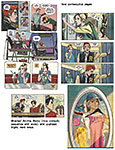
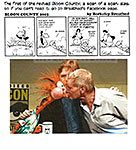
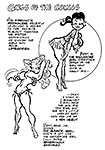

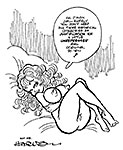

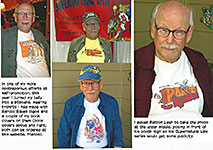
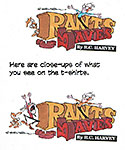
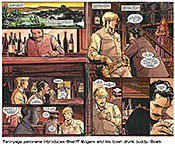
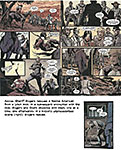
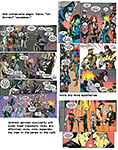
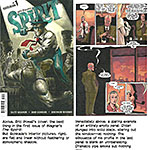
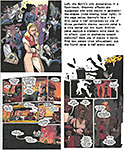
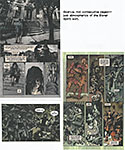

1.jpg)
2.jpg)
3.jpg)
4.jpg)
5.jpg)

6.jpg)
7.jpg)
8.jpg)
9.jpg)
10.jpg)
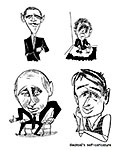
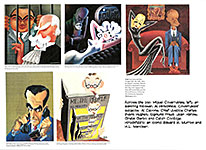
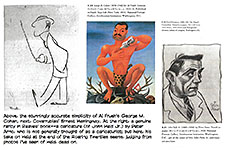
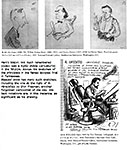
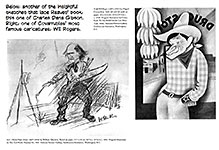
1.jpg)
2.jpg)
3.jpg)
4.jpg)
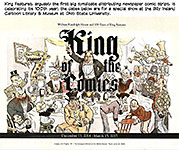

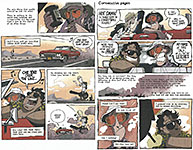
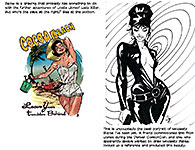

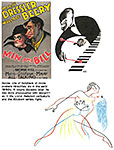
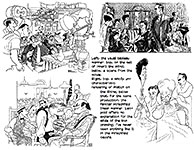

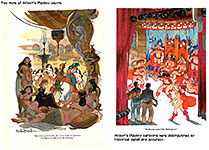
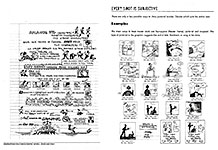

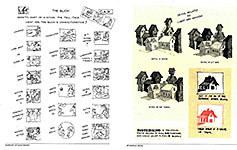
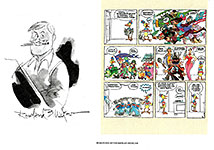
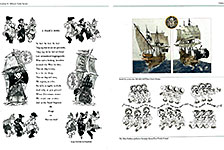

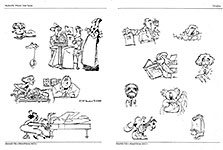
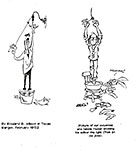

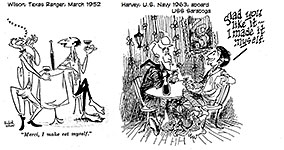
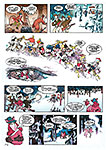
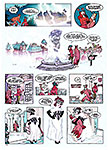
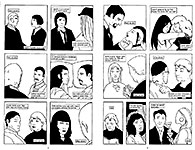
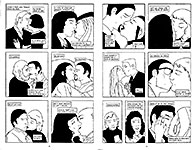
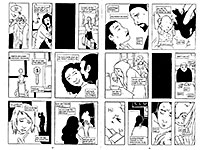
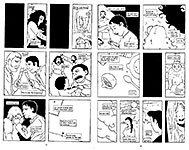
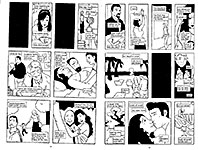
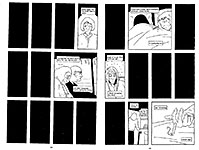

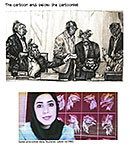
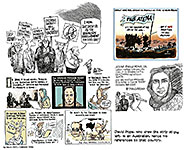


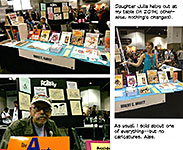
1.jpg)
2.jpg)
3.jpg)
4.jpg)
5.jpg)
6.jpg)
1.jpg)
2.jpg)
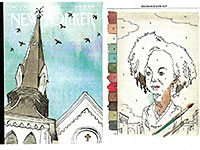
3.jpg)
4.jpg)
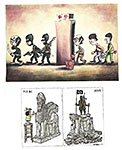
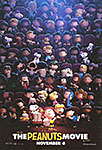
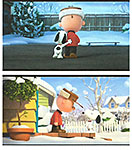
1.jpg)
2.jpg)
3.jpg)
4.jpg)
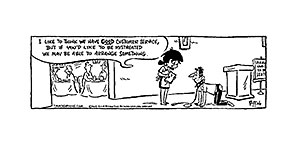
5.jpg)
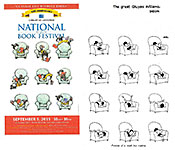
6.jpg)
